Diversification in the Non-Oil Sector of Saudi Arabia: An Analysis of Saudi Vision 2030
VerifiedAdded on 2023/04/26
|64
|16748
|213
AI Summary
This paper analyzes the extent of diversification in the non-oil sector of Saudi Arabia and tests the feasibility of the Saudi Vision 2030. The major source of economic sustenance in Saudi Arabia is the oil sector. However, the recent drop in oil prices has led to the importance of developing alternative means and sources of production. The Saudi Vision 2030 is a plan to reduce the dependency of the Saudi Arabian economy on the oil sector and focus on creating alternative means of production. The paper delves into the presence of market diversification within the non-oil sector and measures the segments that can grow significantly in the near future. The findings show that among the non-oil sector, specifically the financial, insurance and real estate sectors are booming significantly. There is also scope for advancement in other sectors such as construction, telecommunications, storage, wholesale, retail, restaurants and hospitality, manufacturing, government services and transportation.
Contribute Materials
Your contribution can guide someone’s learning journey. Share your
documents today.
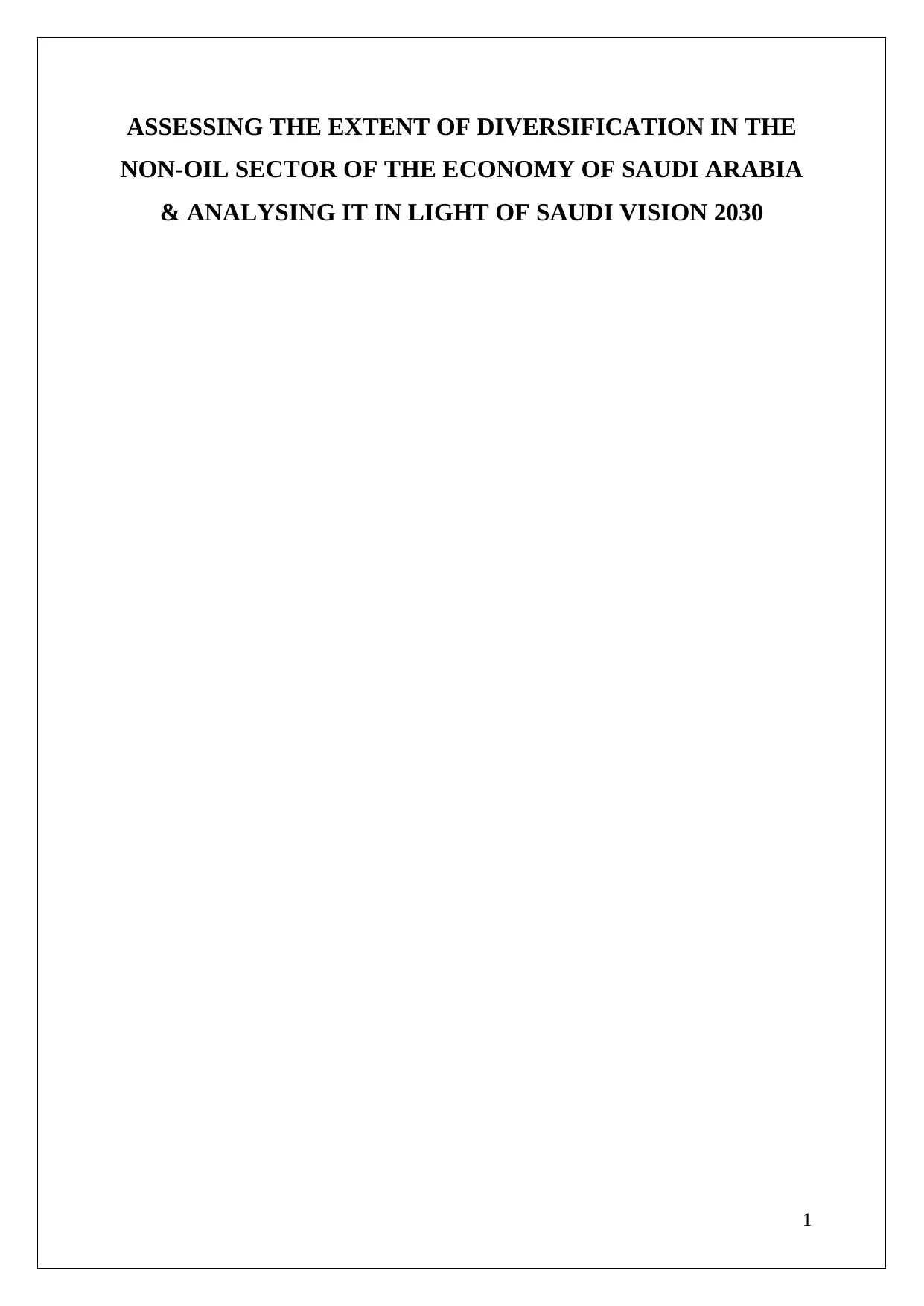
ASSESSING THE EXTENT OF DIVERSIFICATION IN THE
NON-OIL SECTOR OF THE ECONOMY OF SAUDI ARABIA
& ANALYSING IT IN LIGHT OF SAUDI VISION 2030
1
NON-OIL SECTOR OF THE ECONOMY OF SAUDI ARABIA
& ANALYSING IT IN LIGHT OF SAUDI VISION 2030
1
Secure Best Marks with AI Grader
Need help grading? Try our AI Grader for instant feedback on your assignments.
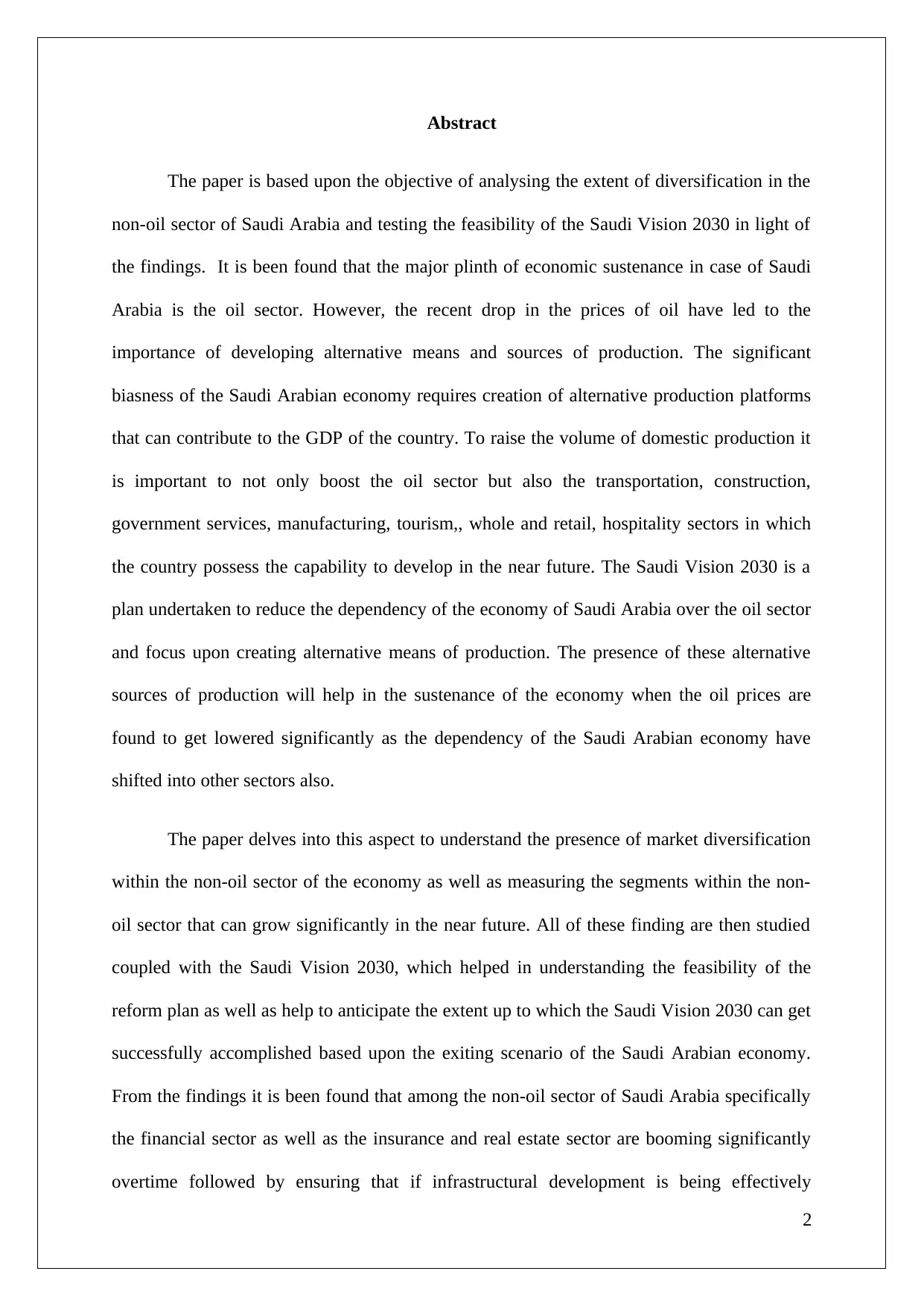
Abstract
The paper is based upon the objective of analysing the extent of diversification in the
non-oil sector of Saudi Arabia and testing the feasibility of the Saudi Vision 2030 in light of
the findings. It is been found that the major plinth of economic sustenance in case of Saudi
Arabia is the oil sector. However, the recent drop in the prices of oil have led to the
importance of developing alternative means and sources of production. The significant
biasness of the Saudi Arabian economy requires creation of alternative production platforms
that can contribute to the GDP of the country. To raise the volume of domestic production it
is important to not only boost the oil sector but also the transportation, construction,
government services, manufacturing, tourism,, whole and retail, hospitality sectors in which
the country possess the capability to develop in the near future. The Saudi Vision 2030 is a
plan undertaken to reduce the dependency of the economy of Saudi Arabia over the oil sector
and focus upon creating alternative means of production. The presence of these alternative
sources of production will help in the sustenance of the economy when the oil prices are
found to get lowered significantly as the dependency of the Saudi Arabian economy have
shifted into other sectors also.
The paper delves into this aspect to understand the presence of market diversification
within the non-oil sector of the economy as well as measuring the segments within the non-
oil sector that can grow significantly in the near future. All of these finding are then studied
coupled with the Saudi Vision 2030, which helped in understanding the feasibility of the
reform plan as well as help to anticipate the extent up to which the Saudi Vision 2030 can get
successfully accomplished based upon the exiting scenario of the Saudi Arabian economy.
From the findings it is been found that among the non-oil sector of Saudi Arabia specifically
the financial sector as well as the insurance and real estate sector are booming significantly
overtime followed by ensuring that if infrastructural development is being effectively
2
The paper is based upon the objective of analysing the extent of diversification in the
non-oil sector of Saudi Arabia and testing the feasibility of the Saudi Vision 2030 in light of
the findings. It is been found that the major plinth of economic sustenance in case of Saudi
Arabia is the oil sector. However, the recent drop in the prices of oil have led to the
importance of developing alternative means and sources of production. The significant
biasness of the Saudi Arabian economy requires creation of alternative production platforms
that can contribute to the GDP of the country. To raise the volume of domestic production it
is important to not only boost the oil sector but also the transportation, construction,
government services, manufacturing, tourism,, whole and retail, hospitality sectors in which
the country possess the capability to develop in the near future. The Saudi Vision 2030 is a
plan undertaken to reduce the dependency of the economy of Saudi Arabia over the oil sector
and focus upon creating alternative means of production. The presence of these alternative
sources of production will help in the sustenance of the economy when the oil prices are
found to get lowered significantly as the dependency of the Saudi Arabian economy have
shifted into other sectors also.
The paper delves into this aspect to understand the presence of market diversification
within the non-oil sector of the economy as well as measuring the segments within the non-
oil sector that can grow significantly in the near future. All of these finding are then studied
coupled with the Saudi Vision 2030, which helped in understanding the feasibility of the
reform plan as well as help to anticipate the extent up to which the Saudi Vision 2030 can get
successfully accomplished based upon the exiting scenario of the Saudi Arabian economy.
From the findings it is been found that among the non-oil sector of Saudi Arabia specifically
the financial sector as well as the insurance and real estate sector are booming significantly
overtime followed by ensuring that if infrastructural development is being effectively
2

incorporated in this sector then there is high probability that these sectors will be able to
contribute significantly to the national GDP of Saudi Arabian economy. Moreover, the output
gap analysis revealed that there is scope of advancement in the construction,
telecommunication, storage, wholesale, retail, restaurants and hospitality, manufacturing,
government services as well as transportation sectors, however, these sectors lacks in
implementation of effective planned strategies. Moreover, another sector that needs both
technological advancement and significant support from the government is the agricultural
sector of Saudi Arabia. On a precise note, it has been found that there is presence of
alternative production platforms that can support the national economy of Saudi Arabia in
accordance with the Saudi Vision 2030 irrespective of the fact that the decline in the oil
prices or oil market crash would not be able to break the economic axis of the country of
Saudi Arabia if and only if these sectors are effectively pioneered towards development.
3
contribute significantly to the national GDP of Saudi Arabian economy. Moreover, the output
gap analysis revealed that there is scope of advancement in the construction,
telecommunication, storage, wholesale, retail, restaurants and hospitality, manufacturing,
government services as well as transportation sectors, however, these sectors lacks in
implementation of effective planned strategies. Moreover, another sector that needs both
technological advancement and significant support from the government is the agricultural
sector of Saudi Arabia. On a precise note, it has been found that there is presence of
alternative production platforms that can support the national economy of Saudi Arabia in
accordance with the Saudi Vision 2030 irrespective of the fact that the decline in the oil
prices or oil market crash would not be able to break the economic axis of the country of
Saudi Arabia if and only if these sectors are effectively pioneered towards development.
3
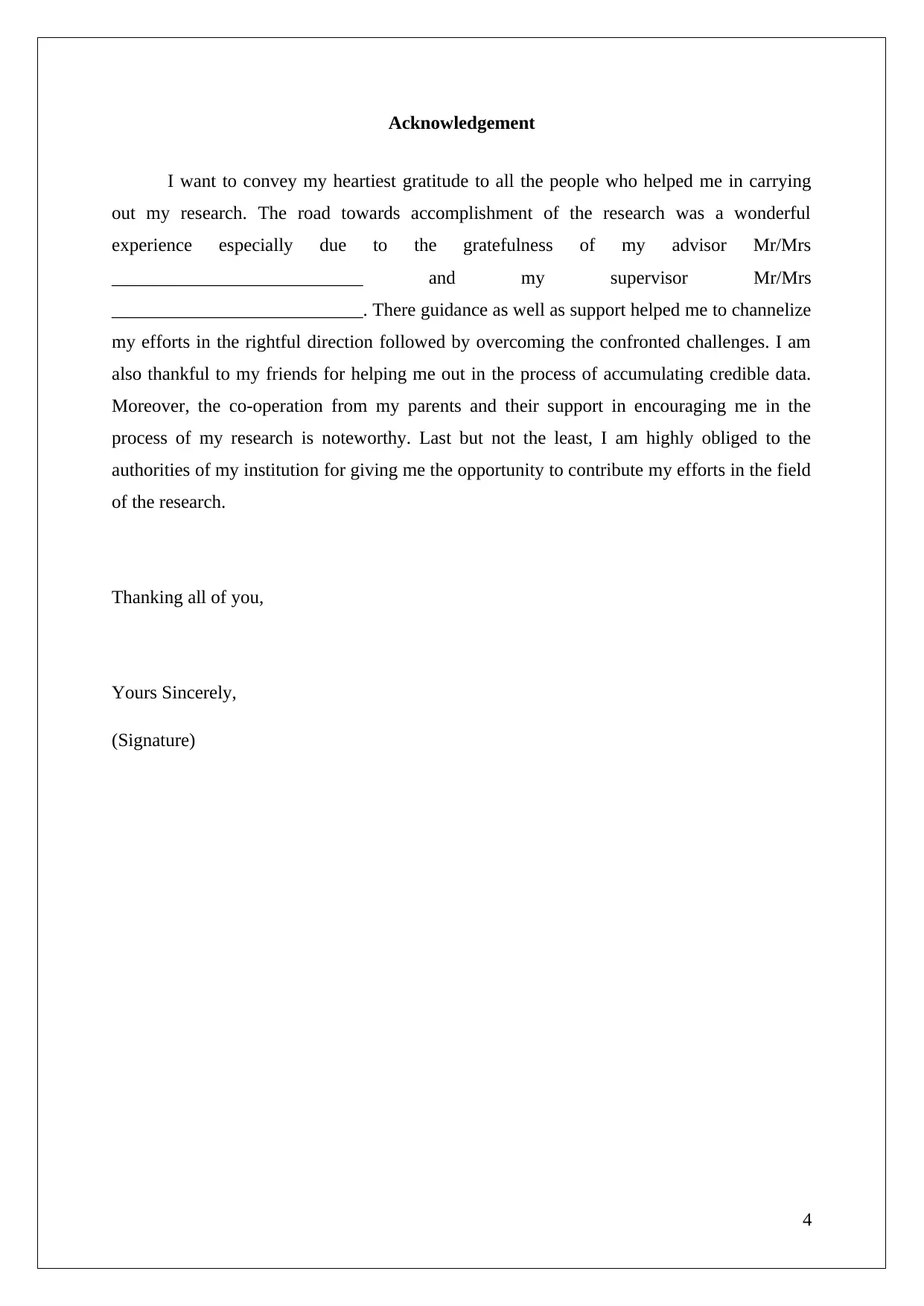
Acknowledgement
I want to convey my heartiest gratitude to all the people who helped me in carrying
out my research. The road towards accomplishment of the research was a wonderful
experience especially due to the gratefulness of my advisor Mr/Mrs
___________________________ and my supervisor Mr/Mrs
___________________________. There guidance as well as support helped me to channelize
my efforts in the rightful direction followed by overcoming the confronted challenges. I am
also thankful to my friends for helping me out in the process of accumulating credible data.
Moreover, the co-operation from my parents and their support in encouraging me in the
process of my research is noteworthy. Last but not the least, I am highly obliged to the
authorities of my institution for giving me the opportunity to contribute my efforts in the field
of the research.
Thanking all of you,
Yours Sincerely,
(Signature)
4
I want to convey my heartiest gratitude to all the people who helped me in carrying
out my research. The road towards accomplishment of the research was a wonderful
experience especially due to the gratefulness of my advisor Mr/Mrs
___________________________ and my supervisor Mr/Mrs
___________________________. There guidance as well as support helped me to channelize
my efforts in the rightful direction followed by overcoming the confronted challenges. I am
also thankful to my friends for helping me out in the process of accumulating credible data.
Moreover, the co-operation from my parents and their support in encouraging me in the
process of my research is noteworthy. Last but not the least, I am highly obliged to the
authorities of my institution for giving me the opportunity to contribute my efforts in the field
of the research.
Thanking all of you,
Yours Sincerely,
(Signature)
4
Secure Best Marks with AI Grader
Need help grading? Try our AI Grader for instant feedback on your assignments.

Table of Contents
Chapter 1: Introduction..............................................................................................................9
1.1 Introduction.....................................................................................................................9
1.2 Background of the Study......................................................................................................9
1.3 Background of the Non-oil Sector of Saudi Arabia...........................................................10
1.4 Rationale of the study.........................................................................................................11
1.5 Problem statement..............................................................................................................12
1.6 Research aim......................................................................................................................12
1.7 Research objectives............................................................................................................12
1.8 Research questions.............................................................................................................13
1.9 Research Hypotheses.........................................................................................................13
1.10 Significance of the study..................................................................................................14
1.11 Structure of the research study.........................................................................................14
Figure 1: Dissertation Structure...........................................................................................14
Chapter 2: Literature Review...................................................................................................15
2.1 Introduction........................................................................................................................15
2.2 Conceptual framework.......................................................................................................15
Figure 2: Conceptual framework.........................................................................................16
2.3 Understanding the general concept of Saudi vision 2030..................................................16
2.4 Various Non-Oil Sectors:...................................................................................................19
5
Chapter 1: Introduction..............................................................................................................9
1.1 Introduction.....................................................................................................................9
1.2 Background of the Study......................................................................................................9
1.3 Background of the Non-oil Sector of Saudi Arabia...........................................................10
1.4 Rationale of the study.........................................................................................................11
1.5 Problem statement..............................................................................................................12
1.6 Research aim......................................................................................................................12
1.7 Research objectives............................................................................................................12
1.8 Research questions.............................................................................................................13
1.9 Research Hypotheses.........................................................................................................13
1.10 Significance of the study..................................................................................................14
1.11 Structure of the research study.........................................................................................14
Figure 1: Dissertation Structure...........................................................................................14
Chapter 2: Literature Review...................................................................................................15
2.1 Introduction........................................................................................................................15
2.2 Conceptual framework.......................................................................................................15
Figure 2: Conceptual framework.........................................................................................16
2.3 Understanding the general concept of Saudi vision 2030..................................................16
2.4 Various Non-Oil Sectors:...................................................................................................19
5
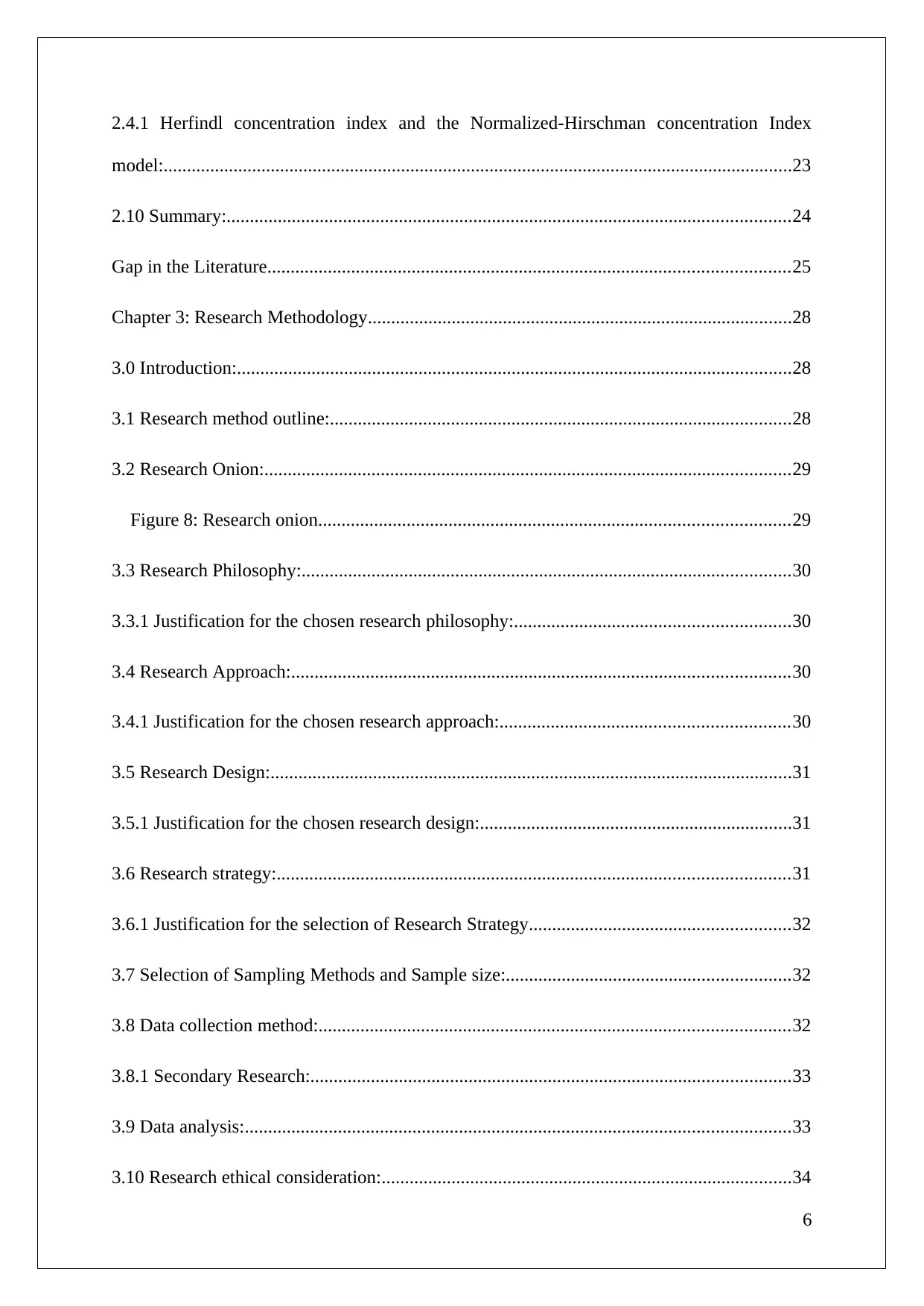
2.4.1 Herfindl concentration index and the Normalized-Hirschman concentration Index
model:.......................................................................................................................................23
2.10 Summary:.........................................................................................................................24
Gap in the Literature................................................................................................................25
Chapter 3: Research Methodology...........................................................................................28
3.0 Introduction:.......................................................................................................................28
3.1 Research method outline:...................................................................................................28
3.2 Research Onion:.................................................................................................................29
Figure 8: Research onion.....................................................................................................29
3.3 Research Philosophy:.........................................................................................................30
3.3.1 Justification for the chosen research philosophy:...........................................................30
3.4 Research Approach:...........................................................................................................30
3.4.1 Justification for the chosen research approach:..............................................................30
3.5 Research Design:................................................................................................................31
3.5.1 Justification for the chosen research design:...................................................................31
3.6 Research strategy:..............................................................................................................31
3.6.1 Justification for the selection of Research Strategy........................................................32
3.7 Selection of Sampling Methods and Sample size:.............................................................32
3.8 Data collection method:.....................................................................................................32
3.8.1 Secondary Research:.......................................................................................................33
3.9 Data analysis:.....................................................................................................................33
3.10 Research ethical consideration:........................................................................................34
6
model:.......................................................................................................................................23
2.10 Summary:.........................................................................................................................24
Gap in the Literature................................................................................................................25
Chapter 3: Research Methodology...........................................................................................28
3.0 Introduction:.......................................................................................................................28
3.1 Research method outline:...................................................................................................28
3.2 Research Onion:.................................................................................................................29
Figure 8: Research onion.....................................................................................................29
3.3 Research Philosophy:.........................................................................................................30
3.3.1 Justification for the chosen research philosophy:...........................................................30
3.4 Research Approach:...........................................................................................................30
3.4.1 Justification for the chosen research approach:..............................................................30
3.5 Research Design:................................................................................................................31
3.5.1 Justification for the chosen research design:...................................................................31
3.6 Research strategy:..............................................................................................................31
3.6.1 Justification for the selection of Research Strategy........................................................32
3.7 Selection of Sampling Methods and Sample size:.............................................................32
3.8 Data collection method:.....................................................................................................32
3.8.1 Secondary Research:.......................................................................................................33
3.9 Data analysis:.....................................................................................................................33
3.10 Research ethical consideration:........................................................................................34
6

3.11. Research limitation:........................................................................................................34
3.12 Time horizon:...................................................................................................................34
3.13 Summary:.........................................................................................................................35
Chapter 4: Presentation of the Data.........................................................................................36
4.1 Introduction:.......................................................................................................................36
4.2 Qualitative Analysis...........................................................................................................36
4.2.1 PESTLE Analysis............................................................................................................36
4.3 Quantitative Analysis.........................................................................................................50
5. Recommendation & Conclusion..........................................................................................54
6. Reference list........................................................................................................................60
7. Appendix 1...........................................................................................................................63
7
3.12 Time horizon:...................................................................................................................34
3.13 Summary:.........................................................................................................................35
Chapter 4: Presentation of the Data.........................................................................................36
4.1 Introduction:.......................................................................................................................36
4.2 Qualitative Analysis...........................................................................................................36
4.2.1 PESTLE Analysis............................................................................................................36
4.3 Quantitative Analysis.........................................................................................................50
5. Recommendation & Conclusion..........................................................................................54
6. Reference list........................................................................................................................60
7. Appendix 1...........................................................................................................................63
7
Paraphrase This Document
Need a fresh take? Get an instant paraphrase of this document with our AI Paraphraser
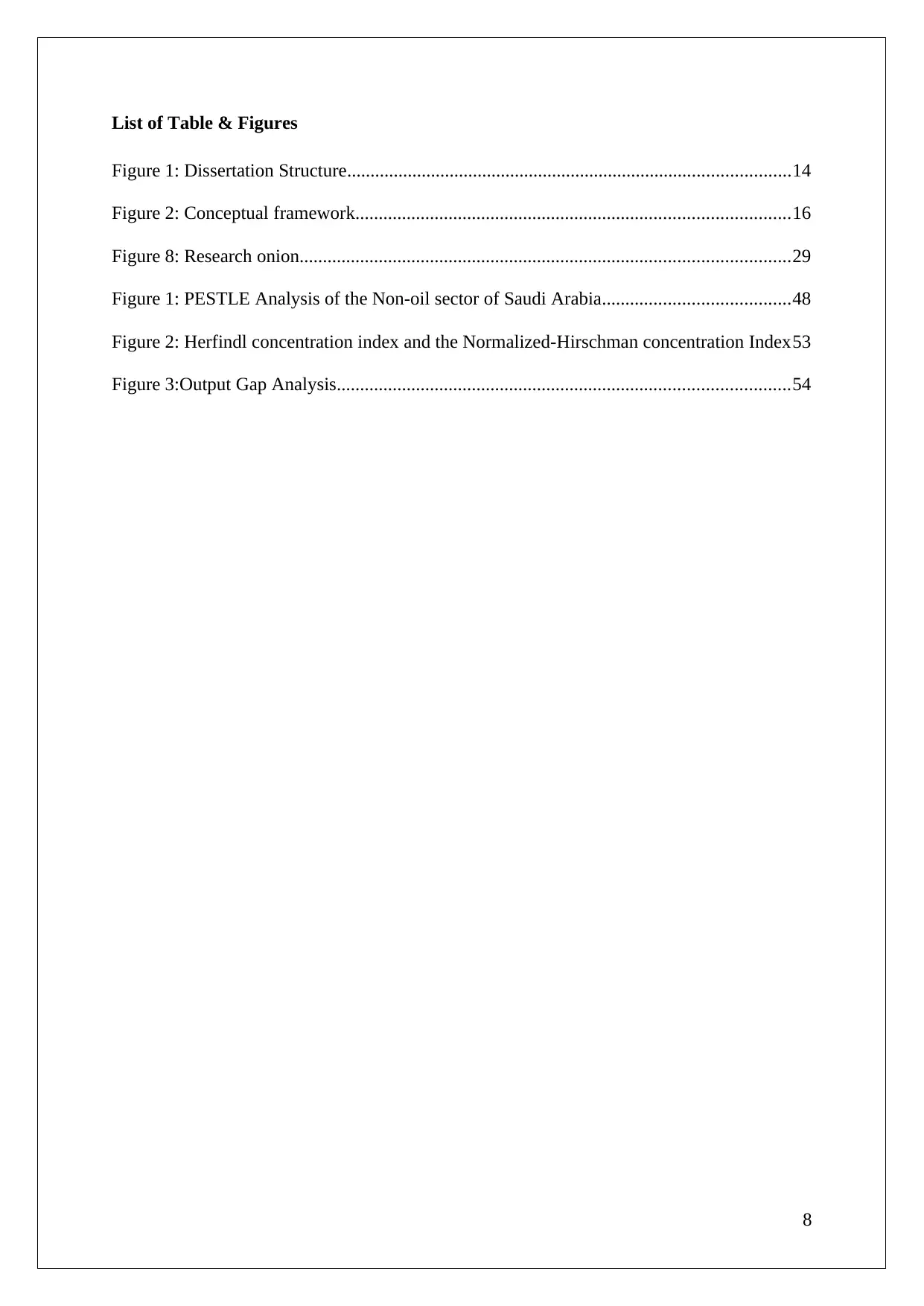
List of Table & Figures
Figure 1: Dissertation Structure...............................................................................................14
Figure 2: Conceptual framework.............................................................................................16
Figure 8: Research onion.........................................................................................................29
Figure 1: PESTLE Analysis of the Non-oil sector of Saudi Arabia........................................48
Figure 2: Herfindl concentration index and the Normalized-Hirschman concentration Index53
Figure 3:Output Gap Analysis.................................................................................................54
8
Figure 1: Dissertation Structure...............................................................................................14
Figure 2: Conceptual framework.............................................................................................16
Figure 8: Research onion.........................................................................................................29
Figure 1: PESTLE Analysis of the Non-oil sector of Saudi Arabia........................................48
Figure 2: Herfindl concentration index and the Normalized-Hirschman concentration Index53
Figure 3:Output Gap Analysis.................................................................................................54
8

Chapter 1: Introduction
1.1 Introduction
The kingdom of Saudi Arabia is the world’s largest holder of the oil resources and
hence the economy preferred to specialise in the production, consumption as well as trade of
oil resources which is of high demand in the global economy due to its scarcity. The
societal development of the country is being boosted through the revenue that are being
earned from the oil sector. The funds acquired through the selling of oil in the international
market and domestic consumption are channelized from to the underdeveloped sectors of the
country. Investments that were being done in those sector helped them to reorganize the non-
oil sectors and initiate new projects can provide a constructive framework of sustainable
growth in the long run. However, the questionable aspect under concern is that the non-oil
sectors are not getting developed as it is expected. They are being funded by the profits
earned through businesses executed by the oil sector domestically and in overseas and this
ensures growth of the non-oil sectors through the funded invested in developmental projects.
However, excessive dependency on the oil sector is ensuring growth in the non-oil sectors by
providence of capital, land and labour but is not able to ensure sustainable development for
the long run in the non-oil sector that will itself be able to generate revenue earning and
raise the country’s GDP followed by supporting other sectors.
This paper aims to understand the new Saudi Vision 2030, related to the diversification
of the non-oil sectors within the country and delves into the factors that impacts upon it. In
order to accomplish the process it is important to identify whether the goals of the plan
undertaken are realistically achievable within the stipulated time frame as well as the best
possible and feasible measures that will be able to actualize the objectives of strengthening
the non-oil sectors of the country substantially.
1.2 Background of the Study
The objective that the country of Saudi Arabia used to remain abided by is to enjoy the
comparative advantage that they have on the commodity oil, but this is leading the economy
towards a special commodity. Notably, it is been seen in the consecutive years of 2014-15,
the price of oil was 107 US dollars per barrel while it dropped to 30 US dollars per barrel by
the beginning of 2016, whereas he latest price of oil by 2019 is 50.6 US dollars
(Indexmundi.com. 2019). If in case oil prices drops in future drastically due to change in
business cycle or economic catastrophes that will pioneer the economy of Saudi Arabia
towards a financial crisis within the country due to its dependency upon the oil sector and
non-availability of alternative business initiatives in other socio-economic segments that will
9
1.1 Introduction
The kingdom of Saudi Arabia is the world’s largest holder of the oil resources and
hence the economy preferred to specialise in the production, consumption as well as trade of
oil resources which is of high demand in the global economy due to its scarcity. The
societal development of the country is being boosted through the revenue that are being
earned from the oil sector. The funds acquired through the selling of oil in the international
market and domestic consumption are channelized from to the underdeveloped sectors of the
country. Investments that were being done in those sector helped them to reorganize the non-
oil sectors and initiate new projects can provide a constructive framework of sustainable
growth in the long run. However, the questionable aspect under concern is that the non-oil
sectors are not getting developed as it is expected. They are being funded by the profits
earned through businesses executed by the oil sector domestically and in overseas and this
ensures growth of the non-oil sectors through the funded invested in developmental projects.
However, excessive dependency on the oil sector is ensuring growth in the non-oil sectors by
providence of capital, land and labour but is not able to ensure sustainable development for
the long run in the non-oil sector that will itself be able to generate revenue earning and
raise the country’s GDP followed by supporting other sectors.
This paper aims to understand the new Saudi Vision 2030, related to the diversification
of the non-oil sectors within the country and delves into the factors that impacts upon it. In
order to accomplish the process it is important to identify whether the goals of the plan
undertaken are realistically achievable within the stipulated time frame as well as the best
possible and feasible measures that will be able to actualize the objectives of strengthening
the non-oil sectors of the country substantially.
1.2 Background of the Study
The objective that the country of Saudi Arabia used to remain abided by is to enjoy the
comparative advantage that they have on the commodity oil, but this is leading the economy
towards a special commodity. Notably, it is been seen in the consecutive years of 2014-15,
the price of oil was 107 US dollars per barrel while it dropped to 30 US dollars per barrel by
the beginning of 2016, whereas he latest price of oil by 2019 is 50.6 US dollars
(Indexmundi.com. 2019). If in case oil prices drops in future drastically due to change in
business cycle or economic catastrophes that will pioneer the economy of Saudi Arabia
towards a financial crisis within the country due to its dependency upon the oil sector and
non-availability of alternative business initiatives in other socio-economic segments that will
9
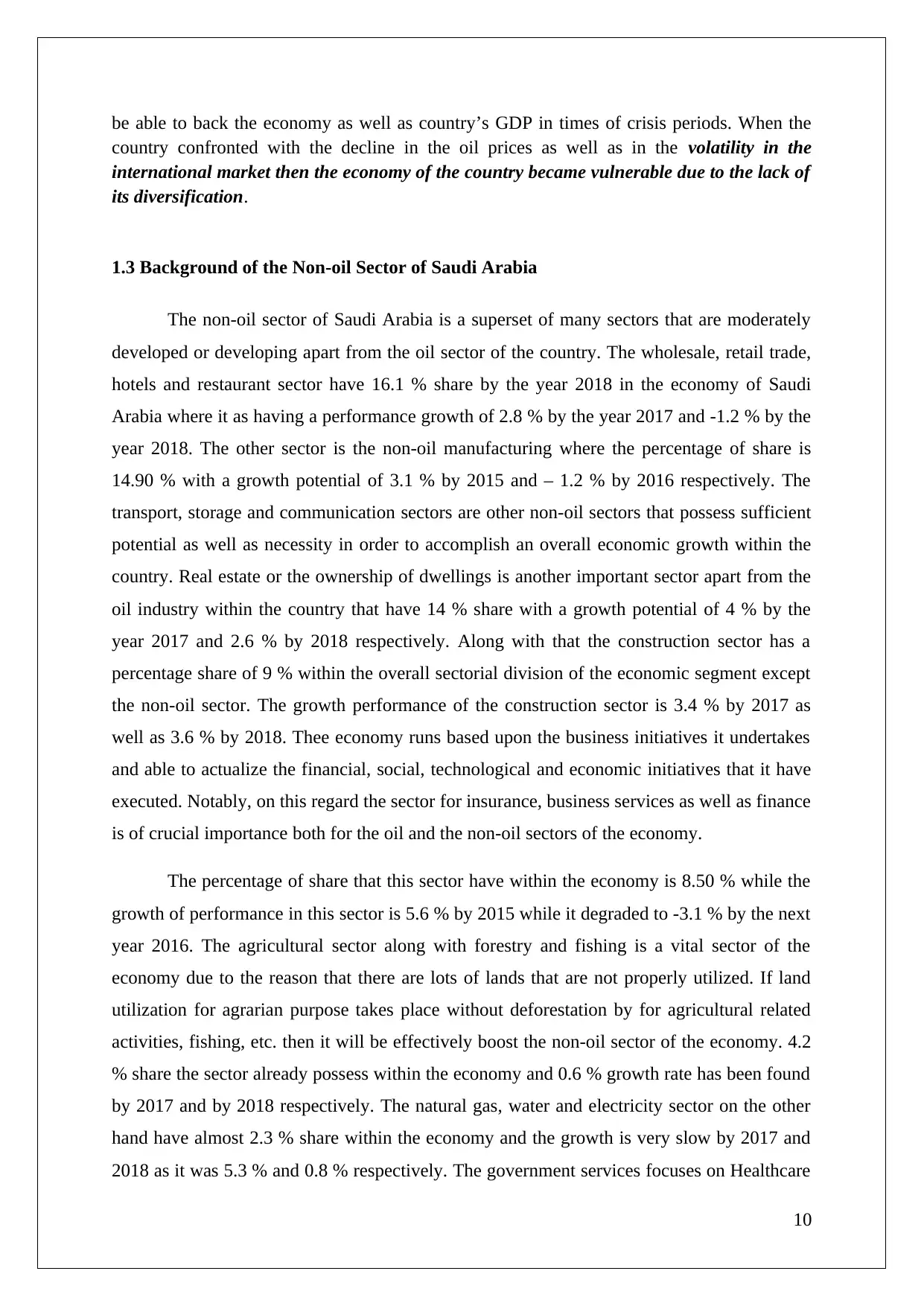
be able to back the economy as well as country’s GDP in times of crisis periods. When the
country confronted with the decline in the oil prices as well as in the volatility in the
international market then the economy of the country became vulnerable due to the lack of
its diversification.
1.3 Background of the Non-oil Sector of Saudi Arabia
The non-oil sector of Saudi Arabia is a superset of many sectors that are moderately
developed or developing apart from the oil sector of the country. The wholesale, retail trade,
hotels and restaurant sector have 16.1 % share by the year 2018 in the economy of Saudi
Arabia where it as having a performance growth of 2.8 % by the year 2017 and -1.2 % by the
year 2018. The other sector is the non-oil manufacturing where the percentage of share is
14.90 % with a growth potential of 3.1 % by 2015 and – 1.2 % by 2016 respectively. The
transport, storage and communication sectors are other non-oil sectors that possess sufficient
potential as well as necessity in order to accomplish an overall economic growth within the
country. Real estate or the ownership of dwellings is another important sector apart from the
oil industry within the country that have 14 % share with a growth potential of 4 % by the
year 2017 and 2.6 % by 2018 respectively. Along with that the construction sector has a
percentage share of 9 % within the overall sectorial division of the economic segment except
the non-oil sector. The growth performance of the construction sector is 3.4 % by 2017 as
well as 3.6 % by 2018. Thee economy runs based upon the business initiatives it undertakes
and able to actualize the financial, social, technological and economic initiatives that it have
executed. Notably, on this regard the sector for insurance, business services as well as finance
is of crucial importance both for the oil and the non-oil sectors of the economy.
The percentage of share that this sector have within the economy is 8.50 % while the
growth of performance in this sector is 5.6 % by 2015 while it degraded to -3.1 % by the next
year 2016. The agricultural sector along with forestry and fishing is a vital sector of the
economy due to the reason that there are lots of lands that are not properly utilized. If land
utilization for agrarian purpose takes place without deforestation by for agricultural related
activities, fishing, etc. then it will be effectively boost the non-oil sector of the economy. 4.2
% share the sector already possess within the economy and 0.6 % growth rate has been found
by 2017 and by 2018 respectively. The natural gas, water and electricity sector on the other
hand have almost 2.3 % share within the economy and the growth is very slow by 2017 and
2018 as it was 5.3 % and 0.8 % respectively. The government services focuses on Healthcare
10
country confronted with the decline in the oil prices as well as in the volatility in the
international market then the economy of the country became vulnerable due to the lack of
its diversification.
1.3 Background of the Non-oil Sector of Saudi Arabia
The non-oil sector of Saudi Arabia is a superset of many sectors that are moderately
developed or developing apart from the oil sector of the country. The wholesale, retail trade,
hotels and restaurant sector have 16.1 % share by the year 2018 in the economy of Saudi
Arabia where it as having a performance growth of 2.8 % by the year 2017 and -1.2 % by the
year 2018. The other sector is the non-oil manufacturing where the percentage of share is
14.90 % with a growth potential of 3.1 % by 2015 and – 1.2 % by 2016 respectively. The
transport, storage and communication sectors are other non-oil sectors that possess sufficient
potential as well as necessity in order to accomplish an overall economic growth within the
country. Real estate or the ownership of dwellings is another important sector apart from the
oil industry within the country that have 14 % share with a growth potential of 4 % by the
year 2017 and 2.6 % by 2018 respectively. Along with that the construction sector has a
percentage share of 9 % within the overall sectorial division of the economic segment except
the non-oil sector. The growth performance of the construction sector is 3.4 % by 2017 as
well as 3.6 % by 2018. Thee economy runs based upon the business initiatives it undertakes
and able to actualize the financial, social, technological and economic initiatives that it have
executed. Notably, on this regard the sector for insurance, business services as well as finance
is of crucial importance both for the oil and the non-oil sectors of the economy.
The percentage of share that this sector have within the economy is 8.50 % while the
growth of performance in this sector is 5.6 % by 2015 while it degraded to -3.1 % by the next
year 2016. The agricultural sector along with forestry and fishing is a vital sector of the
economy due to the reason that there are lots of lands that are not properly utilized. If land
utilization for agrarian purpose takes place without deforestation by for agricultural related
activities, fishing, etc. then it will be effectively boost the non-oil sector of the economy. 4.2
% share the sector already possess within the economy and 0.6 % growth rate has been found
by 2017 and by 2018 respectively. The natural gas, water and electricity sector on the other
hand have almost 2.3 % share within the economy and the growth is very slow by 2017 and
2018 as it was 5.3 % and 0.8 % respectively. The government services focuses on Healthcare
10
Secure Best Marks with AI Grader
Need help grading? Try our AI Grader for instant feedback on your assignments.

with 24.90 % off share within the economy and the performance growth of 2.3 % by 2016
and 0.3 % of 2017. The non-oil mining and quarrying sector have 0.70 % share with a
retarded growth performance of 4.1 % by 2017 to 2.9 % by 2016. This are the existing
scenario prevailing in the non-oil sector of the economy of Saudi Arabia which needs to be
addressed in order to boost these sectors and to ensure that the sole dependency of the
country only upon oil gets reduced.
1.4 Rationale of the study
The issue under consideration is to accomplish a research regarding the economic
development and social restructuring of the economy of Saudi Arabia which is found to be
dependent sufficiently upon the oil sector of the country due to the reason that it is one of the
most demanded commodity throughout the world as well as Saudi Arabia is the largest
exporter of oil. The country have a significant amount of oil resources and due to this reason
years after years it have preferred to specialize themselves in the production and trade of oil.
It is a great source for their revenue earning and economic strengthening of the country.
However this lead to the fact that the country become solely dependent upon the production
of oil only and other sectors like transportation, agriculture, non-oil mining, quarrying,
healthcare, electricity, water, gas, financial services, insurance, retail, wholesale,
communication, information technology, hotel, restaurant, real estate, storage, etc. sectors do
not getting developed as compared to that of the oil sector. Creating spaces for developing the
other sectors beside the oil sector will boost the overall economic condition of the country
designing alternative means of production as well as alternative source of revenue generation.
As it is being found that after consecutive price shocks in the market value of oil, the
result have led to lower revenue earning from the selling of petroleum as well as its
complementary products too. The same amount of oil that when sold by 2014 was priced by
107 US dollar per barrel though now by 2019 it cost nearby $ 50.5 per barrel. Such price drop
is able to earn half of the revenue by selling the same amount of oil compared to that it was
previously earning. Thus the GDP earned from the oil sector is lowered. However, the
revenue earning is still high as compared to other countries that have less absolute advantage
in the export of oil compared to that of Saudi Arabia yet the better choice for Saudi Arabia in
order to sustain at the same level of revenue generation requires the development of
alternative sectors in the country that will not only remove their dependency over oil only but
11
and 0.3 % of 2017. The non-oil mining and quarrying sector have 0.70 % share with a
retarded growth performance of 4.1 % by 2017 to 2.9 % by 2016. This are the existing
scenario prevailing in the non-oil sector of the economy of Saudi Arabia which needs to be
addressed in order to boost these sectors and to ensure that the sole dependency of the
country only upon oil gets reduced.
1.4 Rationale of the study
The issue under consideration is to accomplish a research regarding the economic
development and social restructuring of the economy of Saudi Arabia which is found to be
dependent sufficiently upon the oil sector of the country due to the reason that it is one of the
most demanded commodity throughout the world as well as Saudi Arabia is the largest
exporter of oil. The country have a significant amount of oil resources and due to this reason
years after years it have preferred to specialize themselves in the production and trade of oil.
It is a great source for their revenue earning and economic strengthening of the country.
However this lead to the fact that the country become solely dependent upon the production
of oil only and other sectors like transportation, agriculture, non-oil mining, quarrying,
healthcare, electricity, water, gas, financial services, insurance, retail, wholesale,
communication, information technology, hotel, restaurant, real estate, storage, etc. sectors do
not getting developed as compared to that of the oil sector. Creating spaces for developing the
other sectors beside the oil sector will boost the overall economic condition of the country
designing alternative means of production as well as alternative source of revenue generation.
As it is being found that after consecutive price shocks in the market value of oil, the
result have led to lower revenue earning from the selling of petroleum as well as its
complementary products too. The same amount of oil that when sold by 2014 was priced by
107 US dollar per barrel though now by 2019 it cost nearby $ 50.5 per barrel. Such price drop
is able to earn half of the revenue by selling the same amount of oil compared to that it was
previously earning. Thus the GDP earned from the oil sector is lowered. However, the
revenue earning is still high as compared to other countries that have less absolute advantage
in the export of oil compared to that of Saudi Arabia yet the better choice for Saudi Arabia in
order to sustain at the same level of revenue generation requires the development of
alternative sectors in the country that will not only remove their dependency over oil only but
11
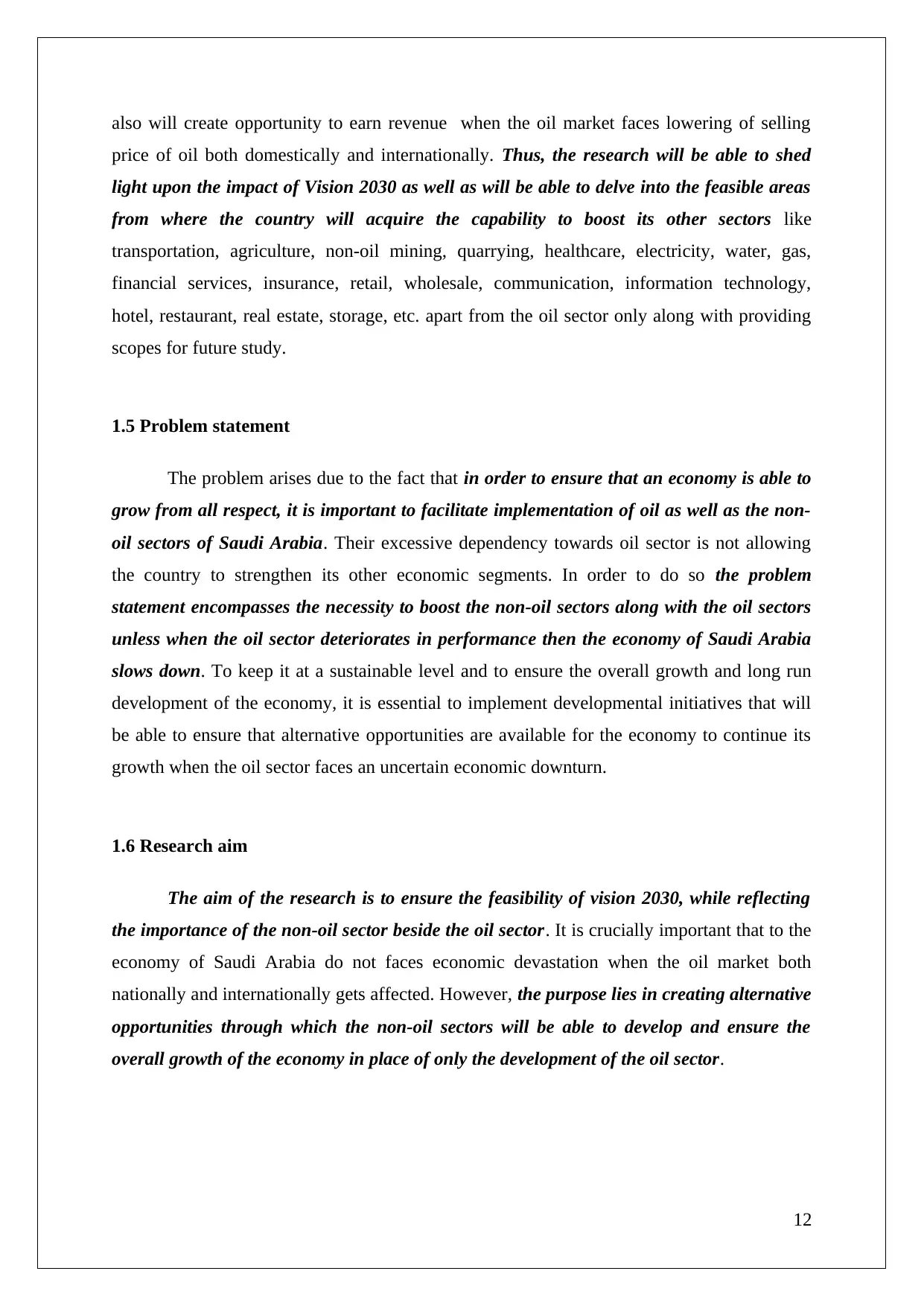
also will create opportunity to earn revenue when the oil market faces lowering of selling
price of oil both domestically and internationally. Thus, the research will be able to shed
light upon the impact of Vision 2030 as well as will be able to delve into the feasible areas
from where the country will acquire the capability to boost its other sectors like
transportation, agriculture, non-oil mining, quarrying, healthcare, electricity, water, gas,
financial services, insurance, retail, wholesale, communication, information technology,
hotel, restaurant, real estate, storage, etc. apart from the oil sector only along with providing
scopes for future study.
1.5 Problem statement
The problem arises due to the fact that in order to ensure that an economy is able to
grow from all respect, it is important to facilitate implementation of oil as well as the non-
oil sectors of Saudi Arabia. Their excessive dependency towards oil sector is not allowing
the country to strengthen its other economic segments. In order to do so the problem
statement encompasses the necessity to boost the non-oil sectors along with the oil sectors
unless when the oil sector deteriorates in performance then the economy of Saudi Arabia
slows down. To keep it at a sustainable level and to ensure the overall growth and long run
development of the economy, it is essential to implement developmental initiatives that will
be able to ensure that alternative opportunities are available for the economy to continue its
growth when the oil sector faces an uncertain economic downturn.
1.6 Research aim
The aim of the research is to ensure the feasibility of vision 2030, while reflecting
the importance of the non-oil sector beside the oil sector. It is crucially important that to the
economy of Saudi Arabia do not faces economic devastation when the oil market both
nationally and internationally gets affected. However, the purpose lies in creating alternative
opportunities through which the non-oil sectors will be able to develop and ensure the
overall growth of the economy in place of only the development of the oil sector.
12
price of oil both domestically and internationally. Thus, the research will be able to shed
light upon the impact of Vision 2030 as well as will be able to delve into the feasible areas
from where the country will acquire the capability to boost its other sectors like
transportation, agriculture, non-oil mining, quarrying, healthcare, electricity, water, gas,
financial services, insurance, retail, wholesale, communication, information technology,
hotel, restaurant, real estate, storage, etc. apart from the oil sector only along with providing
scopes for future study.
1.5 Problem statement
The problem arises due to the fact that in order to ensure that an economy is able to
grow from all respect, it is important to facilitate implementation of oil as well as the non-
oil sectors of Saudi Arabia. Their excessive dependency towards oil sector is not allowing
the country to strengthen its other economic segments. In order to do so the problem
statement encompasses the necessity to boost the non-oil sectors along with the oil sectors
unless when the oil sector deteriorates in performance then the economy of Saudi Arabia
slows down. To keep it at a sustainable level and to ensure the overall growth and long run
development of the economy, it is essential to implement developmental initiatives that will
be able to ensure that alternative opportunities are available for the economy to continue its
growth when the oil sector faces an uncertain economic downturn.
1.6 Research aim
The aim of the research is to ensure the feasibility of vision 2030, while reflecting
the importance of the non-oil sector beside the oil sector. It is crucially important that to the
economy of Saudi Arabia do not faces economic devastation when the oil market both
nationally and internationally gets affected. However, the purpose lies in creating alternative
opportunities through which the non-oil sectors will be able to develop and ensure the
overall growth of the economy in place of only the development of the oil sector.
12
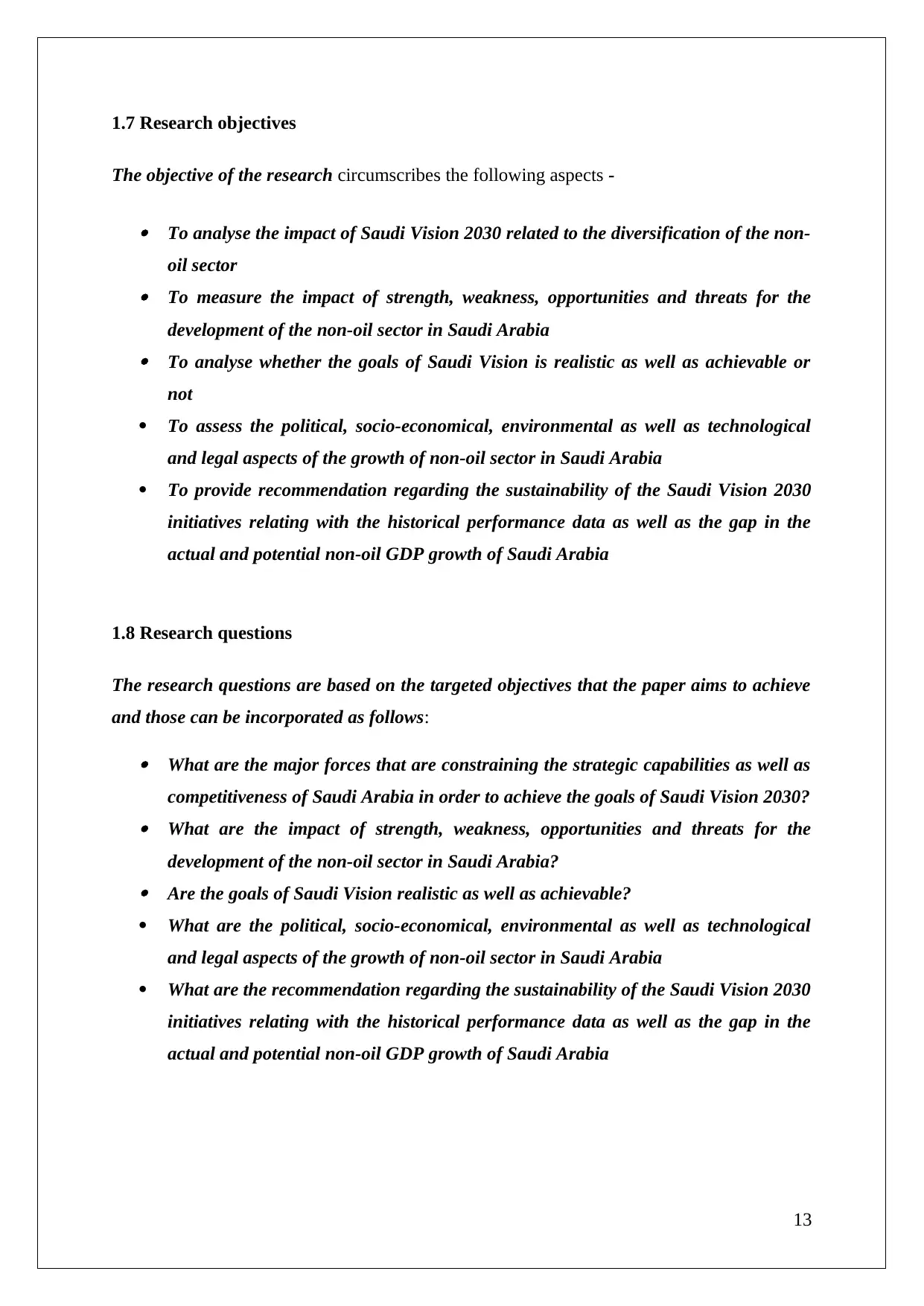
1.7 Research objectives
The objective of the research circumscribes the following aspects -
To analyse the impact of Saudi Vision 2030 related to the diversification of the non-
oil sector To measure the impact of strength, weakness, opportunities and threats for the
development of the non-oil sector in Saudi Arabia To analyse whether the goals of Saudi Vision is realistic as well as achievable or
not
To assess the political, socio-economical, environmental as well as technological
and legal aspects of the growth of non-oil sector in Saudi Arabia
To provide recommendation regarding the sustainability of the Saudi Vision 2030
initiatives relating with the historical performance data as well as the gap in the
actual and potential non-oil GDP growth of Saudi Arabia
1.8 Research questions
The research questions are based on the targeted objectives that the paper aims to achieve
and those can be incorporated as follows:
What are the major forces that are constraining the strategic capabilities as well as
competitiveness of Saudi Arabia in order to achieve the goals of Saudi Vision 2030? What are the impact of strength, weakness, opportunities and threats for the
development of the non-oil sector in Saudi Arabia? Are the goals of Saudi Vision realistic as well as achievable?
What are the political, socio-economical, environmental as well as technological
and legal aspects of the growth of non-oil sector in Saudi Arabia
What are the recommendation regarding the sustainability of the Saudi Vision 2030
initiatives relating with the historical performance data as well as the gap in the
actual and potential non-oil GDP growth of Saudi Arabia
13
The objective of the research circumscribes the following aspects -
To analyse the impact of Saudi Vision 2030 related to the diversification of the non-
oil sector To measure the impact of strength, weakness, opportunities and threats for the
development of the non-oil sector in Saudi Arabia To analyse whether the goals of Saudi Vision is realistic as well as achievable or
not
To assess the political, socio-economical, environmental as well as technological
and legal aspects of the growth of non-oil sector in Saudi Arabia
To provide recommendation regarding the sustainability of the Saudi Vision 2030
initiatives relating with the historical performance data as well as the gap in the
actual and potential non-oil GDP growth of Saudi Arabia
1.8 Research questions
The research questions are based on the targeted objectives that the paper aims to achieve
and those can be incorporated as follows:
What are the major forces that are constraining the strategic capabilities as well as
competitiveness of Saudi Arabia in order to achieve the goals of Saudi Vision 2030? What are the impact of strength, weakness, opportunities and threats for the
development of the non-oil sector in Saudi Arabia? Are the goals of Saudi Vision realistic as well as achievable?
What are the political, socio-economical, environmental as well as technological
and legal aspects of the growth of non-oil sector in Saudi Arabia
What are the recommendation regarding the sustainability of the Saudi Vision 2030
initiatives relating with the historical performance data as well as the gap in the
actual and potential non-oil GDP growth of Saudi Arabia
13
Paraphrase This Document
Need a fresh take? Get an instant paraphrase of this document with our AI Paraphraser
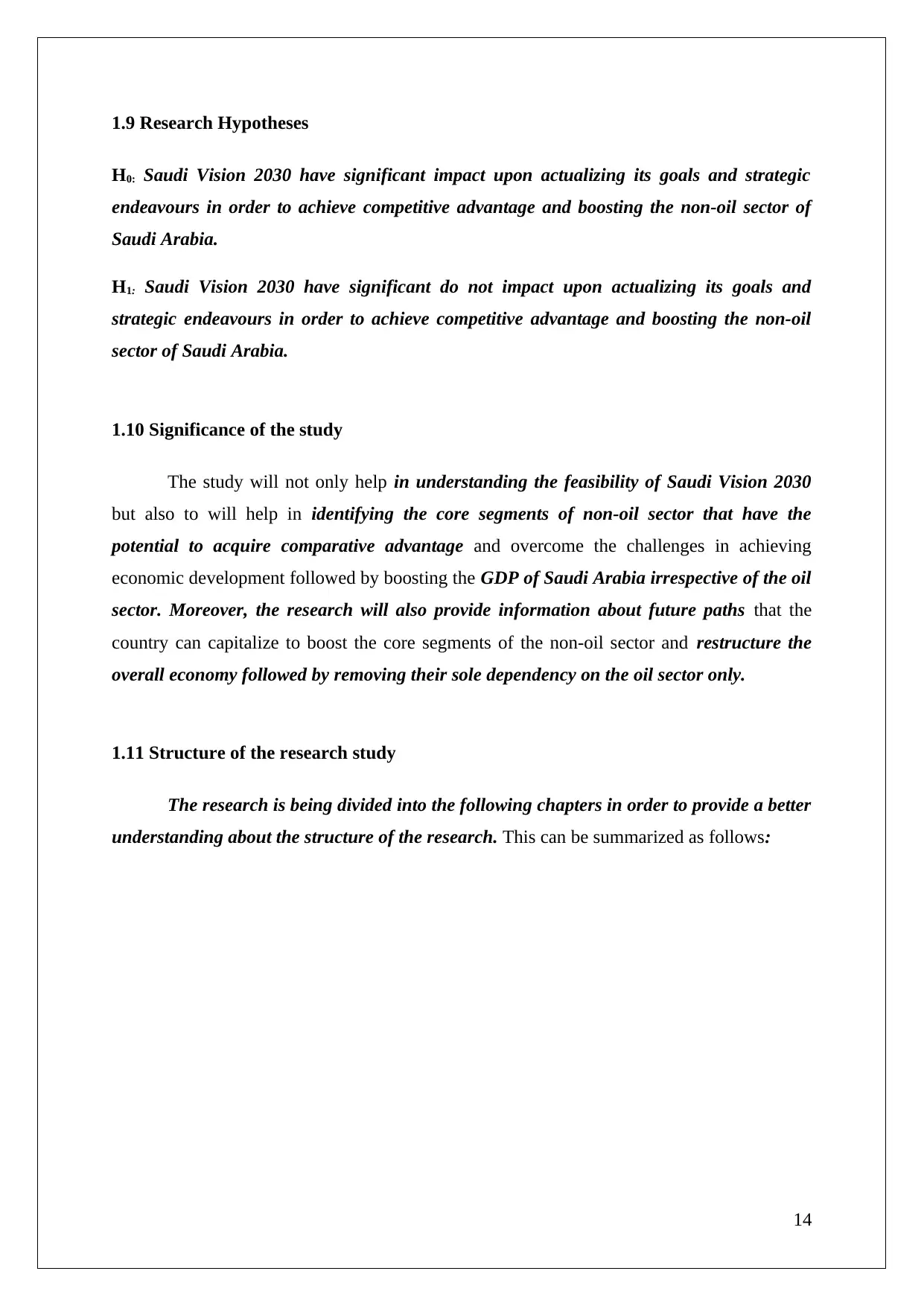
1.9 Research Hypotheses
H0: Saudi Vision 2030 have significant impact upon actualizing its goals and strategic
endeavours in order to achieve competitive advantage and boosting the non-oil sector of
Saudi Arabia.
H1: Saudi Vision 2030 have significant do not impact upon actualizing its goals and
strategic endeavours in order to achieve competitive advantage and boosting the non-oil
sector of Saudi Arabia.
1.10 Significance of the study
The study will not only help in understanding the feasibility of Saudi Vision 2030
but also to will help in identifying the core segments of non-oil sector that have the
potential to acquire comparative advantage and overcome the challenges in achieving
economic development followed by boosting the GDP of Saudi Arabia irrespective of the oil
sector. Moreover, the research will also provide information about future paths that the
country can capitalize to boost the core segments of the non-oil sector and restructure the
overall economy followed by removing their sole dependency on the oil sector only.
1.11 Structure of the research study
The research is being divided into the following chapters in order to provide a better
understanding about the structure of the research. This can be summarized as follows:
14
H0: Saudi Vision 2030 have significant impact upon actualizing its goals and strategic
endeavours in order to achieve competitive advantage and boosting the non-oil sector of
Saudi Arabia.
H1: Saudi Vision 2030 have significant do not impact upon actualizing its goals and
strategic endeavours in order to achieve competitive advantage and boosting the non-oil
sector of Saudi Arabia.
1.10 Significance of the study
The study will not only help in understanding the feasibility of Saudi Vision 2030
but also to will help in identifying the core segments of non-oil sector that have the
potential to acquire comparative advantage and overcome the challenges in achieving
economic development followed by boosting the GDP of Saudi Arabia irrespective of the oil
sector. Moreover, the research will also provide information about future paths that the
country can capitalize to boost the core segments of the non-oil sector and restructure the
overall economy followed by removing their sole dependency on the oil sector only.
1.11 Structure of the research study
The research is being divided into the following chapters in order to provide a better
understanding about the structure of the research. This can be summarized as follows:
14
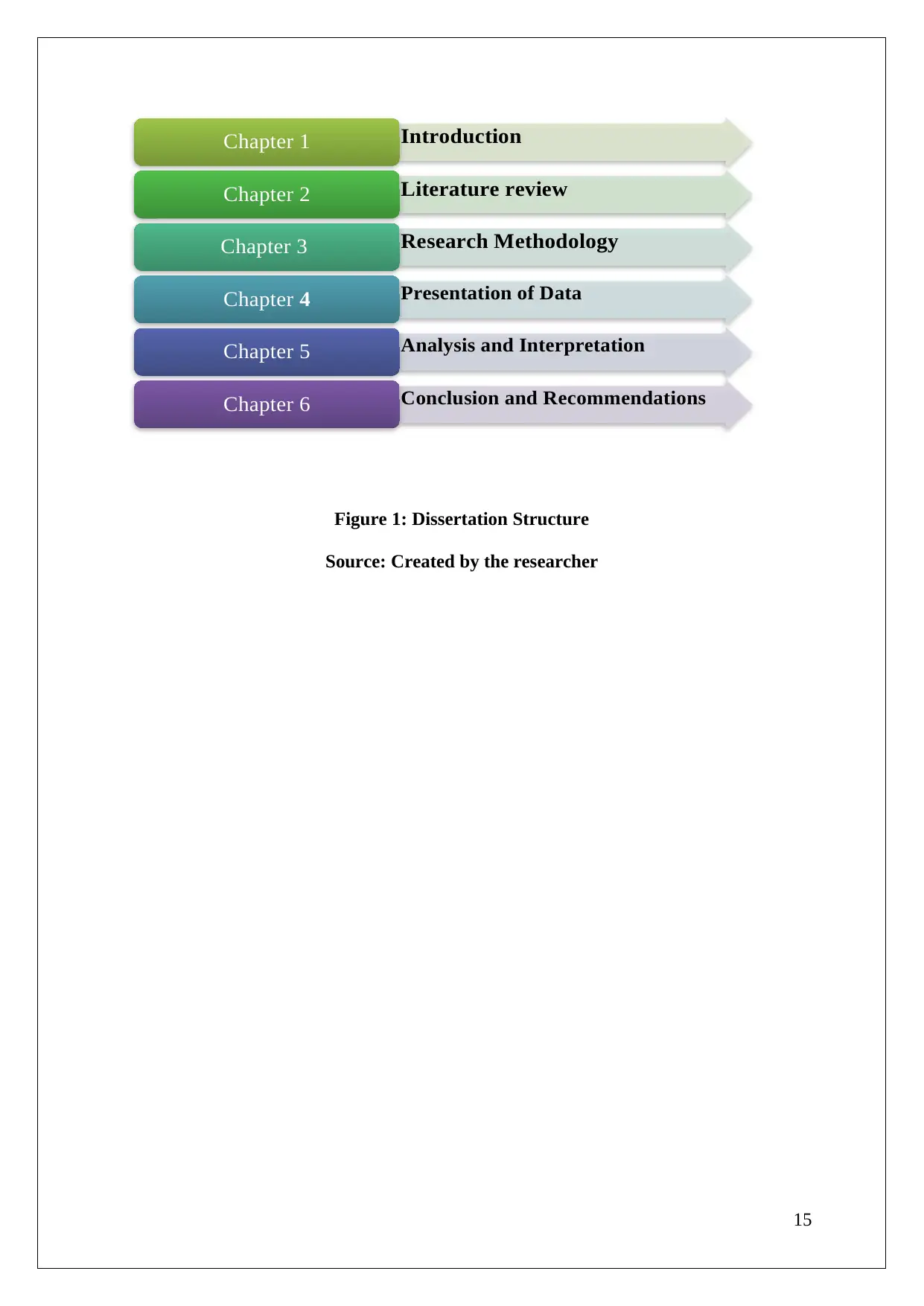
Figure 1: Dissertation Structure
Source: Created by the researcher
15
IntroductionChapter 1
Literature reviewChapter 2
Research MethodologyChapter 3
Presentation of DataChapter 4
Analysis and InterpretationChapter 5
Conclusion and RecommendationsChapter 6
Source: Created by the researcher
15
IntroductionChapter 1
Literature reviewChapter 2
Research MethodologyChapter 3
Presentation of DataChapter 4
Analysis and InterpretationChapter 5
Conclusion and RecommendationsChapter 6
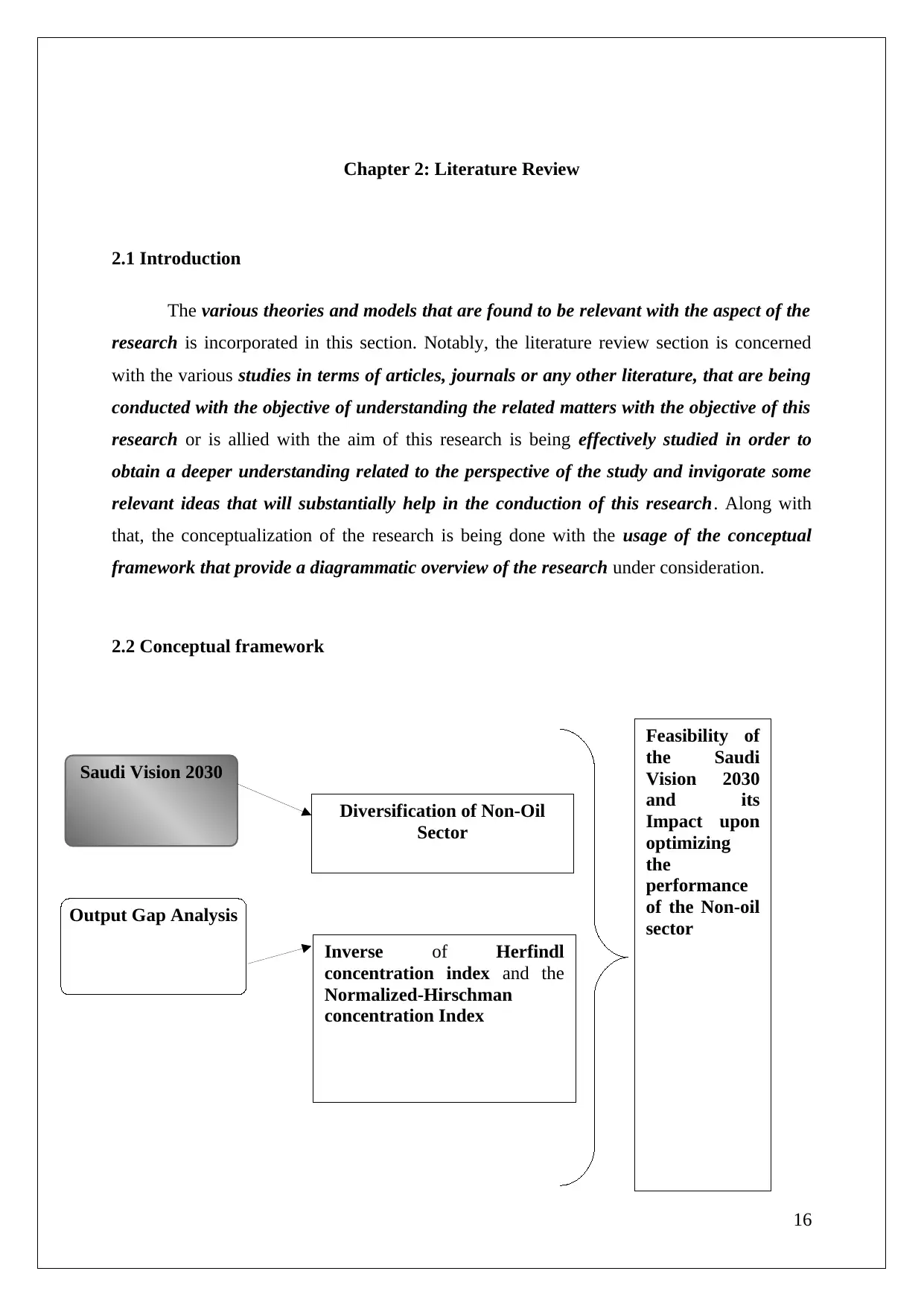
Saudi Vision 2030
Output Gap Analysis
Diversification of Non-Oil
Sector
Inverse of Herfindl
concentration index and the
Normalized-Hirschman
concentration Index
Feasibility of
the Saudi
Vision 2030
and its
Impact upon
optimizing
the
performance
of the Non-oil
sector
Chapter 2: Literature Review
2.1 Introduction
The various theories and models that are found to be relevant with the aspect of the
research is incorporated in this section. Notably, the literature review section is concerned
with the various studies in terms of articles, journals or any other literature, that are being
conducted with the objective of understanding the related matters with the objective of this
research or is allied with the aim of this research is being effectively studied in order to
obtain a deeper understanding related to the perspective of the study and invigorate some
relevant ideas that will substantially help in the conduction of this research. Along with
that, the conceptualization of the research is being done with the usage of the conceptual
framework that provide a diagrammatic overview of the research under consideration.
2.2 Conceptual framework
16
Output Gap Analysis
Diversification of Non-Oil
Sector
Inverse of Herfindl
concentration index and the
Normalized-Hirschman
concentration Index
Feasibility of
the Saudi
Vision 2030
and its
Impact upon
optimizing
the
performance
of the Non-oil
sector
Chapter 2: Literature Review
2.1 Introduction
The various theories and models that are found to be relevant with the aspect of the
research is incorporated in this section. Notably, the literature review section is concerned
with the various studies in terms of articles, journals or any other literature, that are being
conducted with the objective of understanding the related matters with the objective of this
research or is allied with the aim of this research is being effectively studied in order to
obtain a deeper understanding related to the perspective of the study and invigorate some
relevant ideas that will substantially help in the conduction of this research. Along with
that, the conceptualization of the research is being done with the usage of the conceptual
framework that provide a diagrammatic overview of the research under consideration.
2.2 Conceptual framework
16
Secure Best Marks with AI Grader
Need help grading? Try our AI Grader for instant feedback on your assignments.
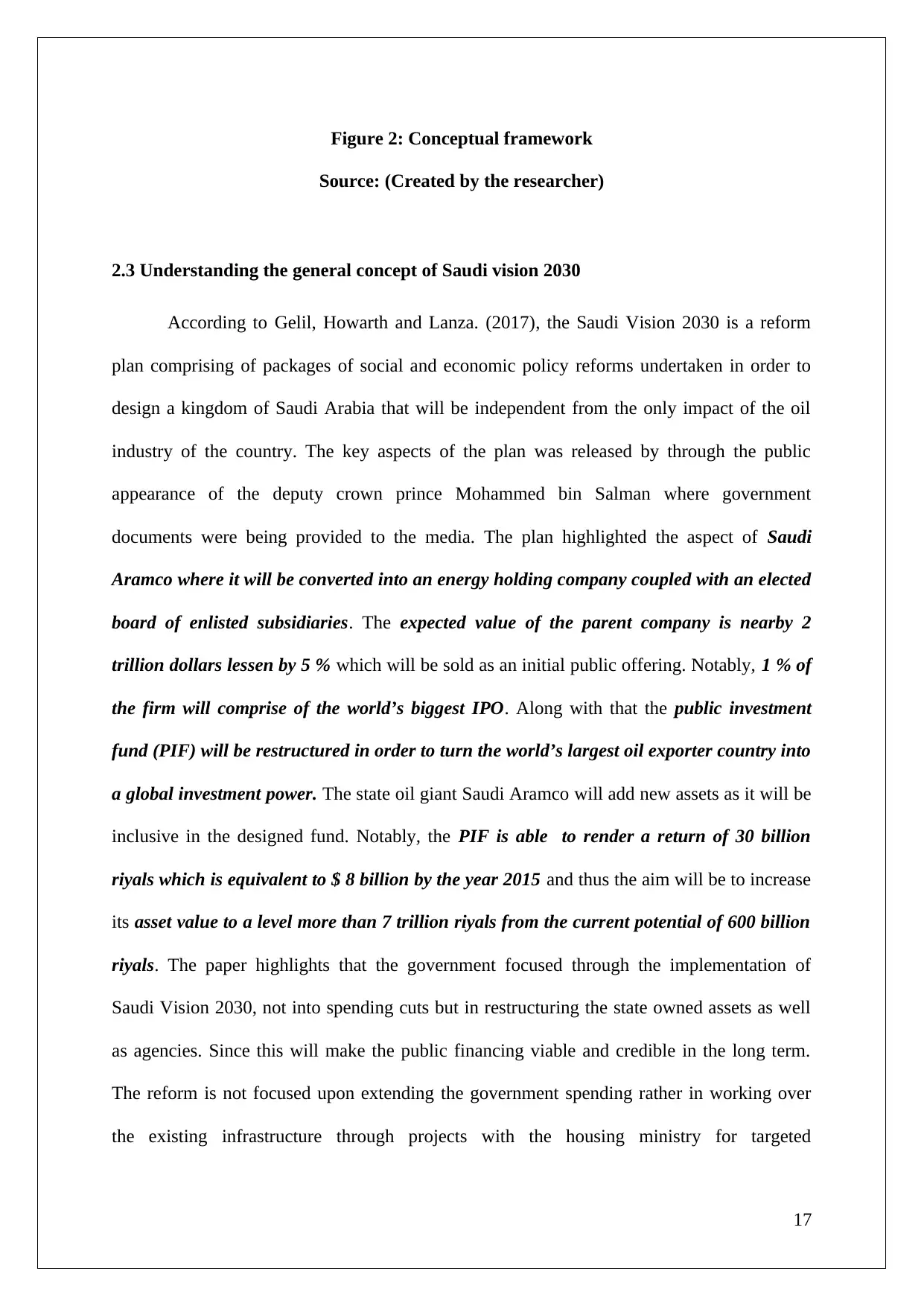
Figure 2: Conceptual framework
Source: (Created by the researcher)
2.3 Understanding the general concept of Saudi vision 2030
According to Gelil, Howarth and Lanza. (2017), the Saudi Vision 2030 is a reform
plan comprising of packages of social and economic policy reforms undertaken in order to
design a kingdom of Saudi Arabia that will be independent from the only impact of the oil
industry of the country. The key aspects of the plan was released by through the public
appearance of the deputy crown prince Mohammed bin Salman where government
documents were being provided to the media. The plan highlighted the aspect of Saudi
Aramco where it will be converted into an energy holding company coupled with an elected
board of enlisted subsidiaries. The expected value of the parent company is nearby 2
trillion dollars lessen by 5 % which will be sold as an initial public offering. Notably, 1 % of
the firm will comprise of the world’s biggest IPO. Along with that the public investment
fund (PIF) will be restructured in order to turn the world’s largest oil exporter country into
a global investment power. The state oil giant Saudi Aramco will add new assets as it will be
inclusive in the designed fund. Notably, the PIF is able to render a return of 30 billion
riyals which is equivalent to $ 8 billion by the year 2015 and thus the aim will be to increase
its asset value to a level more than 7 trillion riyals from the current potential of 600 billion
riyals. The paper highlights that the government focused through the implementation of
Saudi Vision 2030, not into spending cuts but in restructuring the state owned assets as well
as agencies. Since this will make the public financing viable and credible in the long term.
The reform is not focused upon extending the government spending rather in working over
the existing infrastructure through projects with the housing ministry for targeted
17
Source: (Created by the researcher)
2.3 Understanding the general concept of Saudi vision 2030
According to Gelil, Howarth and Lanza. (2017), the Saudi Vision 2030 is a reform
plan comprising of packages of social and economic policy reforms undertaken in order to
design a kingdom of Saudi Arabia that will be independent from the only impact of the oil
industry of the country. The key aspects of the plan was released by through the public
appearance of the deputy crown prince Mohammed bin Salman where government
documents were being provided to the media. The plan highlighted the aspect of Saudi
Aramco where it will be converted into an energy holding company coupled with an elected
board of enlisted subsidiaries. The expected value of the parent company is nearby 2
trillion dollars lessen by 5 % which will be sold as an initial public offering. Notably, 1 % of
the firm will comprise of the world’s biggest IPO. Along with that the public investment
fund (PIF) will be restructured in order to turn the world’s largest oil exporter country into
a global investment power. The state oil giant Saudi Aramco will add new assets as it will be
inclusive in the designed fund. Notably, the PIF is able to render a return of 30 billion
riyals which is equivalent to $ 8 billion by the year 2015 and thus the aim will be to increase
its asset value to a level more than 7 trillion riyals from the current potential of 600 billion
riyals. The paper highlights that the government focused through the implementation of
Saudi Vision 2030, not into spending cuts but in restructuring the state owned assets as well
as agencies. Since this will make the public financing viable and credible in the long term.
The reform is not focused upon extending the government spending rather in working over
the existing infrastructure through projects with the housing ministry for targeted
17
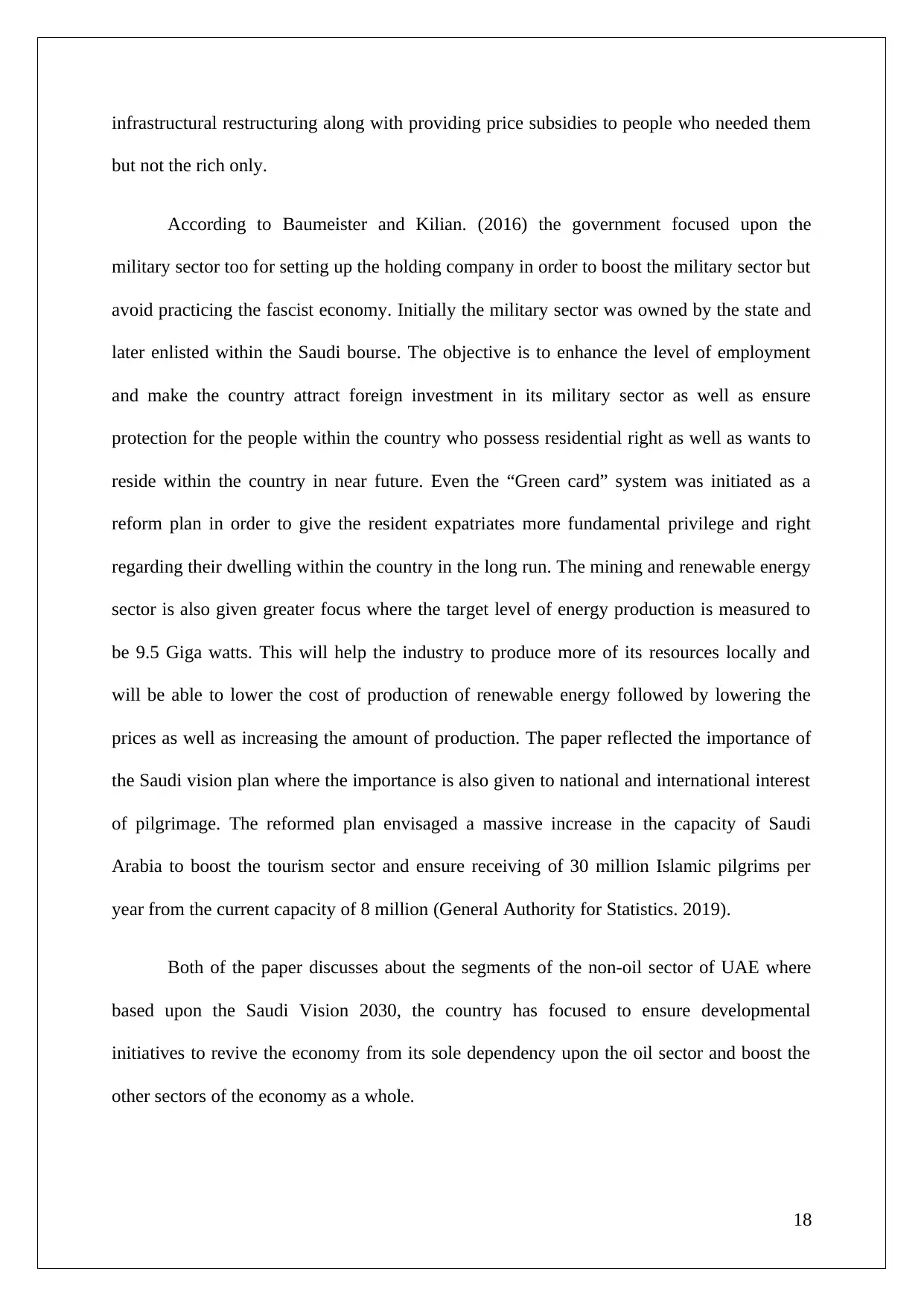
infrastructural restructuring along with providing price subsidies to people who needed them
but not the rich only.
According to Baumeister and Kilian. (2016) the government focused upon the
military sector too for setting up the holding company in order to boost the military sector but
avoid practicing the fascist economy. Initially the military sector was owned by the state and
later enlisted within the Saudi bourse. The objective is to enhance the level of employment
and make the country attract foreign investment in its military sector as well as ensure
protection for the people within the country who possess residential right as well as wants to
reside within the country in near future. Even the “Green card” system was initiated as a
reform plan in order to give the resident expatriates more fundamental privilege and right
regarding their dwelling within the country in the long run. The mining and renewable energy
sector is also given greater focus where the target level of energy production is measured to
be 9.5 Giga watts. This will help the industry to produce more of its resources locally and
will be able to lower the cost of production of renewable energy followed by lowering the
prices as well as increasing the amount of production. The paper reflected the importance of
the Saudi vision plan where the importance is also given to national and international interest
of pilgrimage. The reformed plan envisaged a massive increase in the capacity of Saudi
Arabia to boost the tourism sector and ensure receiving of 30 million Islamic pilgrims per
year from the current capacity of 8 million (General Authority for Statistics. 2019).
Both of the paper discusses about the segments of the non-oil sector of UAE where
based upon the Saudi Vision 2030, the country has focused to ensure developmental
initiatives to revive the economy from its sole dependency upon the oil sector and boost the
other sectors of the economy as a whole.
18
but not the rich only.
According to Baumeister and Kilian. (2016) the government focused upon the
military sector too for setting up the holding company in order to boost the military sector but
avoid practicing the fascist economy. Initially the military sector was owned by the state and
later enlisted within the Saudi bourse. The objective is to enhance the level of employment
and make the country attract foreign investment in its military sector as well as ensure
protection for the people within the country who possess residential right as well as wants to
reside within the country in near future. Even the “Green card” system was initiated as a
reform plan in order to give the resident expatriates more fundamental privilege and right
regarding their dwelling within the country in the long run. The mining and renewable energy
sector is also given greater focus where the target level of energy production is measured to
be 9.5 Giga watts. This will help the industry to produce more of its resources locally and
will be able to lower the cost of production of renewable energy followed by lowering the
prices as well as increasing the amount of production. The paper reflected the importance of
the Saudi vision plan where the importance is also given to national and international interest
of pilgrimage. The reformed plan envisaged a massive increase in the capacity of Saudi
Arabia to boost the tourism sector and ensure receiving of 30 million Islamic pilgrims per
year from the current capacity of 8 million (General Authority for Statistics. 2019).
Both of the paper discusses about the segments of the non-oil sector of UAE where
based upon the Saudi Vision 2030, the country has focused to ensure developmental
initiatives to revive the economy from its sole dependency upon the oil sector and boost the
other sectors of the economy as a whole.
18
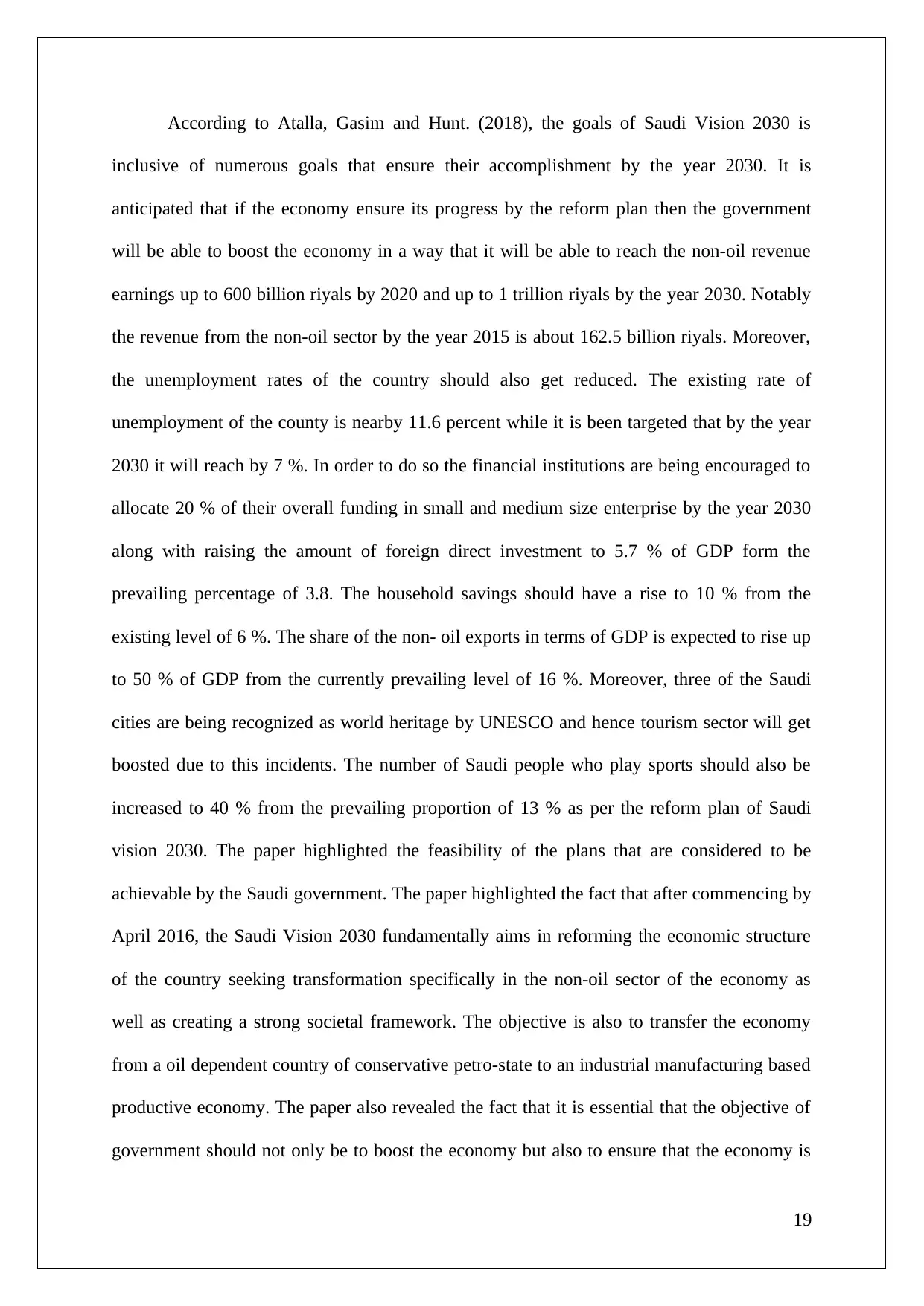
According to Atalla, Gasim and Hunt. (2018), the goals of Saudi Vision 2030 is
inclusive of numerous goals that ensure their accomplishment by the year 2030. It is
anticipated that if the economy ensure its progress by the reform plan then the government
will be able to boost the economy in a way that it will be able to reach the non-oil revenue
earnings up to 600 billion riyals by 2020 and up to 1 trillion riyals by the year 2030. Notably
the revenue from the non-oil sector by the year 2015 is about 162.5 billion riyals. Moreover,
the unemployment rates of the country should also get reduced. The existing rate of
unemployment of the county is nearby 11.6 percent while it is been targeted that by the year
2030 it will reach by 7 %. In order to do so the financial institutions are being encouraged to
allocate 20 % of their overall funding in small and medium size enterprise by the year 2030
along with raising the amount of foreign direct investment to 5.7 % of GDP form the
prevailing percentage of 3.8. The household savings should have a rise to 10 % from the
existing level of 6 %. The share of the non- oil exports in terms of GDP is expected to rise up
to 50 % of GDP from the currently prevailing level of 16 %. Moreover, three of the Saudi
cities are being recognized as world heritage by UNESCO and hence tourism sector will get
boosted due to this incidents. The number of Saudi people who play sports should also be
increased to 40 % from the prevailing proportion of 13 % as per the reform plan of Saudi
vision 2030. The paper highlighted the feasibility of the plans that are considered to be
achievable by the Saudi government. The paper highlighted the fact that after commencing by
April 2016, the Saudi Vision 2030 fundamentally aims in reforming the economic structure
of the country seeking transformation specifically in the non-oil sector of the economy as
well as creating a strong societal framework. The objective is also to transfer the economy
from a oil dependent country of conservative petro-state to an industrial manufacturing based
productive economy. The paper also revealed the fact that it is essential that the objective of
government should not only be to boost the economy but also to ensure that the economy is
19
inclusive of numerous goals that ensure their accomplishment by the year 2030. It is
anticipated that if the economy ensure its progress by the reform plan then the government
will be able to boost the economy in a way that it will be able to reach the non-oil revenue
earnings up to 600 billion riyals by 2020 and up to 1 trillion riyals by the year 2030. Notably
the revenue from the non-oil sector by the year 2015 is about 162.5 billion riyals. Moreover,
the unemployment rates of the country should also get reduced. The existing rate of
unemployment of the county is nearby 11.6 percent while it is been targeted that by the year
2030 it will reach by 7 %. In order to do so the financial institutions are being encouraged to
allocate 20 % of their overall funding in small and medium size enterprise by the year 2030
along with raising the amount of foreign direct investment to 5.7 % of GDP form the
prevailing percentage of 3.8. The household savings should have a rise to 10 % from the
existing level of 6 %. The share of the non- oil exports in terms of GDP is expected to rise up
to 50 % of GDP from the currently prevailing level of 16 %. Moreover, three of the Saudi
cities are being recognized as world heritage by UNESCO and hence tourism sector will get
boosted due to this incidents. The number of Saudi people who play sports should also be
increased to 40 % from the prevailing proportion of 13 % as per the reform plan of Saudi
vision 2030. The paper highlighted the feasibility of the plans that are considered to be
achievable by the Saudi government. The paper highlighted the fact that after commencing by
April 2016, the Saudi Vision 2030 fundamentally aims in reforming the economic structure
of the country seeking transformation specifically in the non-oil sector of the economy as
well as creating a strong societal framework. The objective is also to transfer the economy
from a oil dependent country of conservative petro-state to an industrial manufacturing based
productive economy. The paper also revealed the fact that it is essential that the objective of
government should not only be to boost the economy but also to ensure that the economy is
19
Paraphrase This Document
Need a fresh take? Get an instant paraphrase of this document with our AI Paraphraser
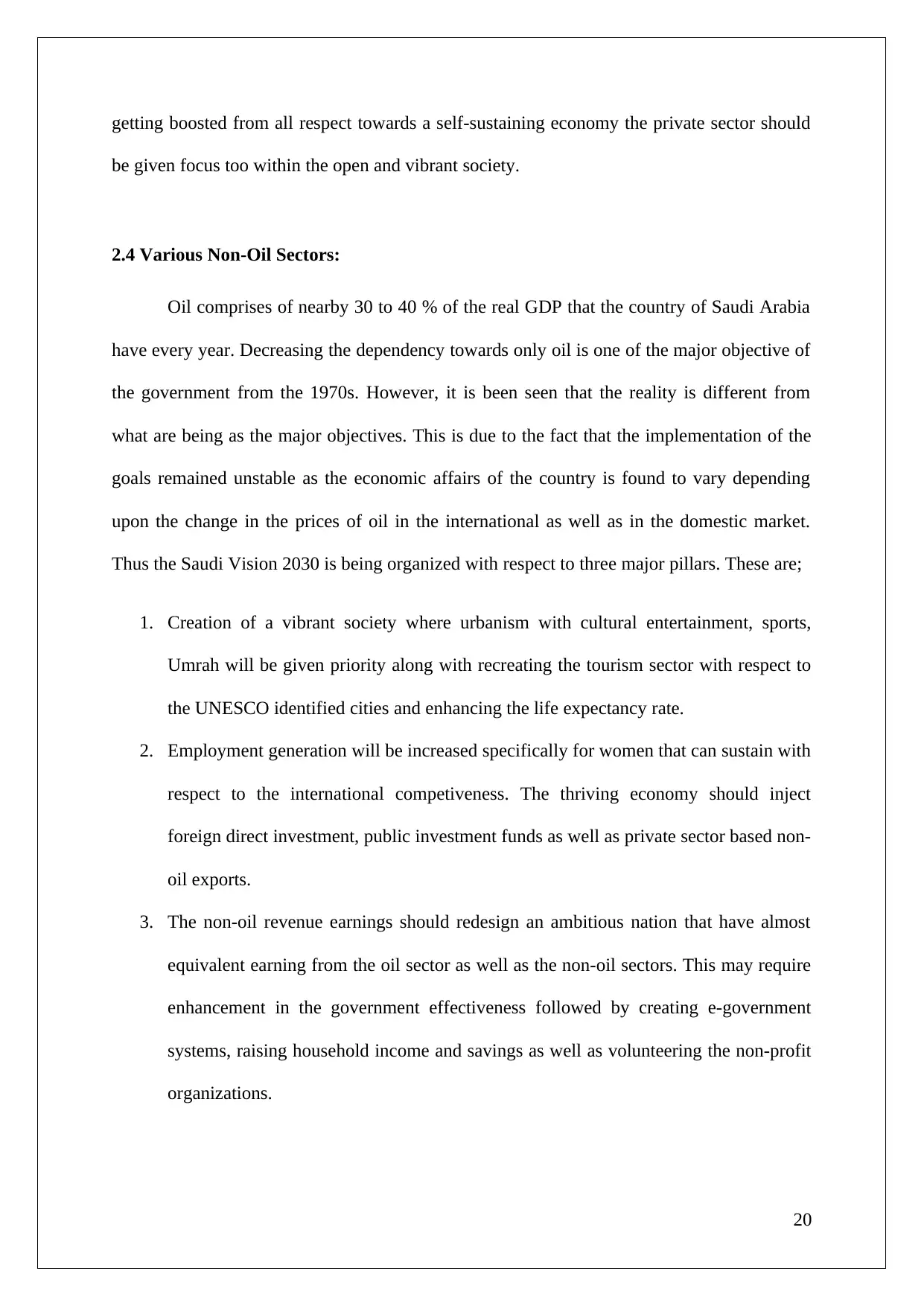
getting boosted from all respect towards a self-sustaining economy the private sector should
be given focus too within the open and vibrant society.
2.4 Various Non-Oil Sectors:
Oil comprises of nearby 30 to 40 % of the real GDP that the country of Saudi Arabia
have every year. Decreasing the dependency towards only oil is one of the major objective of
the government from the 1970s. However, it is been seen that the reality is different from
what are being as the major objectives. This is due to the fact that the implementation of the
goals remained unstable as the economic affairs of the country is found to vary depending
upon the change in the prices of oil in the international as well as in the domestic market.
Thus the Saudi Vision 2030 is being organized with respect to three major pillars. These are;
1. Creation of a vibrant society where urbanism with cultural entertainment, sports,
Umrah will be given priority along with recreating the tourism sector with respect to
the UNESCO identified cities and enhancing the life expectancy rate.
2. Employment generation will be increased specifically for women that can sustain with
respect to the international competiveness. The thriving economy should inject
foreign direct investment, public investment funds as well as private sector based non-
oil exports.
3. The non-oil revenue earnings should redesign an ambitious nation that have almost
equivalent earning from the oil sector as well as the non-oil sectors. This may require
enhancement in the government effectiveness followed by creating e-government
systems, raising household income and savings as well as volunteering the non-profit
organizations.
20
be given focus too within the open and vibrant society.
2.4 Various Non-Oil Sectors:
Oil comprises of nearby 30 to 40 % of the real GDP that the country of Saudi Arabia
have every year. Decreasing the dependency towards only oil is one of the major objective of
the government from the 1970s. However, it is been seen that the reality is different from
what are being as the major objectives. This is due to the fact that the implementation of the
goals remained unstable as the economic affairs of the country is found to vary depending
upon the change in the prices of oil in the international as well as in the domestic market.
Thus the Saudi Vision 2030 is being organized with respect to three major pillars. These are;
1. Creation of a vibrant society where urbanism with cultural entertainment, sports,
Umrah will be given priority along with recreating the tourism sector with respect to
the UNESCO identified cities and enhancing the life expectancy rate.
2. Employment generation will be increased specifically for women that can sustain with
respect to the international competiveness. The thriving economy should inject
foreign direct investment, public investment funds as well as private sector based non-
oil exports.
3. The non-oil revenue earnings should redesign an ambitious nation that have almost
equivalent earning from the oil sector as well as the non-oil sectors. This may require
enhancement in the government effectiveness followed by creating e-government
systems, raising household income and savings as well as volunteering the non-profit
organizations.
20
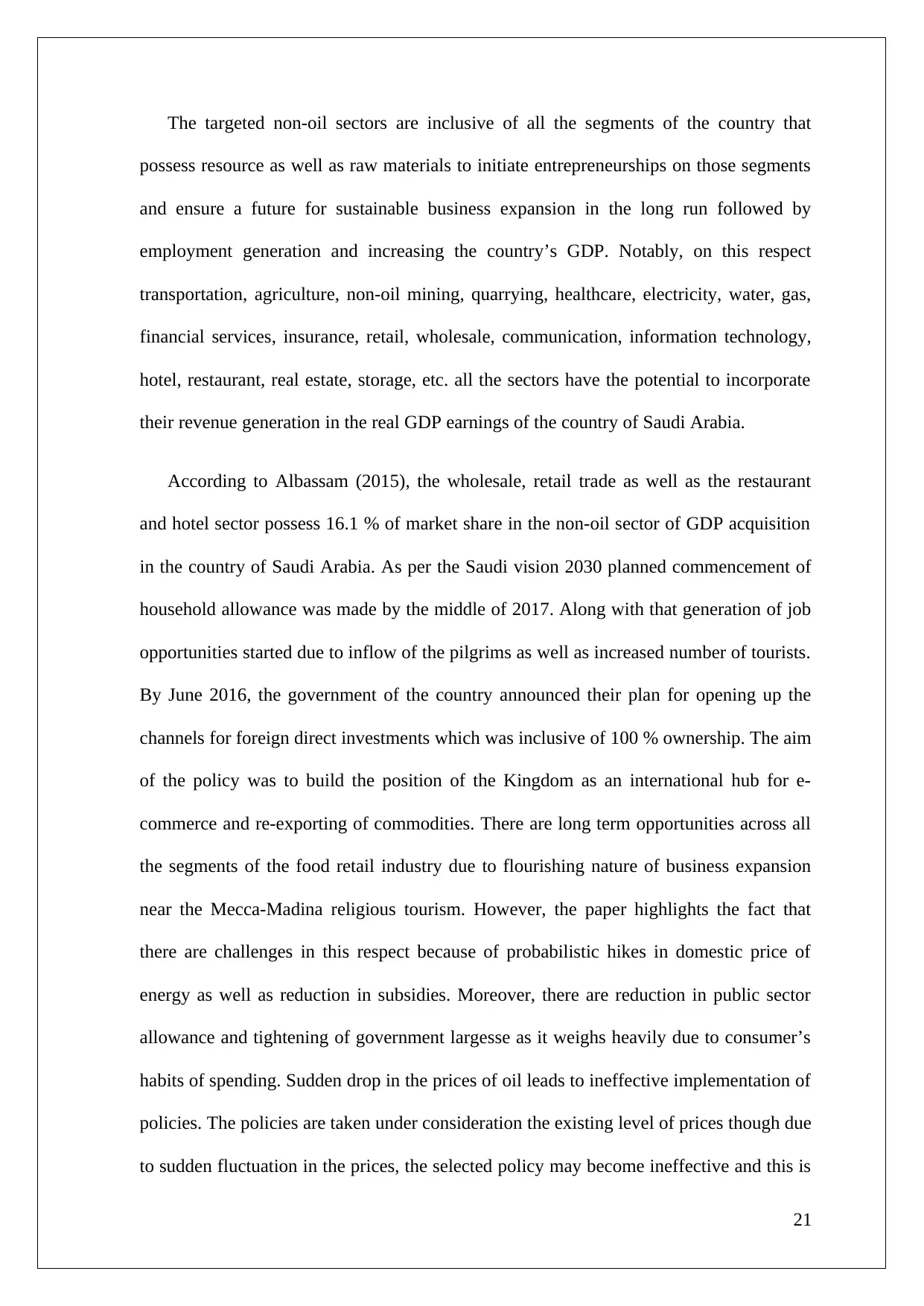
The targeted non-oil sectors are inclusive of all the segments of the country that
possess resource as well as raw materials to initiate entrepreneurships on those segments
and ensure a future for sustainable business expansion in the long run followed by
employment generation and increasing the country’s GDP. Notably, on this respect
transportation, agriculture, non-oil mining, quarrying, healthcare, electricity, water, gas,
financial services, insurance, retail, wholesale, communication, information technology,
hotel, restaurant, real estate, storage, etc. all the sectors have the potential to incorporate
their revenue generation in the real GDP earnings of the country of Saudi Arabia.
According to Albassam (2015), the wholesale, retail trade as well as the restaurant
and hotel sector possess 16.1 % of market share in the non-oil sector of GDP acquisition
in the country of Saudi Arabia. As per the Saudi vision 2030 planned commencement of
household allowance was made by the middle of 2017. Along with that generation of job
opportunities started due to inflow of the pilgrims as well as increased number of tourists.
By June 2016, the government of the country announced their plan for opening up the
channels for foreign direct investments which was inclusive of 100 % ownership. The aim
of the policy was to build the position of the Kingdom as an international hub for e-
commerce and re-exporting of commodities. There are long term opportunities across all
the segments of the food retail industry due to flourishing nature of business expansion
near the Mecca-Madina religious tourism. However, the paper highlights the fact that
there are challenges in this respect because of probabilistic hikes in domestic price of
energy as well as reduction in subsidies. Moreover, there are reduction in public sector
allowance and tightening of government largesse as it weighs heavily due to consumer’s
habits of spending. Sudden drop in the prices of oil leads to ineffective implementation of
policies. The policies are taken under consideration the existing level of prices though due
to sudden fluctuation in the prices, the selected policy may become ineffective and this is
21
possess resource as well as raw materials to initiate entrepreneurships on those segments
and ensure a future for sustainable business expansion in the long run followed by
employment generation and increasing the country’s GDP. Notably, on this respect
transportation, agriculture, non-oil mining, quarrying, healthcare, electricity, water, gas,
financial services, insurance, retail, wholesale, communication, information technology,
hotel, restaurant, real estate, storage, etc. all the sectors have the potential to incorporate
their revenue generation in the real GDP earnings of the country of Saudi Arabia.
According to Albassam (2015), the wholesale, retail trade as well as the restaurant
and hotel sector possess 16.1 % of market share in the non-oil sector of GDP acquisition
in the country of Saudi Arabia. As per the Saudi vision 2030 planned commencement of
household allowance was made by the middle of 2017. Along with that generation of job
opportunities started due to inflow of the pilgrims as well as increased number of tourists.
By June 2016, the government of the country announced their plan for opening up the
channels for foreign direct investments which was inclusive of 100 % ownership. The aim
of the policy was to build the position of the Kingdom as an international hub for e-
commerce and re-exporting of commodities. There are long term opportunities across all
the segments of the food retail industry due to flourishing nature of business expansion
near the Mecca-Madina religious tourism. However, the paper highlights the fact that
there are challenges in this respect because of probabilistic hikes in domestic price of
energy as well as reduction in subsidies. Moreover, there are reduction in public sector
allowance and tightening of government largesse as it weighs heavily due to consumer’s
habits of spending. Sudden drop in the prices of oil leads to ineffective implementation of
policies. The policies are taken under consideration the existing level of prices though due
to sudden fluctuation in the prices, the selected policy may become ineffective and this is
21
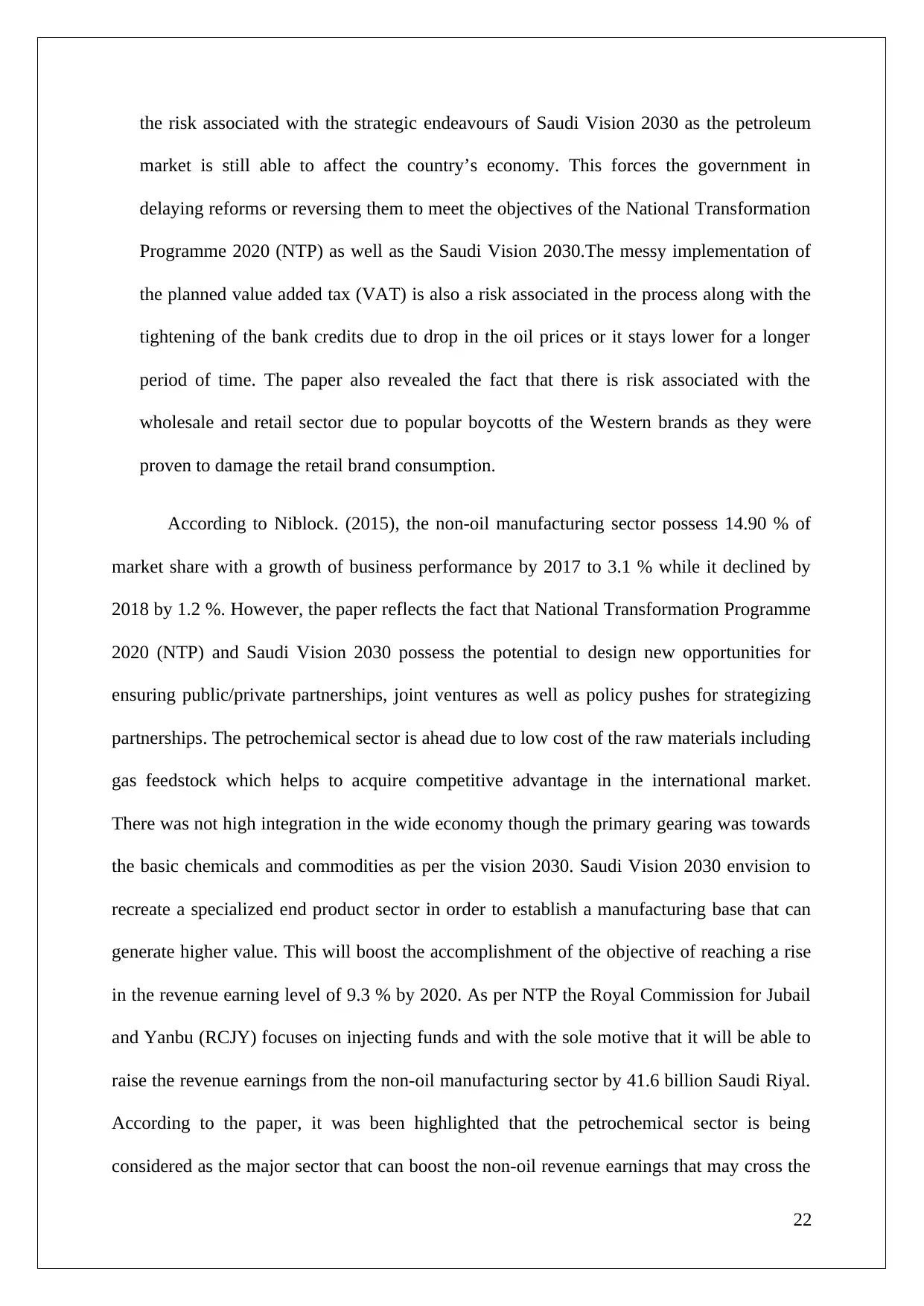
the risk associated with the strategic endeavours of Saudi Vision 2030 as the petroleum
market is still able to affect the country’s economy. This forces the government in
delaying reforms or reversing them to meet the objectives of the National Transformation
Programme 2020 (NTP) as well as the Saudi Vision 2030.The messy implementation of
the planned value added tax (VAT) is also a risk associated in the process along with the
tightening of the bank credits due to drop in the oil prices or it stays lower for a longer
period of time. The paper also revealed the fact that there is risk associated with the
wholesale and retail sector due to popular boycotts of the Western brands as they were
proven to damage the retail brand consumption.
According to Niblock. (2015), the non-oil manufacturing sector possess 14.90 % of
market share with a growth of business performance by 2017 to 3.1 % while it declined by
2018 by 1.2 %. However, the paper reflects the fact that National Transformation Programme
2020 (NTP) and Saudi Vision 2030 possess the potential to design new opportunities for
ensuring public/private partnerships, joint ventures as well as policy pushes for strategizing
partnerships. The petrochemical sector is ahead due to low cost of the raw materials including
gas feedstock which helps to acquire competitive advantage in the international market.
There was not high integration in the wide economy though the primary gearing was towards
the basic chemicals and commodities as per the vision 2030. Saudi Vision 2030 envision to
recreate a specialized end product sector in order to establish a manufacturing base that can
generate higher value. This will boost the accomplishment of the objective of reaching a rise
in the revenue earning level of 9.3 % by 2020. As per NTP the Royal Commission for Jubail
and Yanbu (RCJY) focuses on injecting funds and with the sole motive that it will be able to
raise the revenue earnings from the non-oil manufacturing sector by 41.6 billion Saudi Riyal.
According to the paper, it was been highlighted that the petrochemical sector is being
considered as the major sector that can boost the non-oil revenue earnings that may cross the
22
market is still able to affect the country’s economy. This forces the government in
delaying reforms or reversing them to meet the objectives of the National Transformation
Programme 2020 (NTP) as well as the Saudi Vision 2030.The messy implementation of
the planned value added tax (VAT) is also a risk associated in the process along with the
tightening of the bank credits due to drop in the oil prices or it stays lower for a longer
period of time. The paper also revealed the fact that there is risk associated with the
wholesale and retail sector due to popular boycotts of the Western brands as they were
proven to damage the retail brand consumption.
According to Niblock. (2015), the non-oil manufacturing sector possess 14.90 % of
market share with a growth of business performance by 2017 to 3.1 % while it declined by
2018 by 1.2 %. However, the paper reflects the fact that National Transformation Programme
2020 (NTP) and Saudi Vision 2030 possess the potential to design new opportunities for
ensuring public/private partnerships, joint ventures as well as policy pushes for strategizing
partnerships. The petrochemical sector is ahead due to low cost of the raw materials including
gas feedstock which helps to acquire competitive advantage in the international market.
There was not high integration in the wide economy though the primary gearing was towards
the basic chemicals and commodities as per the vision 2030. Saudi Vision 2030 envision to
recreate a specialized end product sector in order to establish a manufacturing base that can
generate higher value. This will boost the accomplishment of the objective of reaching a rise
in the revenue earning level of 9.3 % by 2020. As per NTP the Royal Commission for Jubail
and Yanbu (RCJY) focuses on injecting funds and with the sole motive that it will be able to
raise the revenue earnings from the non-oil manufacturing sector by 41.6 billion Saudi Riyal.
According to the paper, it was been highlighted that the petrochemical sector is being
considered as the major sector that can boost the non-oil revenue earnings that may cross the
22
Secure Best Marks with AI Grader
Need help grading? Try our AI Grader for instant feedback on your assignments.
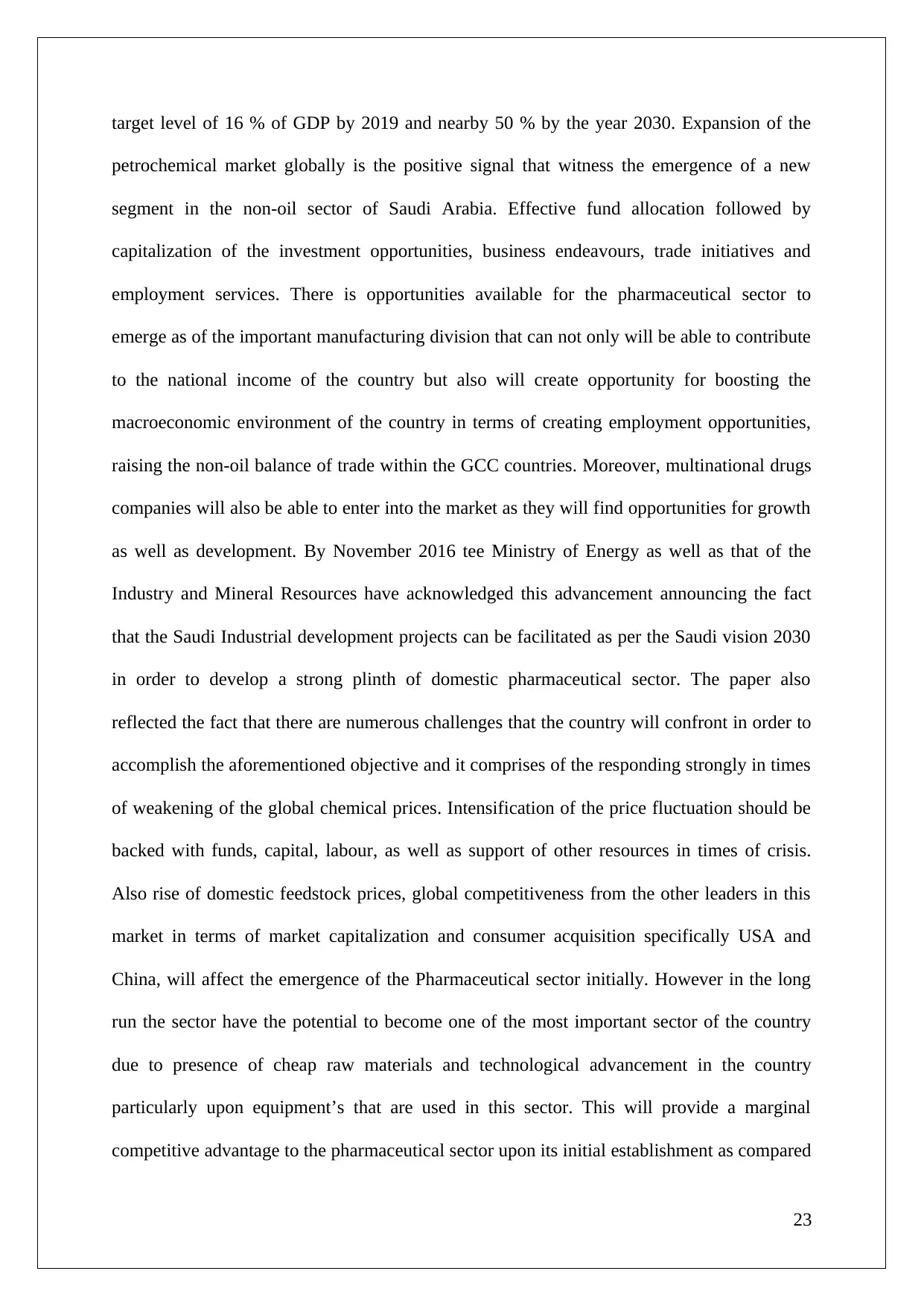
target level of 16 % of GDP by 2019 and nearby 50 % by the year 2030. Expansion of the
petrochemical market globally is the positive signal that witness the emergence of a new
segment in the non-oil sector of Saudi Arabia. Effective fund allocation followed by
capitalization of the investment opportunities, business endeavours, trade initiatives and
employment services. There is opportunities available for the pharmaceutical sector to
emerge as of the important manufacturing division that can not only will be able to contribute
to the national income of the country but also will create opportunity for boosting the
macroeconomic environment of the country in terms of creating employment opportunities,
raising the non-oil balance of trade within the GCC countries. Moreover, multinational drugs
companies will also be able to enter into the market as they will find opportunities for growth
as well as development. By November 2016 tee Ministry of Energy as well as that of the
Industry and Mineral Resources have acknowledged this advancement announcing the fact
that the Saudi Industrial development projects can be facilitated as per the Saudi vision 2030
in order to develop a strong plinth of domestic pharmaceutical sector. The paper also
reflected the fact that there are numerous challenges that the country will confront in order to
accomplish the aforementioned objective and it comprises of the responding strongly in times
of weakening of the global chemical prices. Intensification of the price fluctuation should be
backed with funds, capital, labour, as well as support of other resources in times of crisis.
Also rise of domestic feedstock prices, global competitiveness from the other leaders in this
market in terms of market capitalization and consumer acquisition specifically USA and
China, will affect the emergence of the Pharmaceutical sector initially. However in the long
run the sector have the potential to become one of the most important sector of the country
due to presence of cheap raw materials and technological advancement in the country
particularly upon equipment’s that are used in this sector. This will provide a marginal
competitive advantage to the pharmaceutical sector upon its initial establishment as compared
23
petrochemical market globally is the positive signal that witness the emergence of a new
segment in the non-oil sector of Saudi Arabia. Effective fund allocation followed by
capitalization of the investment opportunities, business endeavours, trade initiatives and
employment services. There is opportunities available for the pharmaceutical sector to
emerge as of the important manufacturing division that can not only will be able to contribute
to the national income of the country but also will create opportunity for boosting the
macroeconomic environment of the country in terms of creating employment opportunities,
raising the non-oil balance of trade within the GCC countries. Moreover, multinational drugs
companies will also be able to enter into the market as they will find opportunities for growth
as well as development. By November 2016 tee Ministry of Energy as well as that of the
Industry and Mineral Resources have acknowledged this advancement announcing the fact
that the Saudi Industrial development projects can be facilitated as per the Saudi vision 2030
in order to develop a strong plinth of domestic pharmaceutical sector. The paper also
reflected the fact that there are numerous challenges that the country will confront in order to
accomplish the aforementioned objective and it comprises of the responding strongly in times
of weakening of the global chemical prices. Intensification of the price fluctuation should be
backed with funds, capital, labour, as well as support of other resources in times of crisis.
Also rise of domestic feedstock prices, global competitiveness from the other leaders in this
market in terms of market capitalization and consumer acquisition specifically USA and
China, will affect the emergence of the Pharmaceutical sector initially. However in the long
run the sector have the potential to become one of the most important sector of the country
due to presence of cheap raw materials and technological advancement in the country
particularly upon equipment’s that are used in this sector. This will provide a marginal
competitive advantage to the pharmaceutical sector upon its initial establishment as compared
23
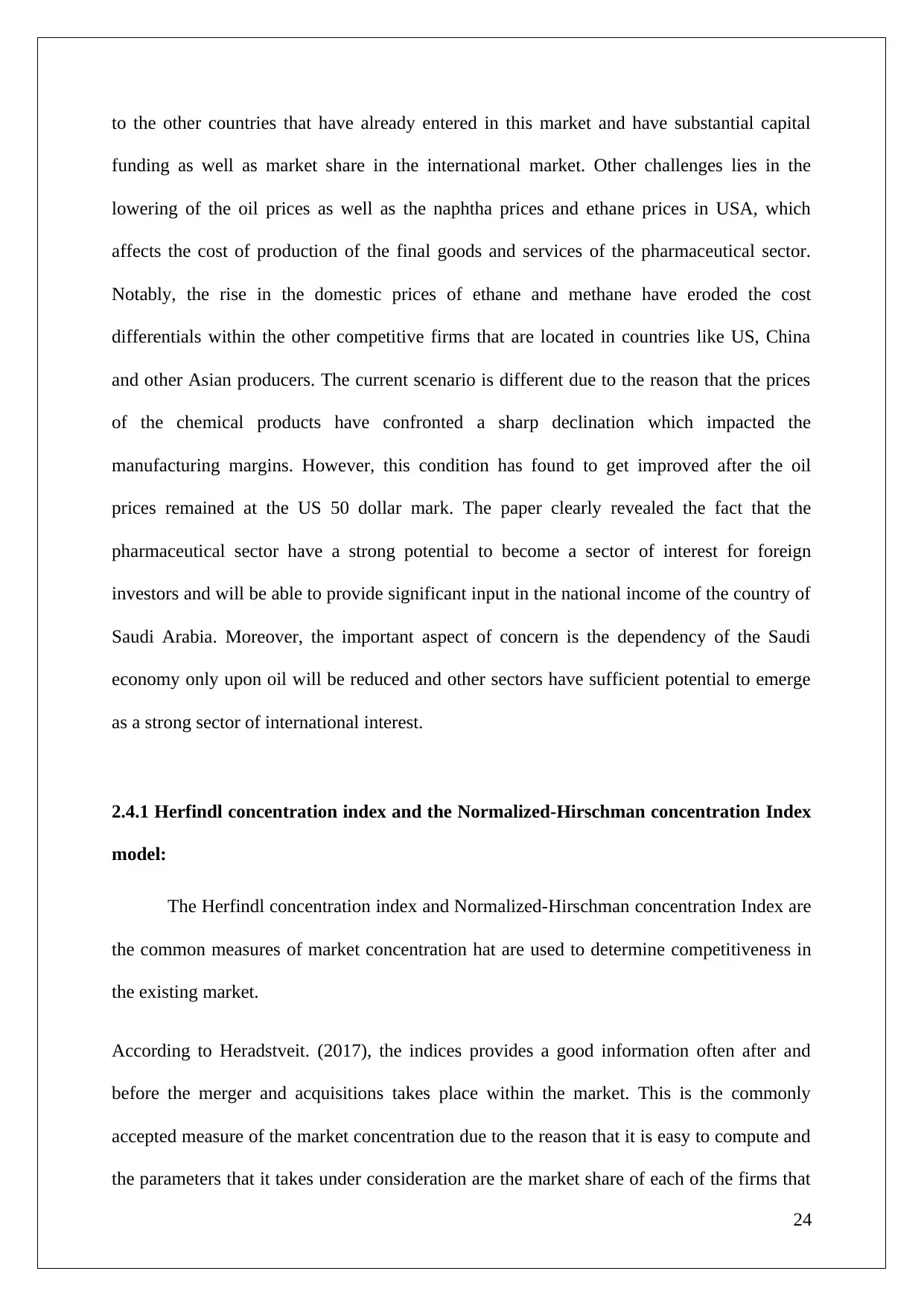
to the other countries that have already entered in this market and have substantial capital
funding as well as market share in the international market. Other challenges lies in the
lowering of the oil prices as well as the naphtha prices and ethane prices in USA, which
affects the cost of production of the final goods and services of the pharmaceutical sector.
Notably, the rise in the domestic prices of ethane and methane have eroded the cost
differentials within the other competitive firms that are located in countries like US, China
and other Asian producers. The current scenario is different due to the reason that the prices
of the chemical products have confronted a sharp declination which impacted the
manufacturing margins. However, this condition has found to get improved after the oil
prices remained at the US 50 dollar mark. The paper clearly revealed the fact that the
pharmaceutical sector have a strong potential to become a sector of interest for foreign
investors and will be able to provide significant input in the national income of the country of
Saudi Arabia. Moreover, the important aspect of concern is the dependency of the Saudi
economy only upon oil will be reduced and other sectors have sufficient potential to emerge
as a strong sector of international interest.
2.4.1 Herfindl concentration index and the Normalized-Hirschman concentration Index
model:
The Herfindl concentration index and Normalized-Hirschman concentration Index are
the common measures of market concentration hat are used to determine competitiveness in
the existing market.
According to Heradstveit. (2017), the indices provides a good information often after and
before the merger and acquisitions takes place within the market. This is the commonly
accepted measure of the market concentration due to the reason that it is easy to compute and
the parameters that it takes under consideration are the market share of each of the firms that
24
funding as well as market share in the international market. Other challenges lies in the
lowering of the oil prices as well as the naphtha prices and ethane prices in USA, which
affects the cost of production of the final goods and services of the pharmaceutical sector.
Notably, the rise in the domestic prices of ethane and methane have eroded the cost
differentials within the other competitive firms that are located in countries like US, China
and other Asian producers. The current scenario is different due to the reason that the prices
of the chemical products have confronted a sharp declination which impacted the
manufacturing margins. However, this condition has found to get improved after the oil
prices remained at the US 50 dollar mark. The paper clearly revealed the fact that the
pharmaceutical sector have a strong potential to become a sector of interest for foreign
investors and will be able to provide significant input in the national income of the country of
Saudi Arabia. Moreover, the important aspect of concern is the dependency of the Saudi
economy only upon oil will be reduced and other sectors have sufficient potential to emerge
as a strong sector of international interest.
2.4.1 Herfindl concentration index and the Normalized-Hirschman concentration Index
model:
The Herfindl concentration index and Normalized-Hirschman concentration Index are
the common measures of market concentration hat are used to determine competitiveness in
the existing market.
According to Heradstveit. (2017), the indices provides a good information often after and
before the merger and acquisitions takes place within the market. This is the commonly
accepted measure of the market concentration due to the reason that it is easy to compute and
the parameters that it takes under consideration are the market share of each of the firms that
24
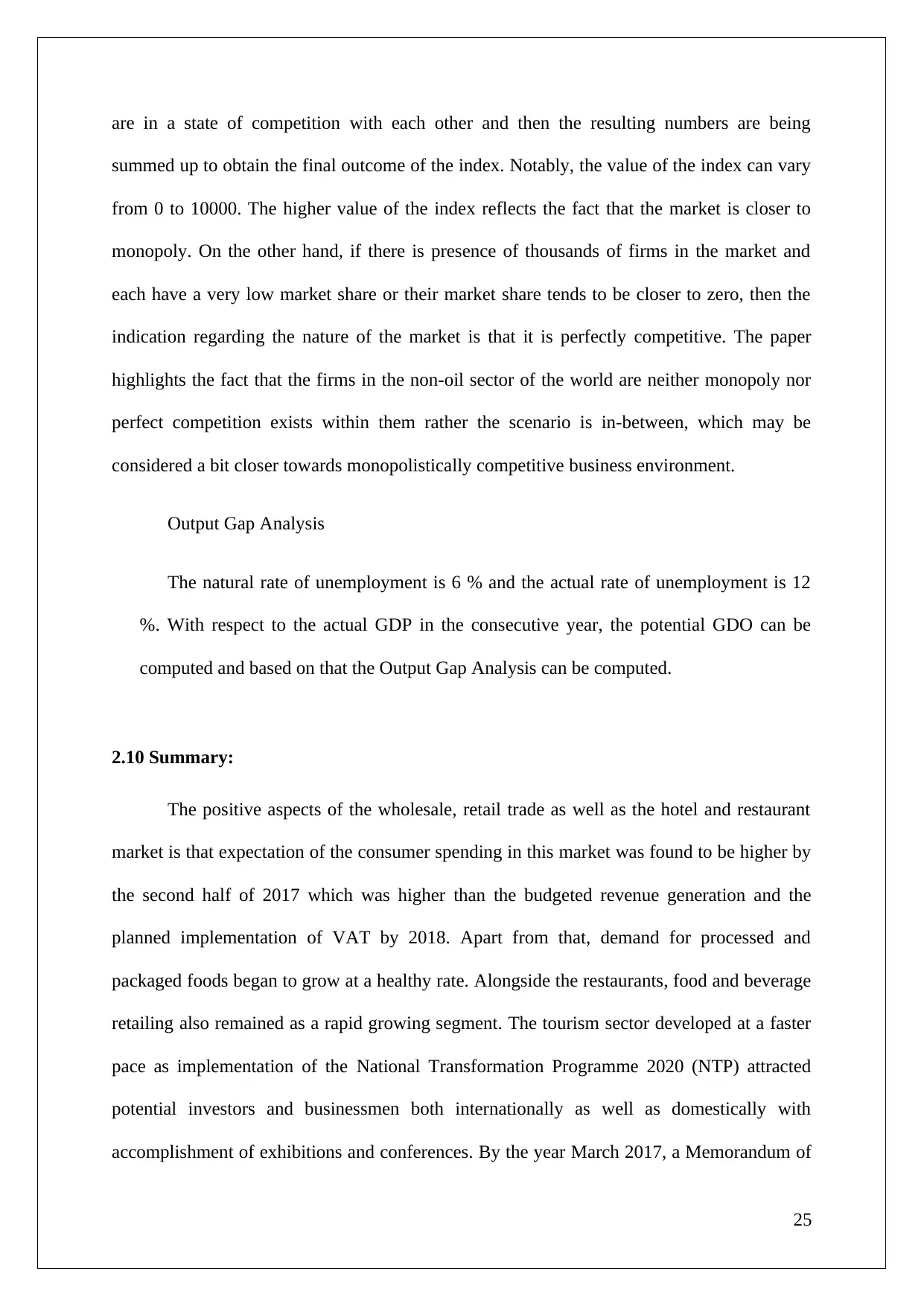
are in a state of competition with each other and then the resulting numbers are being
summed up to obtain the final outcome of the index. Notably, the value of the index can vary
from 0 to 10000. The higher value of the index reflects the fact that the market is closer to
monopoly. On the other hand, if there is presence of thousands of firms in the market and
each have a very low market share or their market share tends to be closer to zero, then the
indication regarding the nature of the market is that it is perfectly competitive. The paper
highlights the fact that the firms in the non-oil sector of the world are neither monopoly nor
perfect competition exists within them rather the scenario is in-between, which may be
considered a bit closer towards monopolistically competitive business environment.
Output Gap Analysis
The natural rate of unemployment is 6 % and the actual rate of unemployment is 12
%. With respect to the actual GDP in the consecutive year, the potential GDO can be
computed and based on that the Output Gap Analysis can be computed.
2.10 Summary:
The positive aspects of the wholesale, retail trade as well as the hotel and restaurant
market is that expectation of the consumer spending in this market was found to be higher by
the second half of 2017 which was higher than the budgeted revenue generation and the
planned implementation of VAT by 2018. Apart from that, demand for processed and
packaged foods began to grow at a healthy rate. Alongside the restaurants, food and beverage
retailing also remained as a rapid growing segment. The tourism sector developed at a faster
pace as implementation of the National Transformation Programme 2020 (NTP) attracted
potential investors and businessmen both internationally as well as domestically with
accomplishment of exhibitions and conferences. By the year March 2017, a Memorandum of
25
summed up to obtain the final outcome of the index. Notably, the value of the index can vary
from 0 to 10000. The higher value of the index reflects the fact that the market is closer to
monopoly. On the other hand, if there is presence of thousands of firms in the market and
each have a very low market share or their market share tends to be closer to zero, then the
indication regarding the nature of the market is that it is perfectly competitive. The paper
highlights the fact that the firms in the non-oil sector of the world are neither monopoly nor
perfect competition exists within them rather the scenario is in-between, which may be
considered a bit closer towards monopolistically competitive business environment.
Output Gap Analysis
The natural rate of unemployment is 6 % and the actual rate of unemployment is 12
%. With respect to the actual GDP in the consecutive year, the potential GDO can be
computed and based on that the Output Gap Analysis can be computed.
2.10 Summary:
The positive aspects of the wholesale, retail trade as well as the hotel and restaurant
market is that expectation of the consumer spending in this market was found to be higher by
the second half of 2017 which was higher than the budgeted revenue generation and the
planned implementation of VAT by 2018. Apart from that, demand for processed and
packaged foods began to grow at a healthy rate. Alongside the restaurants, food and beverage
retailing also remained as a rapid growing segment. The tourism sector developed at a faster
pace as implementation of the National Transformation Programme 2020 (NTP) attracted
potential investors and businessmen both internationally as well as domestically with
accomplishment of exhibitions and conferences. By the year March 2017, a Memorandum of
25
Paraphrase This Document
Need a fresh take? Get an instant paraphrase of this document with our AI Paraphraser

Understanding (MOU) was being signed between China North Industries Group Corporation.
Norinco, and Saudi Aramco where the deal worth nearby US 65 billion dollars. The objective
was to jointly implement a chemical complex by developing petrochemical projects in
Tianjin. This was an initiative based upon the agreement between the China’s Sinopec and
SABIC for designing a refining and chemical plant. However, the operational initiatives were
not implemented significantly yet the officials of the two countries have assured that the
implementation of the projects regarding the non-oil manufacturing will reach their
operational phase by 2019 onwards. Sadara Chemical Company of Jybail, PetroRabigh as
well as PlasChem which is Sadaras adjacent industrial park and chemical conversion are all
important firms that will capitalize the opportunity to facilitating the manufacturing of this
sector. In fact US 50 billion dollars was opened by Pfizer in the King Abudullah Economic
City.
Gap in the Literature
The gap in the literature persists related to the restrains faced by the consumer
spending in the non-oil sector due to cuts in the public sector pay, reduced subsidies as well
as gathering pace in implementation of the reform plan. After October 2016, it is seen that the
value of point – of – sale (POS) transaction have recovered by margin because of high prices
of oil yet remained susceptible to decline of the oil prices. 4.7 % decline in POS transactions
were there by the end of 2016 as compared to that of 2015 where there was a 13 % increase
in it. Even by January 2019 there was marginal decline in the POS transactions. Notably,
from second quarter of 2016 to the second quarter of 2018, merchandise imports fell by 13.3
% which indicate that there is a decline in the overall demand as well as build-up of the
inventory in the retail sector which was not identified in the literature. Import is expected to
increase by 0.5 % by 2018-19 which incorporates an import growth recovery though it is not
26
Norinco, and Saudi Aramco where the deal worth nearby US 65 billion dollars. The objective
was to jointly implement a chemical complex by developing petrochemical projects in
Tianjin. This was an initiative based upon the agreement between the China’s Sinopec and
SABIC for designing a refining and chemical plant. However, the operational initiatives were
not implemented significantly yet the officials of the two countries have assured that the
implementation of the projects regarding the non-oil manufacturing will reach their
operational phase by 2019 onwards. Sadara Chemical Company of Jybail, PetroRabigh as
well as PlasChem which is Sadaras adjacent industrial park and chemical conversion are all
important firms that will capitalize the opportunity to facilitating the manufacturing of this
sector. In fact US 50 billion dollars was opened by Pfizer in the King Abudullah Economic
City.
Gap in the Literature
The gap in the literature persists related to the restrains faced by the consumer
spending in the non-oil sector due to cuts in the public sector pay, reduced subsidies as well
as gathering pace in implementation of the reform plan. After October 2016, it is seen that the
value of point – of – sale (POS) transaction have recovered by margin because of high prices
of oil yet remained susceptible to decline of the oil prices. 4.7 % decline in POS transactions
were there by the end of 2016 as compared to that of 2015 where there was a 13 % increase
in it. Even by January 2019 there was marginal decline in the POS transactions. Notably,
from second quarter of 2016 to the second quarter of 2018, merchandise imports fell by 13.3
% which indicate that there is a decline in the overall demand as well as build-up of the
inventory in the retail sector which was not identified in the literature. Import is expected to
increase by 0.5 % by 2018-19 which incorporates an import growth recovery though it is not
26
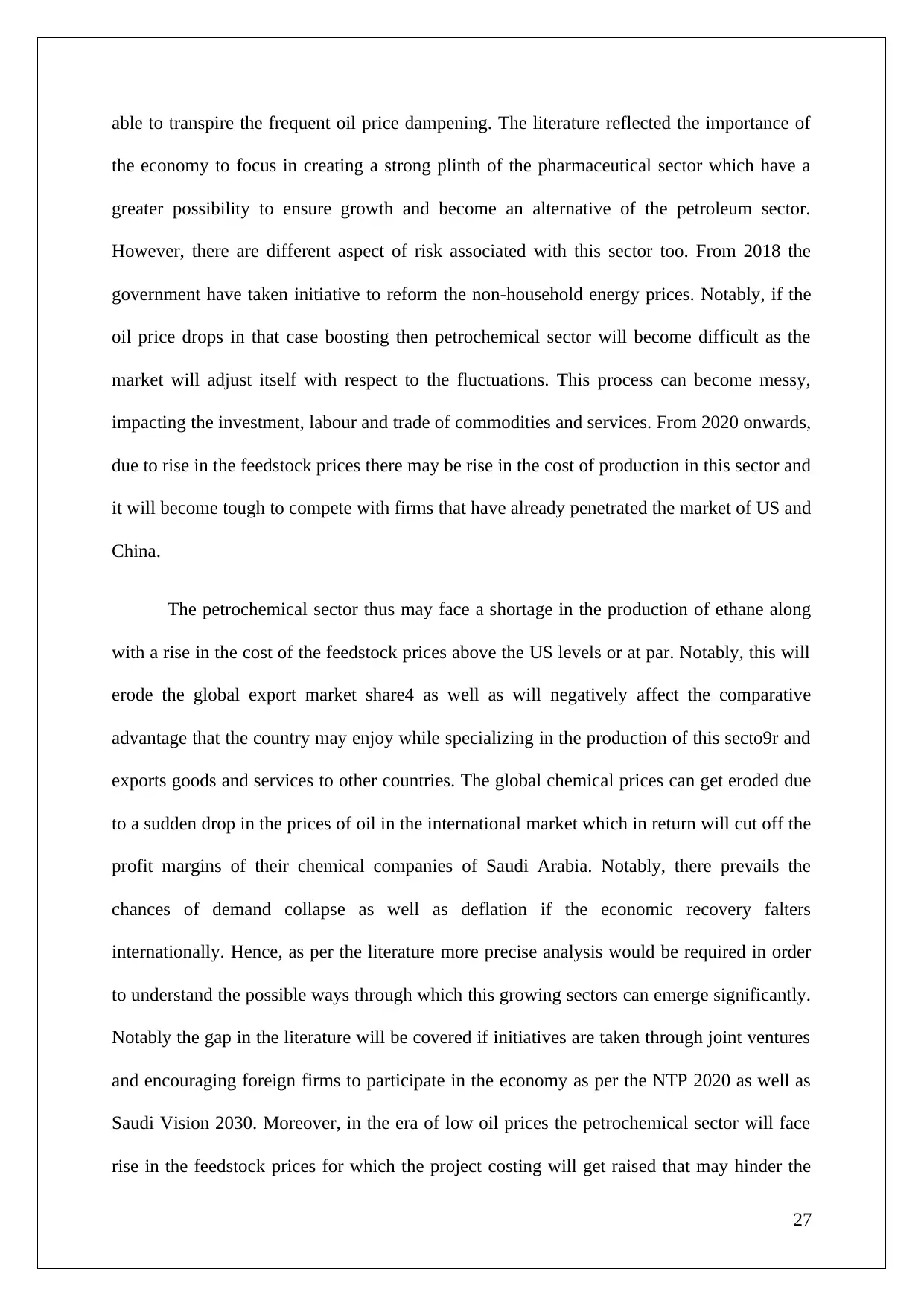
able to transpire the frequent oil price dampening. The literature reflected the importance of
the economy to focus in creating a strong plinth of the pharmaceutical sector which have a
greater possibility to ensure growth and become an alternative of the petroleum sector.
However, there are different aspect of risk associated with this sector too. From 2018 the
government have taken initiative to reform the non-household energy prices. Notably, if the
oil price drops in that case boosting then petrochemical sector will become difficult as the
market will adjust itself with respect to the fluctuations. This process can become messy,
impacting the investment, labour and trade of commodities and services. From 2020 onwards,
due to rise in the feedstock prices there may be rise in the cost of production in this sector and
it will become tough to compete with firms that have already penetrated the market of US and
China.
The petrochemical sector thus may face a shortage in the production of ethane along
with a rise in the cost of the feedstock prices above the US levels or at par. Notably, this will
erode the global export market share4 as well as will negatively affect the comparative
advantage that the country may enjoy while specializing in the production of this secto9r and
exports goods and services to other countries. The global chemical prices can get eroded due
to a sudden drop in the prices of oil in the international market which in return will cut off the
profit margins of their chemical companies of Saudi Arabia. Notably, there prevails the
chances of demand collapse as well as deflation if the economic recovery falters
internationally. Hence, as per the literature more precise analysis would be required in order
to understand the possible ways through which this growing sectors can emerge significantly.
Notably the gap in the literature will be covered if initiatives are taken through joint ventures
and encouraging foreign firms to participate in the economy as per the NTP 2020 as well as
Saudi Vision 2030. Moreover, in the era of low oil prices the petrochemical sector will face
rise in the feedstock prices for which the project costing will get raised that may hinder the
27
the economy to focus in creating a strong plinth of the pharmaceutical sector which have a
greater possibility to ensure growth and become an alternative of the petroleum sector.
However, there are different aspect of risk associated with this sector too. From 2018 the
government have taken initiative to reform the non-household energy prices. Notably, if the
oil price drops in that case boosting then petrochemical sector will become difficult as the
market will adjust itself with respect to the fluctuations. This process can become messy,
impacting the investment, labour and trade of commodities and services. From 2020 onwards,
due to rise in the feedstock prices there may be rise in the cost of production in this sector and
it will become tough to compete with firms that have already penetrated the market of US and
China.
The petrochemical sector thus may face a shortage in the production of ethane along
with a rise in the cost of the feedstock prices above the US levels or at par. Notably, this will
erode the global export market share4 as well as will negatively affect the comparative
advantage that the country may enjoy while specializing in the production of this secto9r and
exports goods and services to other countries. The global chemical prices can get eroded due
to a sudden drop in the prices of oil in the international market which in return will cut off the
profit margins of their chemical companies of Saudi Arabia. Notably, there prevails the
chances of demand collapse as well as deflation if the economic recovery falters
internationally. Hence, as per the literature more precise analysis would be required in order
to understand the possible ways through which this growing sectors can emerge significantly.
Notably the gap in the literature will be covered if initiatives are taken through joint ventures
and encouraging foreign firms to participate in the economy as per the NTP 2020 as well as
Saudi Vision 2030. Moreover, in the era of low oil prices the petrochemical sector will face
rise in the feedstock prices for which the project costing will get raised that may hinder the
27
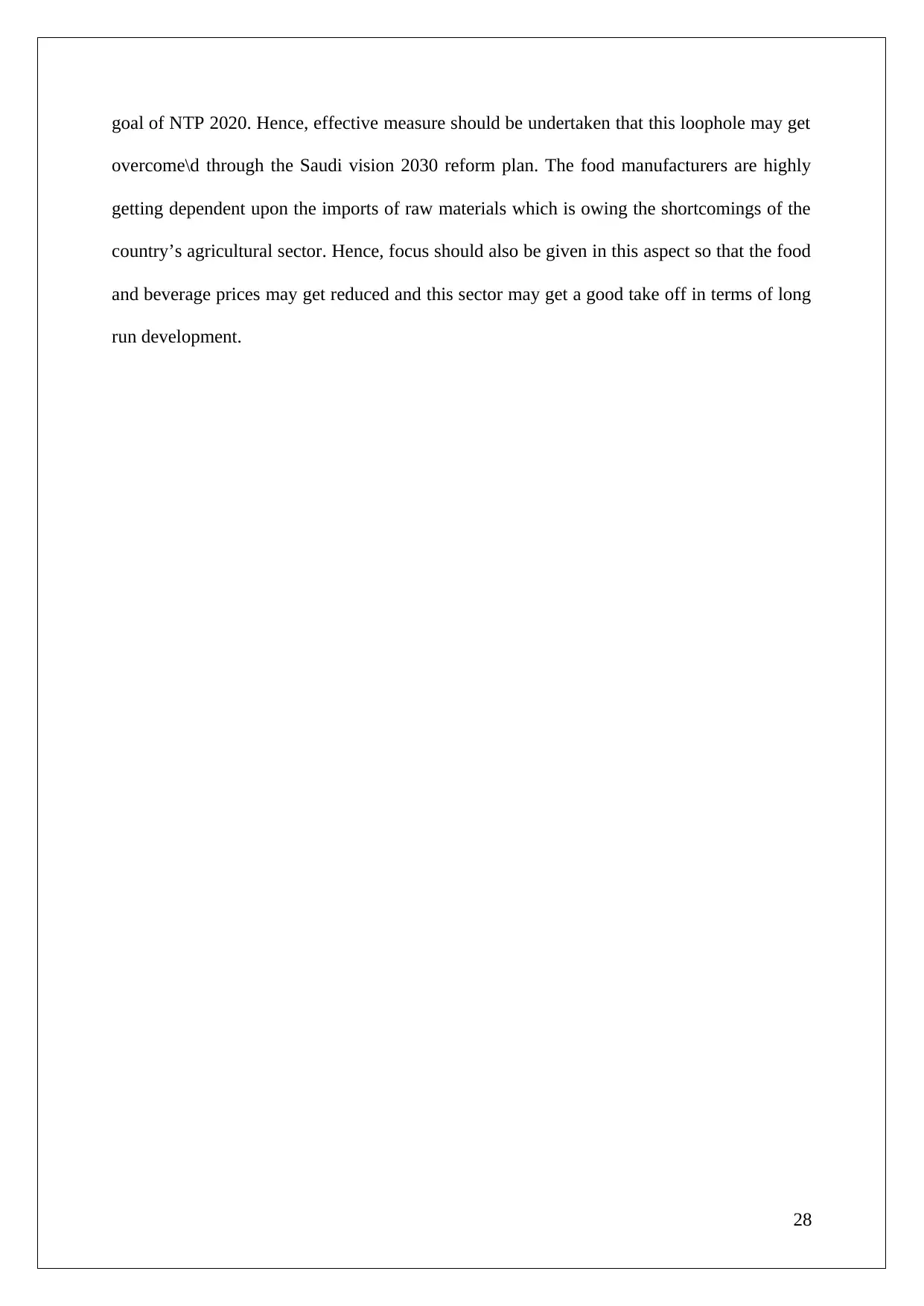
goal of NTP 2020. Hence, effective measure should be undertaken that this loophole may get
overcome\d through the Saudi vision 2030 reform plan. The food manufacturers are highly
getting dependent upon the imports of raw materials which is owing the shortcomings of the
country’s agricultural sector. Hence, focus should also be given in this aspect so that the food
and beverage prices may get reduced and this sector may get a good take off in terms of long
run development.
28
overcome\d through the Saudi vision 2030 reform plan. The food manufacturers are highly
getting dependent upon the imports of raw materials which is owing the shortcomings of the
country’s agricultural sector. Hence, focus should also be given in this aspect so that the food
and beverage prices may get reduced and this sector may get a good take off in terms of long
run development.
28
Secure Best Marks with AI Grader
Need help grading? Try our AI Grader for instant feedback on your assignments.

Chapter 3: Research Methodology
3.0 Introduction:
The methodology of the research provides a substantial plinth to the researcher
regarding the most feasible and credible procedure that would be followed in order to
accomplish the research successfully. Understanding the gap of the literature and
simultaneously rejuvenating into the areas from where the research will be able to snatch out
effective evidence and analysis to incorporate the objective of the research, requires to
follow the best possible and attainable research methods. The methodology of the research
comes into consideration on this regard, in order to ensure that the research is on track and to
keep it so, the designed approach that is being maintained should not get diverted from the
purpose of the research rather should justify with facts and figures the authenticity of the
research regarding the issue under consideration. Thus the third chapter of the dissertation
deals with various methods that strengthens the fundamental plinth of the research in order
to meet the objective of the research and accomplish the study followed by conducting
analysis and creating the space for effective recommendation and conclusion. Hence,
research methodology is one of the most important part in the dissertation as it is allied with
the appropriate selection of various methods for analysing the information as well as
processed data and interpreting the findings with accuracy followed by leading the research
toward a feasible solution.
3.1 Research method outline:
The preference of the researcher is towards the philosophy of positivism while the
approach of the research is deductive method. This research philosophy will help the
researcher to focus upon the existing theories and models related to the study. For the
research design, the researcher preferred the usage of analytical design or descriptive design
method. Moreover, the strategy of the research is organized through econometric modelling
and forecasting as well as exploratory data analysis upon the historical time series data. Apart
from the quantitative approach, the qualitative approach comprises of objective situational
analysis through testing SWOT and PESTLE Non-Oil Sector of the economy of Saudi
29
3.0 Introduction:
The methodology of the research provides a substantial plinth to the researcher
regarding the most feasible and credible procedure that would be followed in order to
accomplish the research successfully. Understanding the gap of the literature and
simultaneously rejuvenating into the areas from where the research will be able to snatch out
effective evidence and analysis to incorporate the objective of the research, requires to
follow the best possible and attainable research methods. The methodology of the research
comes into consideration on this regard, in order to ensure that the research is on track and to
keep it so, the designed approach that is being maintained should not get diverted from the
purpose of the research rather should justify with facts and figures the authenticity of the
research regarding the issue under consideration. Thus the third chapter of the dissertation
deals with various methods that strengthens the fundamental plinth of the research in order
to meet the objective of the research and accomplish the study followed by conducting
analysis and creating the space for effective recommendation and conclusion. Hence,
research methodology is one of the most important part in the dissertation as it is allied with
the appropriate selection of various methods for analysing the information as well as
processed data and interpreting the findings with accuracy followed by leading the research
toward a feasible solution.
3.1 Research method outline:
The preference of the researcher is towards the philosophy of positivism while the
approach of the research is deductive method. This research philosophy will help the
researcher to focus upon the existing theories and models related to the study. For the
research design, the researcher preferred the usage of analytical design or descriptive design
method. Moreover, the strategy of the research is organized through econometric modelling
and forecasting as well as exploratory data analysis upon the historical time series data. Apart
from the quantitative approach, the qualitative approach comprises of objective situational
analysis through testing SWOT and PESTLE Non-Oil Sector of the economy of Saudi
29
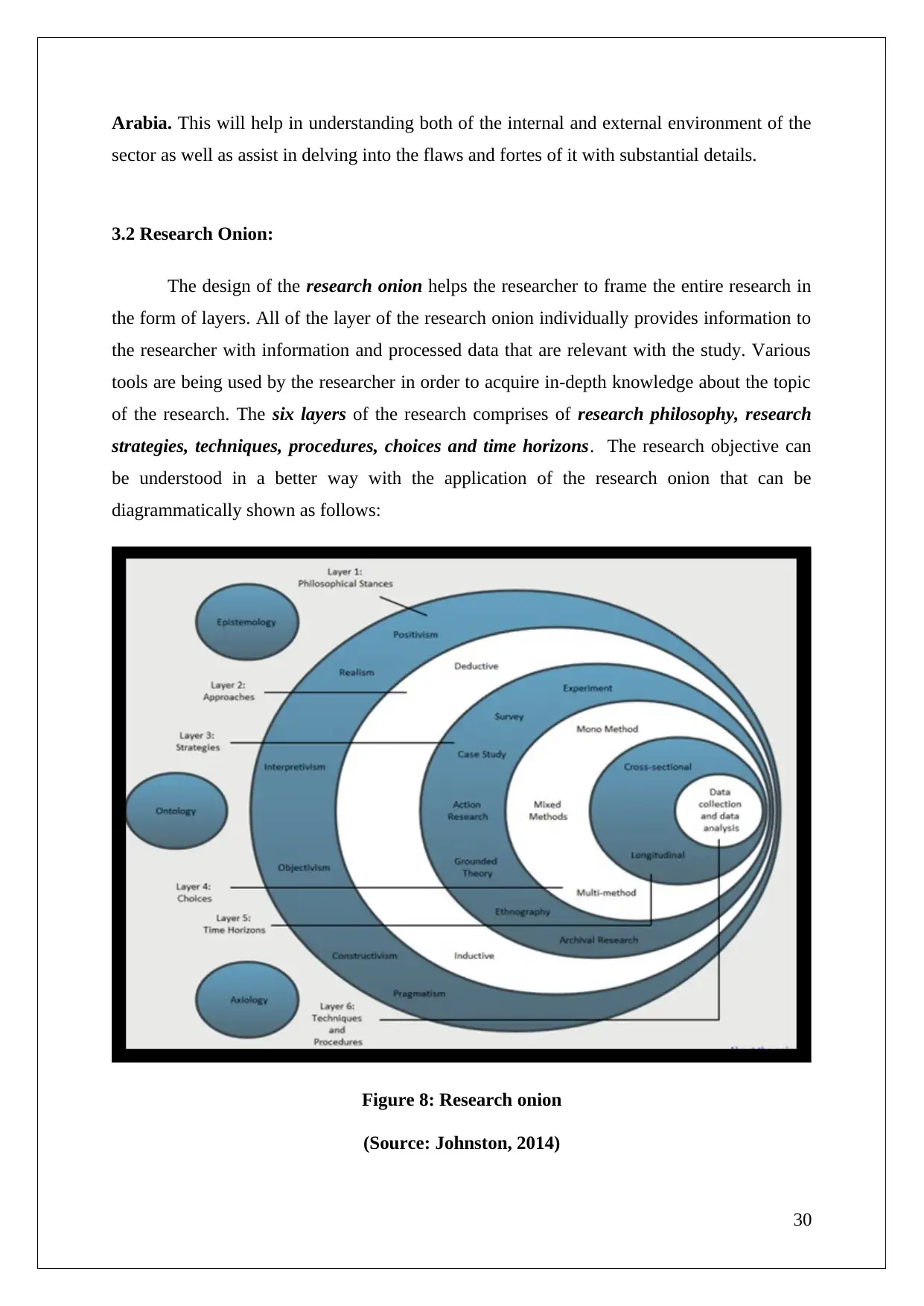
Arabia. This will help in understanding both of the internal and external environment of the
sector as well as assist in delving into the flaws and fortes of it with substantial details.
3.2 Research Onion:
The design of the research onion helps the researcher to frame the entire research in
the form of layers. All of the layer of the research onion individually provides information to
the researcher with information and processed data that are relevant with the study. Various
tools are being used by the researcher in order to acquire in-depth knowledge about the topic
of the research. The six layers of the research comprises of research philosophy, research
strategies, techniques, procedures, choices and time horizons. The research objective can
be understood in a better way with the application of the research onion that can be
diagrammatically shown as follows:
Figure 8: Research onion
(Source: Johnston, 2014)
30
sector as well as assist in delving into the flaws and fortes of it with substantial details.
3.2 Research Onion:
The design of the research onion helps the researcher to frame the entire research in
the form of layers. All of the layer of the research onion individually provides information to
the researcher with information and processed data that are relevant with the study. Various
tools are being used by the researcher in order to acquire in-depth knowledge about the topic
of the research. The six layers of the research comprises of research philosophy, research
strategies, techniques, procedures, choices and time horizons. The research objective can
be understood in a better way with the application of the research onion that can be
diagrammatically shown as follows:
Figure 8: Research onion
(Source: Johnston, 2014)
30
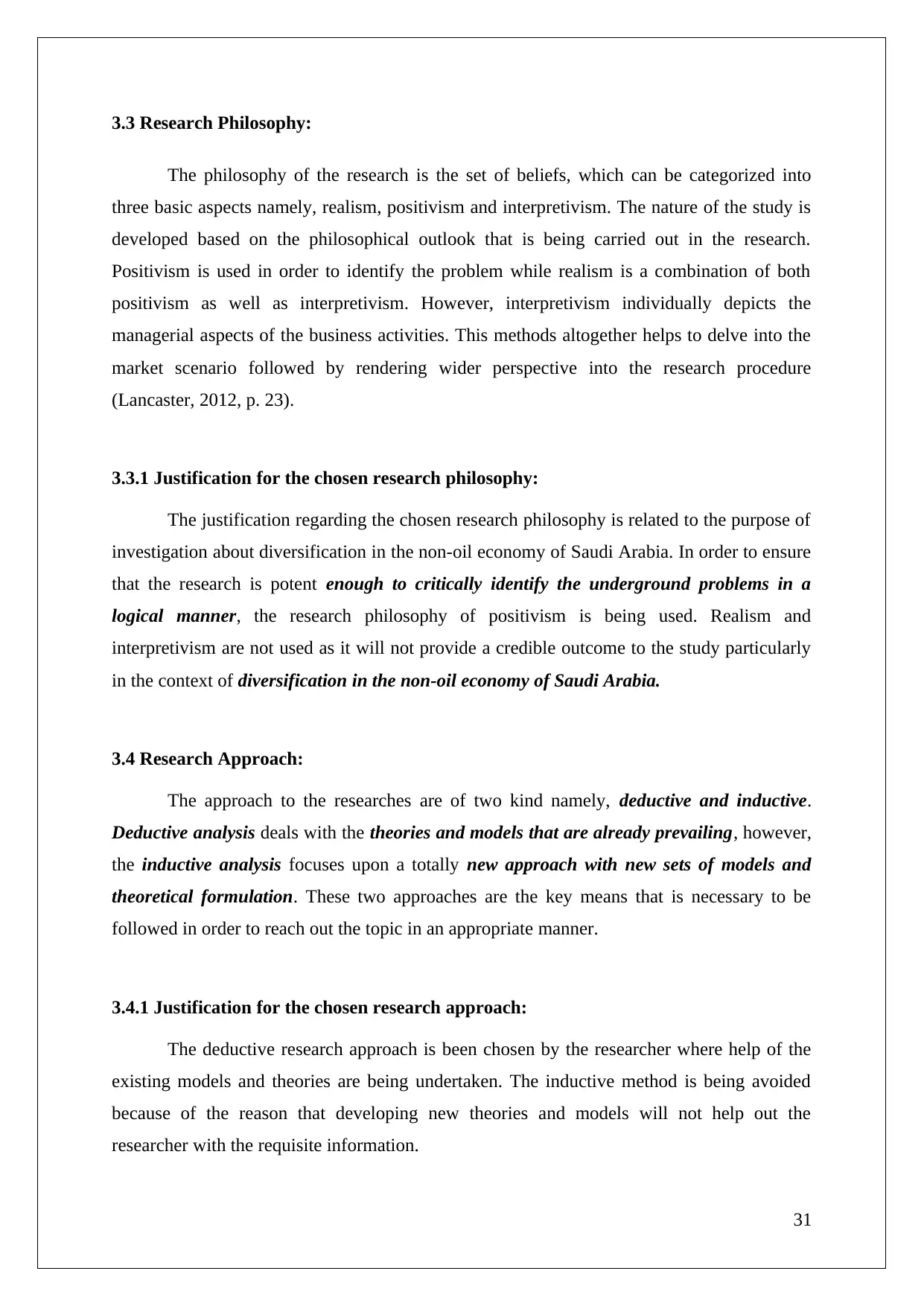
3.3 Research Philosophy:
The philosophy of the research is the set of beliefs, which can be categorized into
three basic aspects namely, realism, positivism and interpretivism. The nature of the study is
developed based on the philosophical outlook that is being carried out in the research.
Positivism is used in order to identify the problem while realism is a combination of both
positivism as well as interpretivism. However, interpretivism individually depicts the
managerial aspects of the business activities. This methods altogether helps to delve into the
market scenario followed by rendering wider perspective into the research procedure
(Lancaster, 2012, p. 23).
3.3.1 Justification for the chosen research philosophy:
The justification regarding the chosen research philosophy is related to the purpose of
investigation about diversification in the non-oil economy of Saudi Arabia. In order to ensure
that the research is potent enough to critically identify the underground problems in a
logical manner, the research philosophy of positivism is being used. Realism and
interpretivism are not used as it will not provide a credible outcome to the study particularly
in the context of diversification in the non-oil economy of Saudi Arabia.
3.4 Research Approach:
The approach to the researches are of two kind namely, deductive and inductive.
Deductive analysis deals with the theories and models that are already prevailing, however,
the inductive analysis focuses upon a totally new approach with new sets of models and
theoretical formulation. These two approaches are the key means that is necessary to be
followed in order to reach out the topic in an appropriate manner.
3.4.1 Justification for the chosen research approach:
The deductive research approach is been chosen by the researcher where help of the
existing models and theories are being undertaken. The inductive method is being avoided
because of the reason that developing new theories and models will not help out the
researcher with the requisite information.
31
The philosophy of the research is the set of beliefs, which can be categorized into
three basic aspects namely, realism, positivism and interpretivism. The nature of the study is
developed based on the philosophical outlook that is being carried out in the research.
Positivism is used in order to identify the problem while realism is a combination of both
positivism as well as interpretivism. However, interpretivism individually depicts the
managerial aspects of the business activities. This methods altogether helps to delve into the
market scenario followed by rendering wider perspective into the research procedure
(Lancaster, 2012, p. 23).
3.3.1 Justification for the chosen research philosophy:
The justification regarding the chosen research philosophy is related to the purpose of
investigation about diversification in the non-oil economy of Saudi Arabia. In order to ensure
that the research is potent enough to critically identify the underground problems in a
logical manner, the research philosophy of positivism is being used. Realism and
interpretivism are not used as it will not provide a credible outcome to the study particularly
in the context of diversification in the non-oil economy of Saudi Arabia.
3.4 Research Approach:
The approach to the researches are of two kind namely, deductive and inductive.
Deductive analysis deals with the theories and models that are already prevailing, however,
the inductive analysis focuses upon a totally new approach with new sets of models and
theoretical formulation. These two approaches are the key means that is necessary to be
followed in order to reach out the topic in an appropriate manner.
3.4.1 Justification for the chosen research approach:
The deductive research approach is been chosen by the researcher where help of the
existing models and theories are being undertaken. The inductive method is being avoided
because of the reason that developing new theories and models will not help out the
researcher with the requisite information.
31
Paraphrase This Document
Need a fresh take? Get an instant paraphrase of this document with our AI Paraphraser
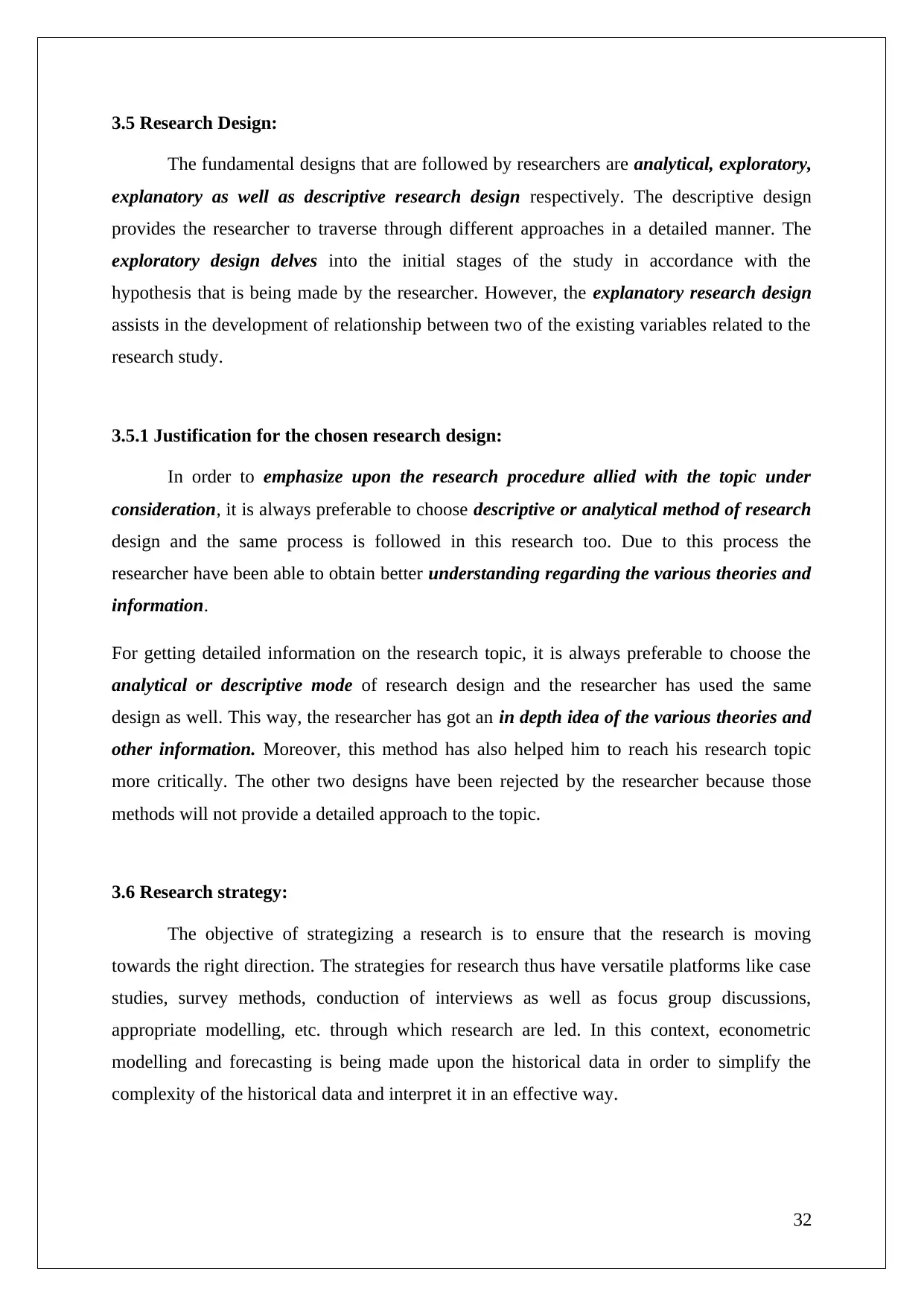
3.5 Research Design:
The fundamental designs that are followed by researchers are analytical, exploratory,
explanatory as well as descriptive research design respectively. The descriptive design
provides the researcher to traverse through different approaches in a detailed manner. The
exploratory design delves into the initial stages of the study in accordance with the
hypothesis that is being made by the researcher. However, the explanatory research design
assists in the development of relationship between two of the existing variables related to the
research study.
3.5.1 Justification for the chosen research design:
In order to emphasize upon the research procedure allied with the topic under
consideration, it is always preferable to choose descriptive or analytical method of research
design and the same process is followed in this research too. Due to this process the
researcher have been able to obtain better understanding regarding the various theories and
information.
For getting detailed information on the research topic, it is always preferable to choose the
analytical or descriptive mode of research design and the researcher has used the same
design as well. This way, the researcher has got an in depth idea of the various theories and
other information. Moreover, this method has also helped him to reach his research topic
more critically. The other two designs have been rejected by the researcher because those
methods will not provide a detailed approach to the topic.
3.6 Research strategy:
The objective of strategizing a research is to ensure that the research is moving
towards the right direction. The strategies for research thus have versatile platforms like case
studies, survey methods, conduction of interviews as well as focus group discussions,
appropriate modelling, etc. through which research are led. In this context, econometric
modelling and forecasting is being made upon the historical data in order to simplify the
complexity of the historical data and interpret it in an effective way.
32
The fundamental designs that are followed by researchers are analytical, exploratory,
explanatory as well as descriptive research design respectively. The descriptive design
provides the researcher to traverse through different approaches in a detailed manner. The
exploratory design delves into the initial stages of the study in accordance with the
hypothesis that is being made by the researcher. However, the explanatory research design
assists in the development of relationship between two of the existing variables related to the
research study.
3.5.1 Justification for the chosen research design:
In order to emphasize upon the research procedure allied with the topic under
consideration, it is always preferable to choose descriptive or analytical method of research
design and the same process is followed in this research too. Due to this process the
researcher have been able to obtain better understanding regarding the various theories and
information.
For getting detailed information on the research topic, it is always preferable to choose the
analytical or descriptive mode of research design and the researcher has used the same
design as well. This way, the researcher has got an in depth idea of the various theories and
other information. Moreover, this method has also helped him to reach his research topic
more critically. The other two designs have been rejected by the researcher because those
methods will not provide a detailed approach to the topic.
3.6 Research strategy:
The objective of strategizing a research is to ensure that the research is moving
towards the right direction. The strategies for research thus have versatile platforms like case
studies, survey methods, conduction of interviews as well as focus group discussions,
appropriate modelling, etc. through which research are led. In this context, econometric
modelling and forecasting is being made upon the historical data in order to simplify the
complexity of the historical data and interpret it in an effective way.
32
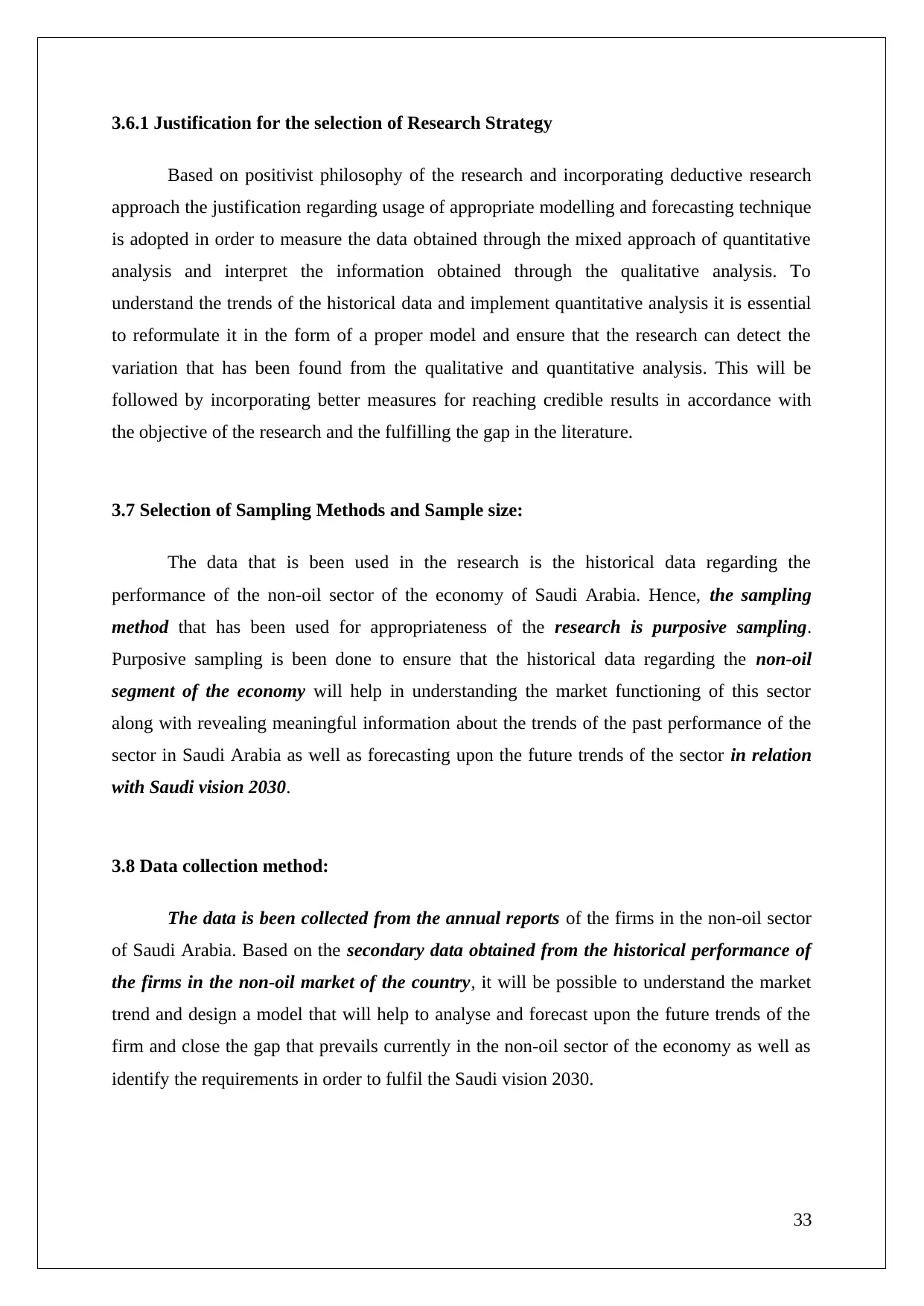
3.6.1 Justification for the selection of Research Strategy
Based on positivist philosophy of the research and incorporating deductive research
approach the justification regarding usage of appropriate modelling and forecasting technique
is adopted in order to measure the data obtained through the mixed approach of quantitative
analysis and interpret the information obtained through the qualitative analysis. To
understand the trends of the historical data and implement quantitative analysis it is essential
to reformulate it in the form of a proper model and ensure that the research can detect the
variation that has been found from the qualitative and quantitative analysis. This will be
followed by incorporating better measures for reaching credible results in accordance with
the objective of the research and the fulfilling the gap in the literature.
3.7 Selection of Sampling Methods and Sample size:
The data that is been used in the research is the historical data regarding the
performance of the non-oil sector of the economy of Saudi Arabia. Hence, the sampling
method that has been used for appropriateness of the research is purposive sampling.
Purposive sampling is been done to ensure that the historical data regarding the non-oil
segment of the economy will help in understanding the market functioning of this sector
along with revealing meaningful information about the trends of the past performance of the
sector in Saudi Arabia as well as forecasting upon the future trends of the sector in relation
with Saudi vision 2030.
3.8 Data collection method:
The data is been collected from the annual reports of the firms in the non-oil sector
of Saudi Arabia. Based on the secondary data obtained from the historical performance of
the firms in the non-oil market of the country, it will be possible to understand the market
trend and design a model that will help to analyse and forecast upon the future trends of the
firm and close the gap that prevails currently in the non-oil sector of the economy as well as
identify the requirements in order to fulfil the Saudi vision 2030.
33
Based on positivist philosophy of the research and incorporating deductive research
approach the justification regarding usage of appropriate modelling and forecasting technique
is adopted in order to measure the data obtained through the mixed approach of quantitative
analysis and interpret the information obtained through the qualitative analysis. To
understand the trends of the historical data and implement quantitative analysis it is essential
to reformulate it in the form of a proper model and ensure that the research can detect the
variation that has been found from the qualitative and quantitative analysis. This will be
followed by incorporating better measures for reaching credible results in accordance with
the objective of the research and the fulfilling the gap in the literature.
3.7 Selection of Sampling Methods and Sample size:
The data that is been used in the research is the historical data regarding the
performance of the non-oil sector of the economy of Saudi Arabia. Hence, the sampling
method that has been used for appropriateness of the research is purposive sampling.
Purposive sampling is been done to ensure that the historical data regarding the non-oil
segment of the economy will help in understanding the market functioning of this sector
along with revealing meaningful information about the trends of the past performance of the
sector in Saudi Arabia as well as forecasting upon the future trends of the sector in relation
with Saudi vision 2030.
3.8 Data collection method:
The data is been collected from the annual reports of the firms in the non-oil sector
of Saudi Arabia. Based on the secondary data obtained from the historical performance of
the firms in the non-oil market of the country, it will be possible to understand the market
trend and design a model that will help to analyse and forecast upon the future trends of the
firm and close the gap that prevails currently in the non-oil sector of the economy as well as
identify the requirements in order to fulfil the Saudi vision 2030.
33

3.8.1 Secondary Research:
Primary research data is not possible to obtain regarding the non-oil sector of the
economy and hence secondary research data are being used for quantitative and qualitative
analysis. For processing a set of data that are collected based on secondary information needs
to be supported with facts and figures to ensure authenticity of the research. Along with that,
appropriate sources of articles, journals, etc. are being evaluated to raise the quality of the
research and ensure that the results obtained in the process are credible enough.
3.9 Data analysis:
The analysis of the data is being done through the analysis of information and
processed data from quantitative and qualitative perspective. The qualitative perspective is
inclusive of the situational analysis through SWOT and PESTLE where the strength,
weakness, opportunity and threats are being considered as well as the impact of the
economic, legal, political, environmental, and socio-cultural aspects are evaluated. Apart
from tracking the impact of these external influences, the area of quantitative analysis
invigorates through analysis of the historical data regarding the performance of the non-oil
sector through the usage of the methodological strategies as well as incorporation of the
economic modelling and forecasting techniques applied overtime. On the penultimate stage,
the descriptive statistics are demonstrated with numerical digits and figures coupled with
charts, graphs and tables. Calculation of mean, median, mode as well as standard deviation
accompanied by measure of dispersion helped to ensure successful forecasting of the data.
Comparison is been conducted upon the actual GDP and the potential GDP through the
usage of the output gap analysis. The obtained differences reflects information regarding
the existing level of unemployment in terms of resources and recommends solution through
guiding the economy of the non-oil sector regarding how it can achieve its state of full
employment potential. Finally, the well-known Herfindahl concentration index and the
Normalized-Hirschman concentration Index are being used, the invers of the indices
provides substantial information regarding the extent of diversification within the non-oil
sector of the Saudi Arabian economy (Fattouh and Sen. 2015). The results thus obtained are
being discussed in adherence with the Saudi Vision goals 2030 which helped to assess the
plausibility of the goals as well as feasibility of application of Saudi Vision 2030. The
recommendation is backed with number of policy formulation and it is done in accordance
34
Primary research data is not possible to obtain regarding the non-oil sector of the
economy and hence secondary research data are being used for quantitative and qualitative
analysis. For processing a set of data that are collected based on secondary information needs
to be supported with facts and figures to ensure authenticity of the research. Along with that,
appropriate sources of articles, journals, etc. are being evaluated to raise the quality of the
research and ensure that the results obtained in the process are credible enough.
3.9 Data analysis:
The analysis of the data is being done through the analysis of information and
processed data from quantitative and qualitative perspective. The qualitative perspective is
inclusive of the situational analysis through SWOT and PESTLE where the strength,
weakness, opportunity and threats are being considered as well as the impact of the
economic, legal, political, environmental, and socio-cultural aspects are evaluated. Apart
from tracking the impact of these external influences, the area of quantitative analysis
invigorates through analysis of the historical data regarding the performance of the non-oil
sector through the usage of the methodological strategies as well as incorporation of the
economic modelling and forecasting techniques applied overtime. On the penultimate stage,
the descriptive statistics are demonstrated with numerical digits and figures coupled with
charts, graphs and tables. Calculation of mean, median, mode as well as standard deviation
accompanied by measure of dispersion helped to ensure successful forecasting of the data.
Comparison is been conducted upon the actual GDP and the potential GDP through the
usage of the output gap analysis. The obtained differences reflects information regarding
the existing level of unemployment in terms of resources and recommends solution through
guiding the economy of the non-oil sector regarding how it can achieve its state of full
employment potential. Finally, the well-known Herfindahl concentration index and the
Normalized-Hirschman concentration Index are being used, the invers of the indices
provides substantial information regarding the extent of diversification within the non-oil
sector of the Saudi Arabian economy (Fattouh and Sen. 2015). The results thus obtained are
being discussed in adherence with the Saudi Vision goals 2030 which helped to assess the
plausibility of the goals as well as feasibility of application of Saudi Vision 2030. The
recommendation is backed with number of policy formulation and it is done in accordance
34
Secure Best Marks with AI Grader
Need help grading? Try our AI Grader for instant feedback on your assignments.

with the interpreted ta that are being obtained though the analysis if the historical time series
data and their corresponding time series forecasting through software like EXCEL. The
software is used for the non-parametric as well as parametric tests with wide range of
descriptive statistics and research hypothesis. Moreover, different themes and patterns are
identified that emerged from the analysis in order to understand the performance of the
non-oil sector of Saudi Arabian Economy.
3.10 Research ethical consideration:
Strict ethical guidance is being maintained within the study of the research which
ensures the fact that no such unethical means are being incorporated to reduce the quality of
the research and thus ensuring that the research is a significant approach in the process of
creating a credible research analysis. The research is being conducted taking under
consideration the legal aspects of the research as well as maintaining the authenticity of the
research so that credible solution can be put forth in this particular field upon which the
research is being conducted. It is also being kept in mind that the aim of the research is purely
for academic purpose and hence it is not any kind of promotional act that will breach the
codes of research ethics.
3.11. Research limitation:
The limitation of the research is related to the inability of the research in acquiring
primary data upon the non-oil sector of Saudi Arabian economy. The selection of secondary
data is the raw inputs of research is being considered due to this reason and hence there is
presence of slight biasness in the results of the study towards the source of secondary data.
Notably, the data has being acquired from the authentic data source of World Bank and IMF
regarding the non – oil sector of Saudi Arabian economy.
3.12 Time horizon:
The bifurcation of the work is being made in accordance with the research needs and
in convenience with the researcher’s ability to obtain data and commence the research in a
significant manner. The major priority is being given to the acquisition of data with
35
data and their corresponding time series forecasting through software like EXCEL. The
software is used for the non-parametric as well as parametric tests with wide range of
descriptive statistics and research hypothesis. Moreover, different themes and patterns are
identified that emerged from the analysis in order to understand the performance of the
non-oil sector of Saudi Arabian Economy.
3.10 Research ethical consideration:
Strict ethical guidance is being maintained within the study of the research which
ensures the fact that no such unethical means are being incorporated to reduce the quality of
the research and thus ensuring that the research is a significant approach in the process of
creating a credible research analysis. The research is being conducted taking under
consideration the legal aspects of the research as well as maintaining the authenticity of the
research so that credible solution can be put forth in this particular field upon which the
research is being conducted. It is also being kept in mind that the aim of the research is purely
for academic purpose and hence it is not any kind of promotional act that will breach the
codes of research ethics.
3.11. Research limitation:
The limitation of the research is related to the inability of the research in acquiring
primary data upon the non-oil sector of Saudi Arabian economy. The selection of secondary
data is the raw inputs of research is being considered due to this reason and hence there is
presence of slight biasness in the results of the study towards the source of secondary data.
Notably, the data has being acquired from the authentic data source of World Bank and IMF
regarding the non – oil sector of Saudi Arabian economy.
3.12 Time horizon:
The bifurcation of the work is being made in accordance with the research needs and
in convenience with the researcher’s ability to obtain data and commence the research in a
significant manner. The major priority is being given to the acquisition of data with
35
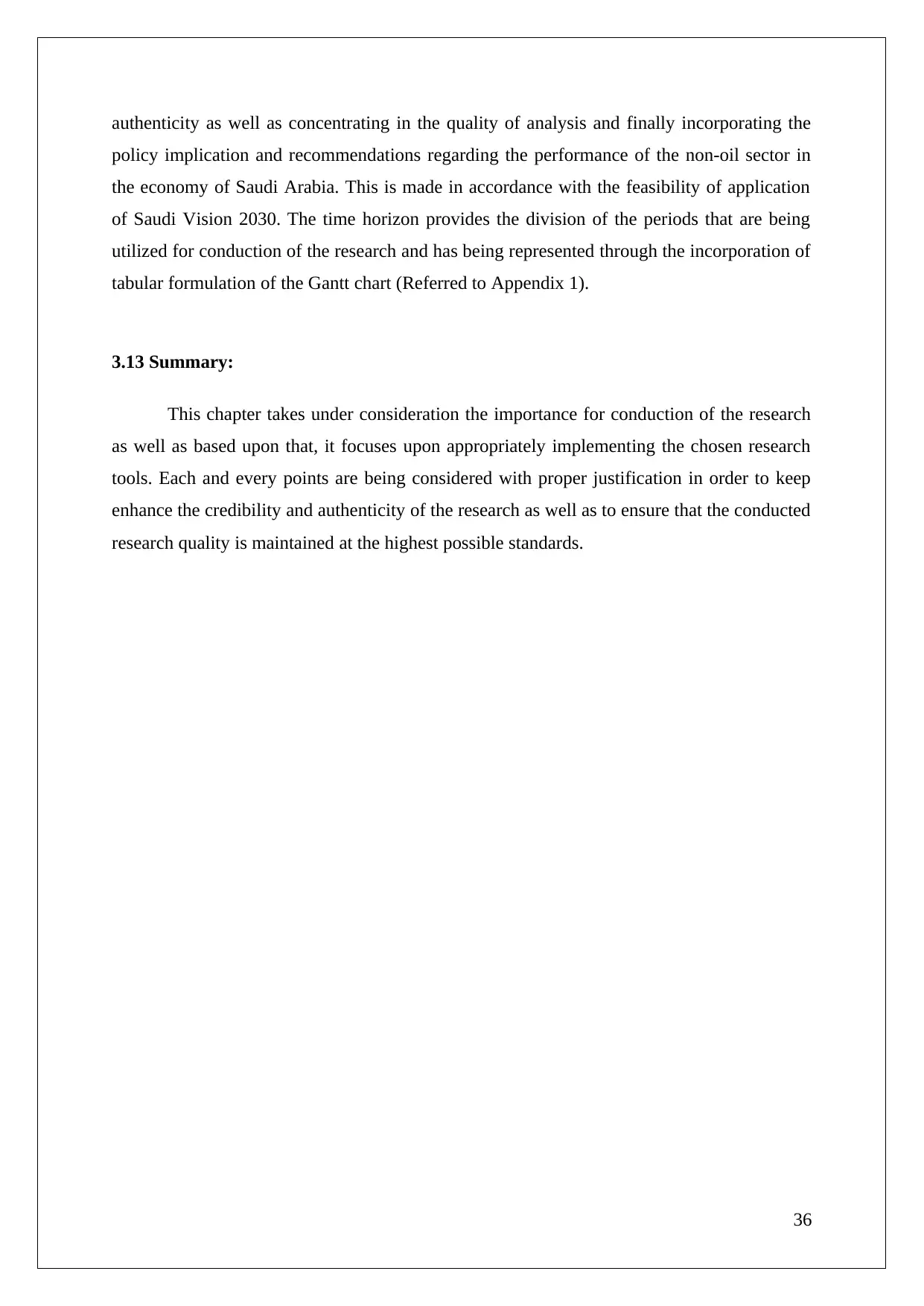
authenticity as well as concentrating in the quality of analysis and finally incorporating the
policy implication and recommendations regarding the performance of the non-oil sector in
the economy of Saudi Arabia. This is made in accordance with the feasibility of application
of Saudi Vision 2030. The time horizon provides the division of the periods that are being
utilized for conduction of the research and has being represented through the incorporation of
tabular formulation of the Gantt chart (Referred to Appendix 1).
3.13 Summary:
This chapter takes under consideration the importance for conduction of the research
as well as based upon that, it focuses upon appropriately implementing the chosen research
tools. Each and every points are being considered with proper justification in order to keep
enhance the credibility and authenticity of the research as well as to ensure that the conducted
research quality is maintained at the highest possible standards.
36
policy implication and recommendations regarding the performance of the non-oil sector in
the economy of Saudi Arabia. This is made in accordance with the feasibility of application
of Saudi Vision 2030. The time horizon provides the division of the periods that are being
utilized for conduction of the research and has being represented through the incorporation of
tabular formulation of the Gantt chart (Referred to Appendix 1).
3.13 Summary:
This chapter takes under consideration the importance for conduction of the research
as well as based upon that, it focuses upon appropriately implementing the chosen research
tools. Each and every points are being considered with proper justification in order to keep
enhance the credibility and authenticity of the research as well as to ensure that the conducted
research quality is maintained at the highest possible standards.
36
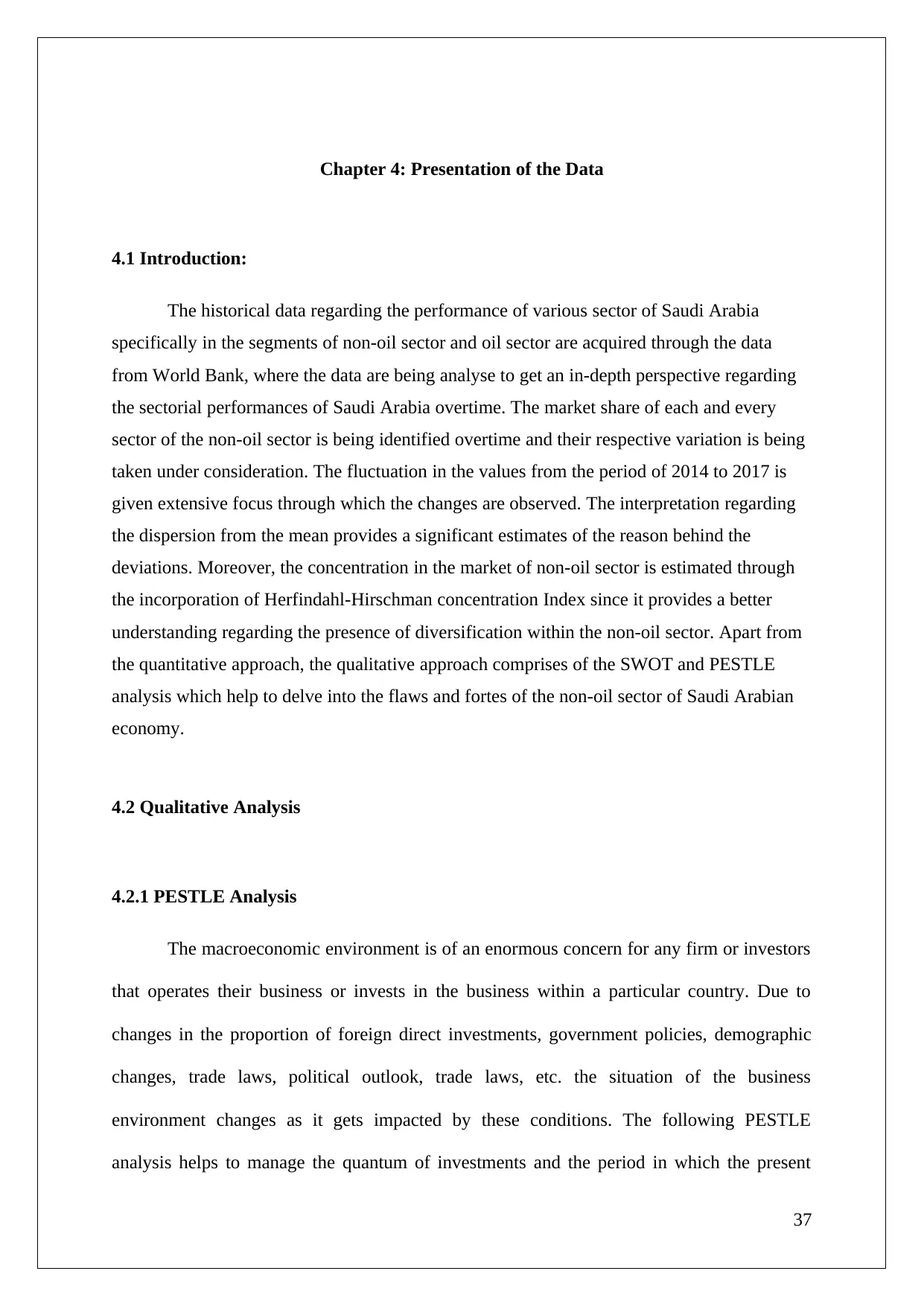
Chapter 4: Presentation of the Data
4.1 Introduction:
The historical data regarding the performance of various sector of Saudi Arabia
specifically in the segments of non-oil sector and oil sector are acquired through the data
from World Bank, where the data are being analyse to get an in-depth perspective regarding
the sectorial performances of Saudi Arabia overtime. The market share of each and every
sector of the non-oil sector is being identified overtime and their respective variation is being
taken under consideration. The fluctuation in the values from the period of 2014 to 2017 is
given extensive focus through which the changes are observed. The interpretation regarding
the dispersion from the mean provides a significant estimates of the reason behind the
deviations. Moreover, the concentration in the market of non-oil sector is estimated through
the incorporation of Herfindahl-Hirschman concentration Index since it provides a better
understanding regarding the presence of diversification within the non-oil sector. Apart from
the quantitative approach, the qualitative approach comprises of the SWOT and PESTLE
analysis which help to delve into the flaws and fortes of the non-oil sector of Saudi Arabian
economy.
4.2 Qualitative Analysis
4.2.1 PESTLE Analysis
The macroeconomic environment is of an enormous concern for any firm or investors
that operates their business or invests in the business within a particular country. Due to
changes in the proportion of foreign direct investments, government policies, demographic
changes, trade laws, political outlook, trade laws, etc. the situation of the business
environment changes as it gets impacted by these conditions. The following PESTLE
analysis helps to manage the quantum of investments and the period in which the present
37
4.1 Introduction:
The historical data regarding the performance of various sector of Saudi Arabia
specifically in the segments of non-oil sector and oil sector are acquired through the data
from World Bank, where the data are being analyse to get an in-depth perspective regarding
the sectorial performances of Saudi Arabia overtime. The market share of each and every
sector of the non-oil sector is being identified overtime and their respective variation is being
taken under consideration. The fluctuation in the values from the period of 2014 to 2017 is
given extensive focus through which the changes are observed. The interpretation regarding
the dispersion from the mean provides a significant estimates of the reason behind the
deviations. Moreover, the concentration in the market of non-oil sector is estimated through
the incorporation of Herfindahl-Hirschman concentration Index since it provides a better
understanding regarding the presence of diversification within the non-oil sector. Apart from
the quantitative approach, the qualitative approach comprises of the SWOT and PESTLE
analysis which help to delve into the flaws and fortes of the non-oil sector of Saudi Arabian
economy.
4.2 Qualitative Analysis
4.2.1 PESTLE Analysis
The macroeconomic environment is of an enormous concern for any firm or investors
that operates their business or invests in the business within a particular country. Due to
changes in the proportion of foreign direct investments, government policies, demographic
changes, trade laws, political outlook, trade laws, etc. the situation of the business
environment changes as it gets impacted by these conditions. The following PESTLE
analysis helps to manage the quantum of investments and the period in which the present
37
Paraphrase This Document
Need a fresh take? Get an instant paraphrase of this document with our AI Paraphraser
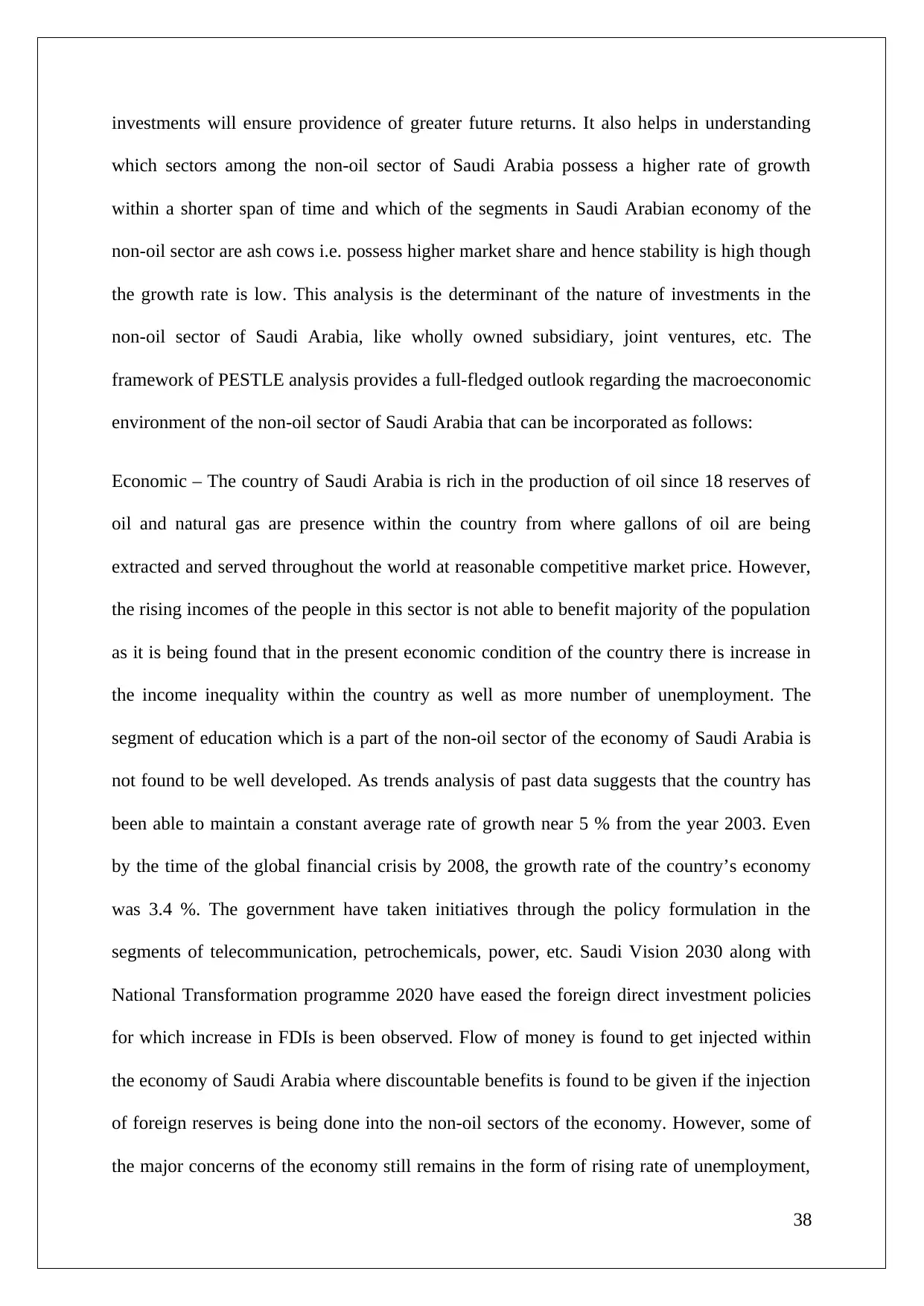
investments will ensure providence of greater future returns. It also helps in understanding
which sectors among the non-oil sector of Saudi Arabia possess a higher rate of growth
within a shorter span of time and which of the segments in Saudi Arabian economy of the
non-oil sector are ash cows i.e. possess higher market share and hence stability is high though
the growth rate is low. This analysis is the determinant of the nature of investments in the
non-oil sector of Saudi Arabia, like wholly owned subsidiary, joint ventures, etc. The
framework of PESTLE analysis provides a full-fledged outlook regarding the macroeconomic
environment of the non-oil sector of Saudi Arabia that can be incorporated as follows:
Economic – The country of Saudi Arabia is rich in the production of oil since 18 reserves of
oil and natural gas are presence within the country from where gallons of oil are being
extracted and served throughout the world at reasonable competitive market price. However,
the rising incomes of the people in this sector is not able to benefit majority of the population
as it is being found that in the present economic condition of the country there is increase in
the income inequality within the country as well as more number of unemployment. The
segment of education which is a part of the non-oil sector of the economy of Saudi Arabia is
not found to be well developed. As trends analysis of past data suggests that the country has
been able to maintain a constant average rate of growth near 5 % from the year 2003. Even
by the time of the global financial crisis by 2008, the growth rate of the country’s economy
was 3.4 %. The government have taken initiatives through the policy formulation in the
segments of telecommunication, petrochemicals, power, etc. Saudi Vision 2030 along with
National Transformation programme 2020 have eased the foreign direct investment policies
for which increase in FDIs is been observed. Flow of money is found to get injected within
the economy of Saudi Arabia where discountable benefits is found to be given if the injection
of foreign reserves is being done into the non-oil sectors of the economy. However, some of
the major concerns of the economy still remains in the form of rising rate of unemployment,
38
which sectors among the non-oil sector of Saudi Arabia possess a higher rate of growth
within a shorter span of time and which of the segments in Saudi Arabian economy of the
non-oil sector are ash cows i.e. possess higher market share and hence stability is high though
the growth rate is low. This analysis is the determinant of the nature of investments in the
non-oil sector of Saudi Arabia, like wholly owned subsidiary, joint ventures, etc. The
framework of PESTLE analysis provides a full-fledged outlook regarding the macroeconomic
environment of the non-oil sector of Saudi Arabia that can be incorporated as follows:
Economic – The country of Saudi Arabia is rich in the production of oil since 18 reserves of
oil and natural gas are presence within the country from where gallons of oil are being
extracted and served throughout the world at reasonable competitive market price. However,
the rising incomes of the people in this sector is not able to benefit majority of the population
as it is being found that in the present economic condition of the country there is increase in
the income inequality within the country as well as more number of unemployment. The
segment of education which is a part of the non-oil sector of the economy of Saudi Arabia is
not found to be well developed. As trends analysis of past data suggests that the country has
been able to maintain a constant average rate of growth near 5 % from the year 2003. Even
by the time of the global financial crisis by 2008, the growth rate of the country’s economy
was 3.4 %. The government have taken initiatives through the policy formulation in the
segments of telecommunication, petrochemicals, power, etc. Saudi Vision 2030 along with
National Transformation programme 2020 have eased the foreign direct investment policies
for which increase in FDIs is been observed. Flow of money is found to get injected within
the economy of Saudi Arabia where discountable benefits is found to be given if the injection
of foreign reserves is being done into the non-oil sectors of the economy. However, some of
the major concerns of the economy still remains in the form of rising rate of unemployment,
38
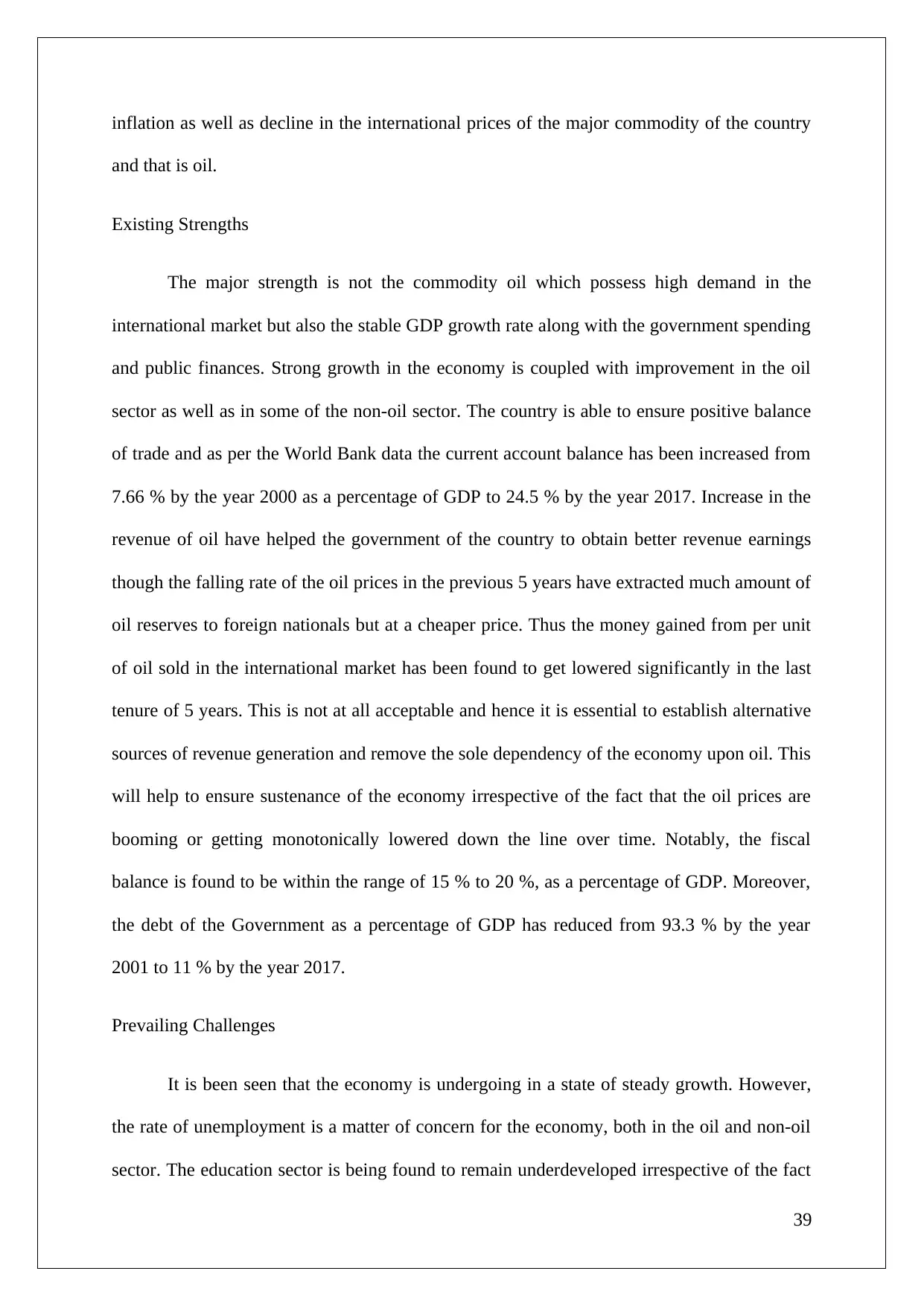
inflation as well as decline in the international prices of the major commodity of the country
and that is oil.
Existing Strengths
The major strength is not the commodity oil which possess high demand in the
international market but also the stable GDP growth rate along with the government spending
and public finances. Strong growth in the economy is coupled with improvement in the oil
sector as well as in some of the non-oil sector. The country is able to ensure positive balance
of trade and as per the World Bank data the current account balance has been increased from
7.66 % by the year 2000 as a percentage of GDP to 24.5 % by the year 2017. Increase in the
revenue of oil have helped the government of the country to obtain better revenue earnings
though the falling rate of the oil prices in the previous 5 years have extracted much amount of
oil reserves to foreign nationals but at a cheaper price. Thus the money gained from per unit
of oil sold in the international market has been found to get lowered significantly in the last
tenure of 5 years. This is not at all acceptable and hence it is essential to establish alternative
sources of revenue generation and remove the sole dependency of the economy upon oil. This
will help to ensure sustenance of the economy irrespective of the fact that the oil prices are
booming or getting monotonically lowered down the line over time. Notably, the fiscal
balance is found to be within the range of 15 % to 20 %, as a percentage of GDP. Moreover,
the debt of the Government as a percentage of GDP has reduced from 93.3 % by the year
2001 to 11 % by the year 2017.
Prevailing Challenges
It is been seen that the economy is undergoing in a state of steady growth. However,
the rate of unemployment is a matter of concern for the economy, both in the oil and non-oil
sector. The education sector is being found to remain underdeveloped irrespective of the fact
39
and that is oil.
Existing Strengths
The major strength is not the commodity oil which possess high demand in the
international market but also the stable GDP growth rate along with the government spending
and public finances. Strong growth in the economy is coupled with improvement in the oil
sector as well as in some of the non-oil sector. The country is able to ensure positive balance
of trade and as per the World Bank data the current account balance has been increased from
7.66 % by the year 2000 as a percentage of GDP to 24.5 % by the year 2017. Increase in the
revenue of oil have helped the government of the country to obtain better revenue earnings
though the falling rate of the oil prices in the previous 5 years have extracted much amount of
oil reserves to foreign nationals but at a cheaper price. Thus the money gained from per unit
of oil sold in the international market has been found to get lowered significantly in the last
tenure of 5 years. This is not at all acceptable and hence it is essential to establish alternative
sources of revenue generation and remove the sole dependency of the economy upon oil. This
will help to ensure sustenance of the economy irrespective of the fact that the oil prices are
booming or getting monotonically lowered down the line over time. Notably, the fiscal
balance is found to be within the range of 15 % to 20 %, as a percentage of GDP. Moreover,
the debt of the Government as a percentage of GDP has reduced from 93.3 % by the year
2001 to 11 % by the year 2017.
Prevailing Challenges
It is been seen that the economy is undergoing in a state of steady growth. However,
the rate of unemployment is a matter of concern for the economy, both in the oil and non-oil
sector. The education sector is being found to remain underdeveloped irrespective of the fact
39
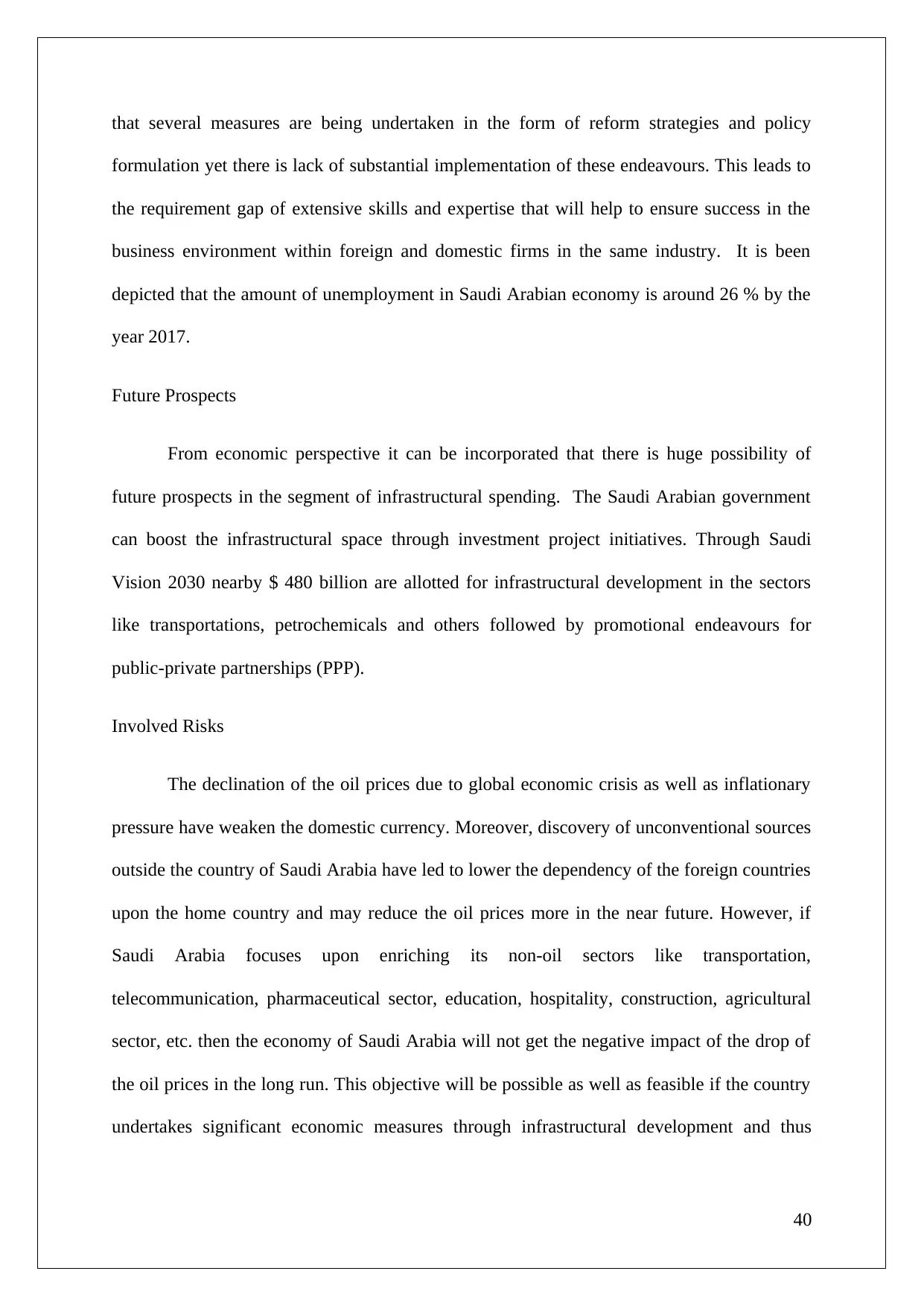
that several measures are being undertaken in the form of reform strategies and policy
formulation yet there is lack of substantial implementation of these endeavours. This leads to
the requirement gap of extensive skills and expertise that will help to ensure success in the
business environment within foreign and domestic firms in the same industry. It is been
depicted that the amount of unemployment in Saudi Arabian economy is around 26 % by the
year 2017.
Future Prospects
From economic perspective it can be incorporated that there is huge possibility of
future prospects in the segment of infrastructural spending. The Saudi Arabian government
can boost the infrastructural space through investment project initiatives. Through Saudi
Vision 2030 nearby $ 480 billion are allotted for infrastructural development in the sectors
like transportations, petrochemicals and others followed by promotional endeavours for
public-private partnerships (PPP).
Involved Risks
The declination of the oil prices due to global economic crisis as well as inflationary
pressure have weaken the domestic currency. Moreover, discovery of unconventional sources
outside the country of Saudi Arabia have led to lower the dependency of the foreign countries
upon the home country and may reduce the oil prices more in the near future. However, if
Saudi Arabia focuses upon enriching its non-oil sectors like transportation,
telecommunication, pharmaceutical sector, education, hospitality, construction, agricultural
sector, etc. then the economy of Saudi Arabia will not get the negative impact of the drop of
the oil prices in the long run. This objective will be possible as well as feasible if the country
undertakes significant economic measures through infrastructural development and thus
40
formulation yet there is lack of substantial implementation of these endeavours. This leads to
the requirement gap of extensive skills and expertise that will help to ensure success in the
business environment within foreign and domestic firms in the same industry. It is been
depicted that the amount of unemployment in Saudi Arabian economy is around 26 % by the
year 2017.
Future Prospects
From economic perspective it can be incorporated that there is huge possibility of
future prospects in the segment of infrastructural spending. The Saudi Arabian government
can boost the infrastructural space through investment project initiatives. Through Saudi
Vision 2030 nearby $ 480 billion are allotted for infrastructural development in the sectors
like transportations, petrochemicals and others followed by promotional endeavours for
public-private partnerships (PPP).
Involved Risks
The declination of the oil prices due to global economic crisis as well as inflationary
pressure have weaken the domestic currency. Moreover, discovery of unconventional sources
outside the country of Saudi Arabia have led to lower the dependency of the foreign countries
upon the home country and may reduce the oil prices more in the near future. However, if
Saudi Arabia focuses upon enriching its non-oil sectors like transportation,
telecommunication, pharmaceutical sector, education, hospitality, construction, agricultural
sector, etc. then the economy of Saudi Arabia will not get the negative impact of the drop of
the oil prices in the long run. This objective will be possible as well as feasible if the country
undertakes significant economic measures through infrastructural development and thus
40
Secure Best Marks with AI Grader
Need help grading? Try our AI Grader for instant feedback on your assignments.
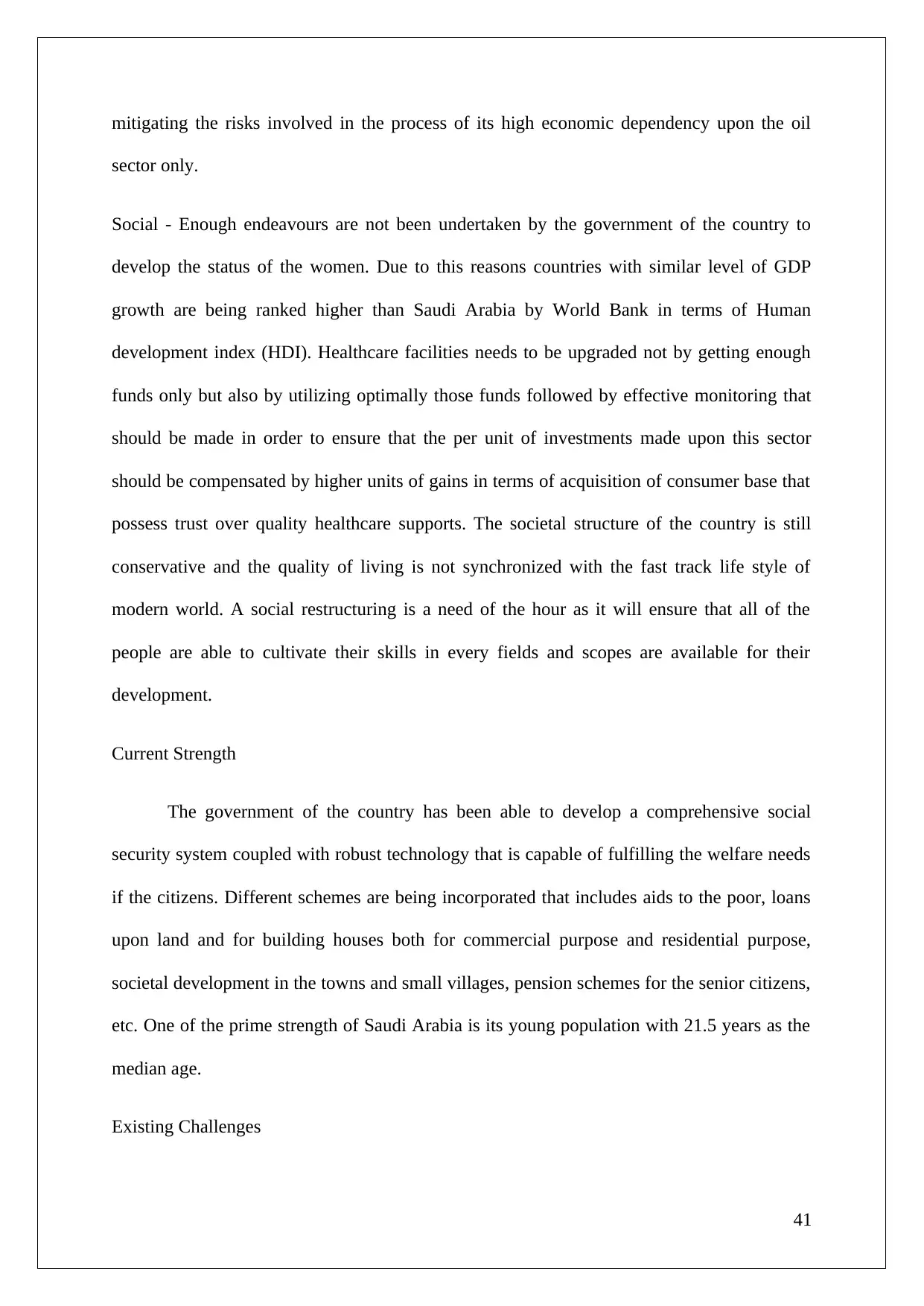
mitigating the risks involved in the process of its high economic dependency upon the oil
sector only.
Social - Enough endeavours are not been undertaken by the government of the country to
develop the status of the women. Due to this reasons countries with similar level of GDP
growth are being ranked higher than Saudi Arabia by World Bank in terms of Human
development index (HDI). Healthcare facilities needs to be upgraded not by getting enough
funds only but also by utilizing optimally those funds followed by effective monitoring that
should be made in order to ensure that the per unit of investments made upon this sector
should be compensated by higher units of gains in terms of acquisition of consumer base that
possess trust over quality healthcare supports. The societal structure of the country is still
conservative and the quality of living is not synchronized with the fast track life style of
modern world. A social restructuring is a need of the hour as it will ensure that all of the
people are able to cultivate their skills in every fields and scopes are available for their
development.
Current Strength
The government of the country has been able to develop a comprehensive social
security system coupled with robust technology that is capable of fulfilling the welfare needs
if the citizens. Different schemes are being incorporated that includes aids to the poor, loans
upon land and for building houses both for commercial purpose and residential purpose,
societal development in the towns and small villages, pension schemes for the senior citizens,
etc. One of the prime strength of Saudi Arabia is its young population with 21.5 years as the
median age.
Existing Challenges
41
sector only.
Social - Enough endeavours are not been undertaken by the government of the country to
develop the status of the women. Due to this reasons countries with similar level of GDP
growth are being ranked higher than Saudi Arabia by World Bank in terms of Human
development index (HDI). Healthcare facilities needs to be upgraded not by getting enough
funds only but also by utilizing optimally those funds followed by effective monitoring that
should be made in order to ensure that the per unit of investments made upon this sector
should be compensated by higher units of gains in terms of acquisition of consumer base that
possess trust over quality healthcare supports. The societal structure of the country is still
conservative and the quality of living is not synchronized with the fast track life style of
modern world. A social restructuring is a need of the hour as it will ensure that all of the
people are able to cultivate their skills in every fields and scopes are available for their
development.
Current Strength
The government of the country has been able to develop a comprehensive social
security system coupled with robust technology that is capable of fulfilling the welfare needs
if the citizens. Different schemes are being incorporated that includes aids to the poor, loans
upon land and for building houses both for commercial purpose and residential purpose,
societal development in the towns and small villages, pension schemes for the senior citizens,
etc. One of the prime strength of Saudi Arabia is its young population with 21.5 years as the
median age.
Existing Challenges
41
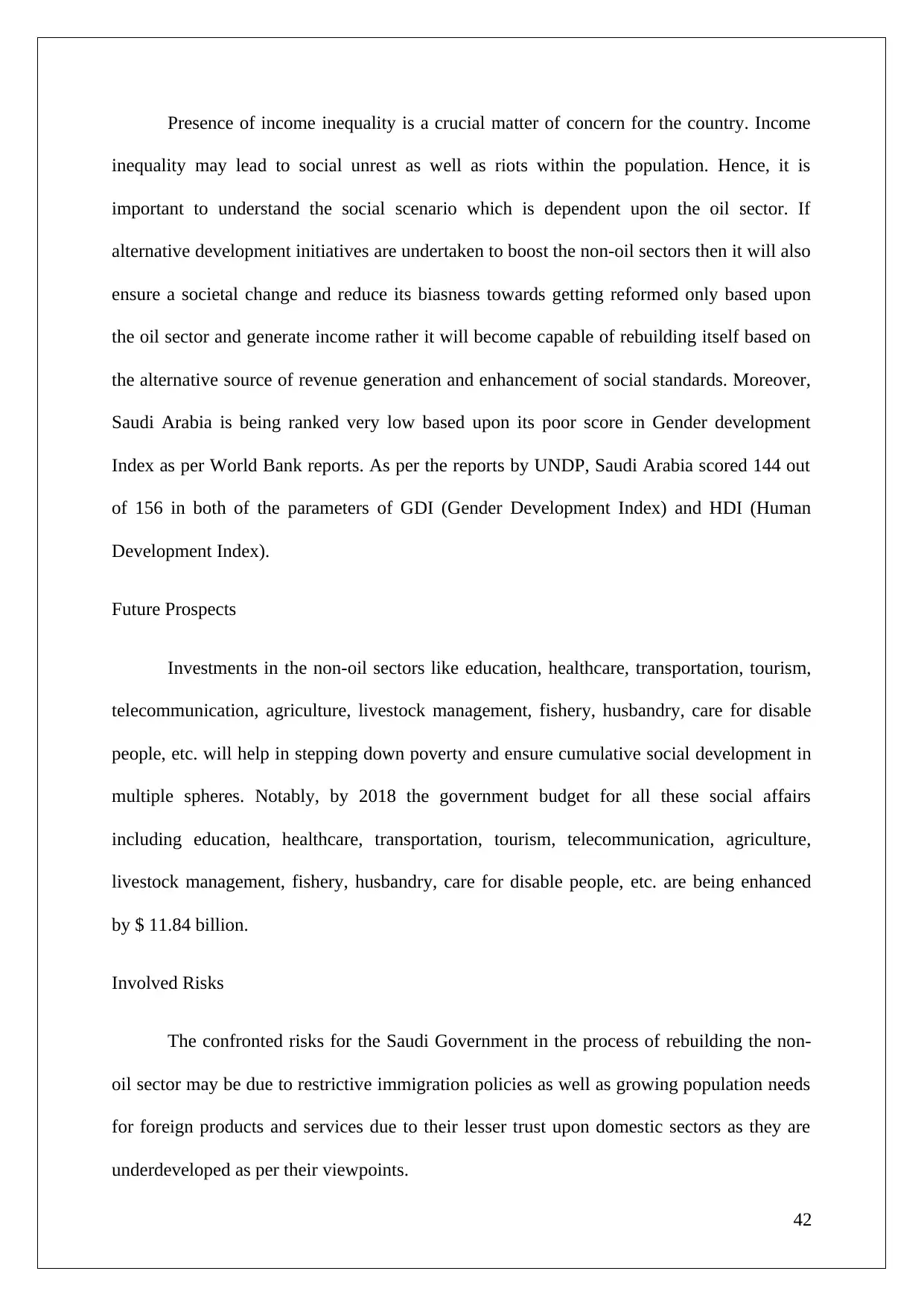
Presence of income inequality is a crucial matter of concern for the country. Income
inequality may lead to social unrest as well as riots within the population. Hence, it is
important to understand the social scenario which is dependent upon the oil sector. If
alternative development initiatives are undertaken to boost the non-oil sectors then it will also
ensure a societal change and reduce its biasness towards getting reformed only based upon
the oil sector and generate income rather it will become capable of rebuilding itself based on
the alternative source of revenue generation and enhancement of social standards. Moreover,
Saudi Arabia is being ranked very low based upon its poor score in Gender development
Index as per World Bank reports. As per the reports by UNDP, Saudi Arabia scored 144 out
of 156 in both of the parameters of GDI (Gender Development Index) and HDI (Human
Development Index).
Future Prospects
Investments in the non-oil sectors like education, healthcare, transportation, tourism,
telecommunication, agriculture, livestock management, fishery, husbandry, care for disable
people, etc. will help in stepping down poverty and ensure cumulative social development in
multiple spheres. Notably, by 2018 the government budget for all these social affairs
including education, healthcare, transportation, tourism, telecommunication, agriculture,
livestock management, fishery, husbandry, care for disable people, etc. are being enhanced
by $ 11.84 billion.
Involved Risks
The confronted risks for the Saudi Government in the process of rebuilding the non-
oil sector may be due to restrictive immigration policies as well as growing population needs
for foreign products and services due to their lesser trust upon domestic sectors as they are
underdeveloped as per their viewpoints.
42
inequality may lead to social unrest as well as riots within the population. Hence, it is
important to understand the social scenario which is dependent upon the oil sector. If
alternative development initiatives are undertaken to boost the non-oil sectors then it will also
ensure a societal change and reduce its biasness towards getting reformed only based upon
the oil sector and generate income rather it will become capable of rebuilding itself based on
the alternative source of revenue generation and enhancement of social standards. Moreover,
Saudi Arabia is being ranked very low based upon its poor score in Gender development
Index as per World Bank reports. As per the reports by UNDP, Saudi Arabia scored 144 out
of 156 in both of the parameters of GDI (Gender Development Index) and HDI (Human
Development Index).
Future Prospects
Investments in the non-oil sectors like education, healthcare, transportation, tourism,
telecommunication, agriculture, livestock management, fishery, husbandry, care for disable
people, etc. will help in stepping down poverty and ensure cumulative social development in
multiple spheres. Notably, by 2018 the government budget for all these social affairs
including education, healthcare, transportation, tourism, telecommunication, agriculture,
livestock management, fishery, husbandry, care for disable people, etc. are being enhanced
by $ 11.84 billion.
Involved Risks
The confronted risks for the Saudi Government in the process of rebuilding the non-
oil sector may be due to restrictive immigration policies as well as growing population needs
for foreign products and services due to their lesser trust upon domestic sectors as they are
underdeveloped as per their viewpoints.
42
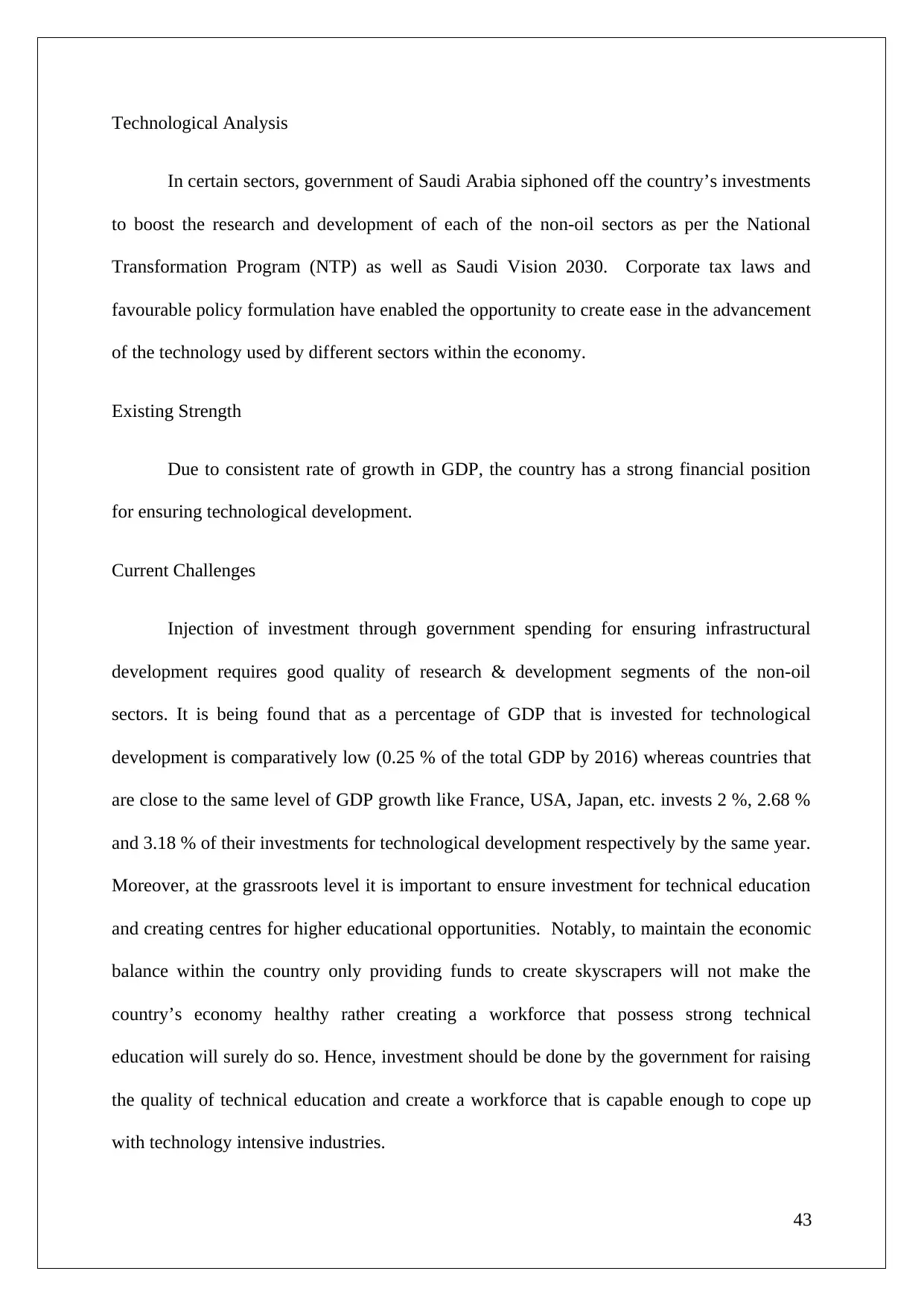
Technological Analysis
In certain sectors, government of Saudi Arabia siphoned off the country’s investments
to boost the research and development of each of the non-oil sectors as per the National
Transformation Program (NTP) as well as Saudi Vision 2030. Corporate tax laws and
favourable policy formulation have enabled the opportunity to create ease in the advancement
of the technology used by different sectors within the economy.
Existing Strength
Due to consistent rate of growth in GDP, the country has a strong financial position
for ensuring technological development.
Current Challenges
Injection of investment through government spending for ensuring infrastructural
development requires good quality of research & development segments of the non-oil
sectors. It is being found that as a percentage of GDP that is invested for technological
development is comparatively low (0.25 % of the total GDP by 2016) whereas countries that
are close to the same level of GDP growth like France, USA, Japan, etc. invests 2 %, 2.68 %
and 3.18 % of their investments for technological development respectively by the same year.
Moreover, at the grassroots level it is important to ensure investment for technical education
and creating centres for higher educational opportunities. Notably, to maintain the economic
balance within the country only providing funds to create skyscrapers will not make the
country’s economy healthy rather creating a workforce that possess strong technical
education will surely do so. Hence, investment should be done by the government for raising
the quality of technical education and create a workforce that is capable enough to cope up
with technology intensive industries.
43
In certain sectors, government of Saudi Arabia siphoned off the country’s investments
to boost the research and development of each of the non-oil sectors as per the National
Transformation Program (NTP) as well as Saudi Vision 2030. Corporate tax laws and
favourable policy formulation have enabled the opportunity to create ease in the advancement
of the technology used by different sectors within the economy.
Existing Strength
Due to consistent rate of growth in GDP, the country has a strong financial position
for ensuring technological development.
Current Challenges
Injection of investment through government spending for ensuring infrastructural
development requires good quality of research & development segments of the non-oil
sectors. It is being found that as a percentage of GDP that is invested for technological
development is comparatively low (0.25 % of the total GDP by 2016) whereas countries that
are close to the same level of GDP growth like France, USA, Japan, etc. invests 2 %, 2.68 %
and 3.18 % of their investments for technological development respectively by the same year.
Moreover, at the grassroots level it is important to ensure investment for technical education
and creating centres for higher educational opportunities. Notably, to maintain the economic
balance within the country only providing funds to create skyscrapers will not make the
country’s economy healthy rather creating a workforce that possess strong technical
education will surely do so. Hence, investment should be done by the government for raising
the quality of technical education and create a workforce that is capable enough to cope up
with technology intensive industries.
43
Paraphrase This Document
Need a fresh take? Get an instant paraphrase of this document with our AI Paraphraser
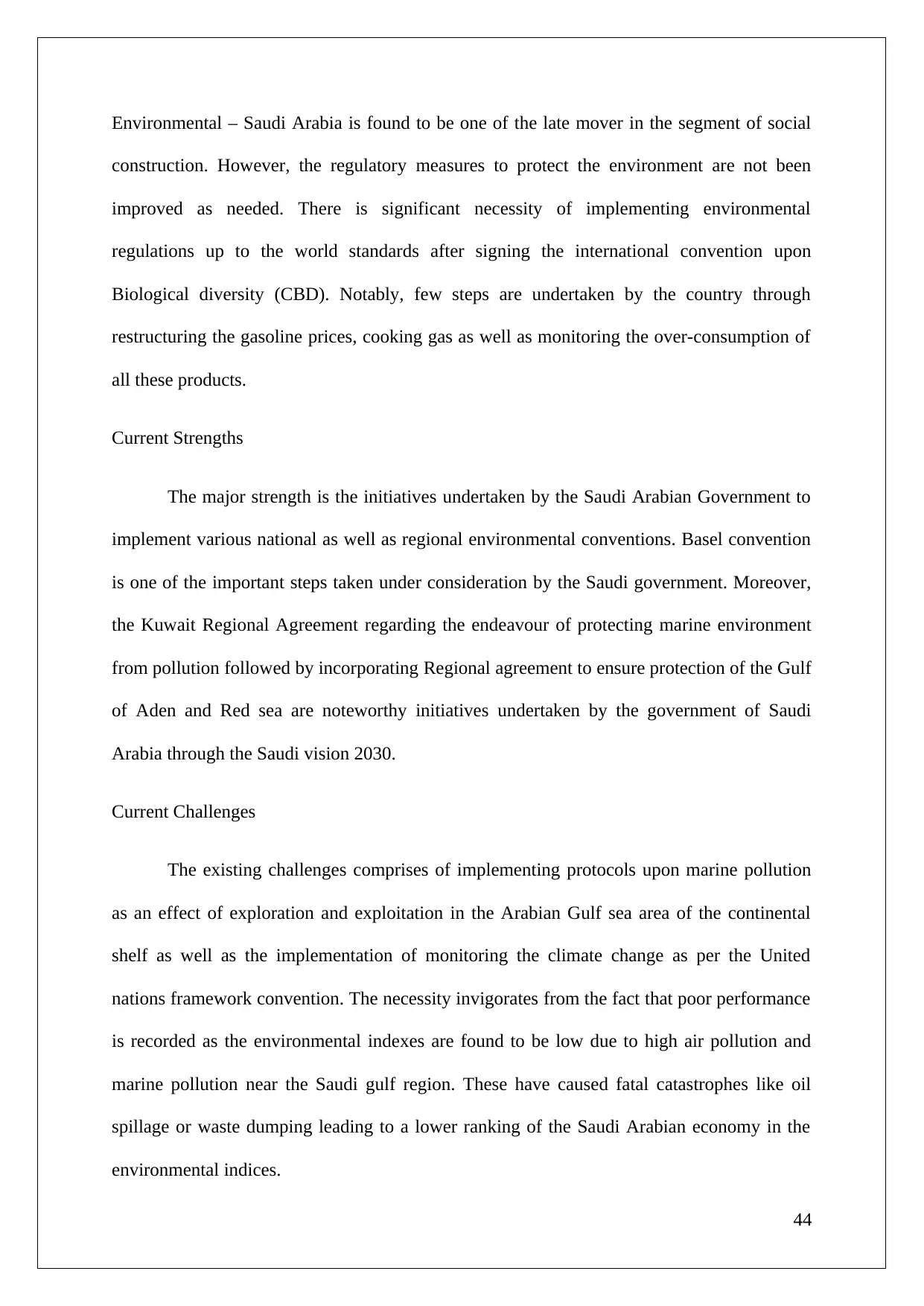
Environmental – Saudi Arabia is found to be one of the late mover in the segment of social
construction. However, the regulatory measures to protect the environment are not been
improved as needed. There is significant necessity of implementing environmental
regulations up to the world standards after signing the international convention upon
Biological diversity (CBD). Notably, few steps are undertaken by the country through
restructuring the gasoline prices, cooking gas as well as monitoring the over-consumption of
all these products.
Current Strengths
The major strength is the initiatives undertaken by the Saudi Arabian Government to
implement various national as well as regional environmental conventions. Basel convention
is one of the important steps taken under consideration by the Saudi government. Moreover,
the Kuwait Regional Agreement regarding the endeavour of protecting marine environment
from pollution followed by incorporating Regional agreement to ensure protection of the Gulf
of Aden and Red sea are noteworthy initiatives undertaken by the government of Saudi
Arabia through the Saudi vision 2030.
Current Challenges
The existing challenges comprises of implementing protocols upon marine pollution
as an effect of exploration and exploitation in the Arabian Gulf sea area of the continental
shelf as well as the implementation of monitoring the climate change as per the United
nations framework convention. The necessity invigorates from the fact that poor performance
is recorded as the environmental indexes are found to be low due to high air pollution and
marine pollution near the Saudi gulf region. These have caused fatal catastrophes like oil
spillage or waste dumping leading to a lower ranking of the Saudi Arabian economy in the
environmental indices.
44
construction. However, the regulatory measures to protect the environment are not been
improved as needed. There is significant necessity of implementing environmental
regulations up to the world standards after signing the international convention upon
Biological diversity (CBD). Notably, few steps are undertaken by the country through
restructuring the gasoline prices, cooking gas as well as monitoring the over-consumption of
all these products.
Current Strengths
The major strength is the initiatives undertaken by the Saudi Arabian Government to
implement various national as well as regional environmental conventions. Basel convention
is one of the important steps taken under consideration by the Saudi government. Moreover,
the Kuwait Regional Agreement regarding the endeavour of protecting marine environment
from pollution followed by incorporating Regional agreement to ensure protection of the Gulf
of Aden and Red sea are noteworthy initiatives undertaken by the government of Saudi
Arabia through the Saudi vision 2030.
Current Challenges
The existing challenges comprises of implementing protocols upon marine pollution
as an effect of exploration and exploitation in the Arabian Gulf sea area of the continental
shelf as well as the implementation of monitoring the climate change as per the United
nations framework convention. The necessity invigorates from the fact that poor performance
is recorded as the environmental indexes are found to be low due to high air pollution and
marine pollution near the Saudi gulf region. These have caused fatal catastrophes like oil
spillage or waste dumping leading to a lower ranking of the Saudi Arabian economy in the
environmental indices.
44

Future Prospects
After the Kyoto protocol, the Saudi government is being found to more focus towards
constructively restructuring its social and environmental issues. After the national
transformation program and in accordance with the Saudi Vision 2030, the government of
Saudi Arabia have put forth significant measures upon restricting waste dumping and
overconsumption of oil.
Involved Risks
It is been found that after 2016 when the Saudi Vision 2030 was undertaken, there is
gap in implementation of the planned strategies. For this reason the Saudi vision 2030 may
get more rigorous which will cut down the revenue generation of the oil sector and invest in
implementing reform in the non-oil sectors of the country.
Political – The political system of the country is found to remain unchanged from the year
1932. The regime is intolerant to the oppositions as well as has significant restrictions to the
media. As far as regional politics is concerned, the scenario of the country is found to be
under the strong influence of the Middle East region which affects the prices of oil as well as
other non-oil goods and services. Due to prevalence of extensive popularity of the monarchs,
the political environment are comparatively stable and good relationships persists between
the religious leaders.
Current strengths:
The country of Saudi Arabia is being ruled by the members of the same dynasty and
due to this reason the political scenario is found to be stable as well as the policies are freed
from any form of radical changes which ensures stability of the policies in the long run.
Legislative reforms:
45
After the Kyoto protocol, the Saudi government is being found to more focus towards
constructively restructuring its social and environmental issues. After the national
transformation program and in accordance with the Saudi Vision 2030, the government of
Saudi Arabia have put forth significant measures upon restricting waste dumping and
overconsumption of oil.
Involved Risks
It is been found that after 2016 when the Saudi Vision 2030 was undertaken, there is
gap in implementation of the planned strategies. For this reason the Saudi vision 2030 may
get more rigorous which will cut down the revenue generation of the oil sector and invest in
implementing reform in the non-oil sectors of the country.
Political – The political system of the country is found to remain unchanged from the year
1932. The regime is intolerant to the oppositions as well as has significant restrictions to the
media. As far as regional politics is concerned, the scenario of the country is found to be
under the strong influence of the Middle East region which affects the prices of oil as well as
other non-oil goods and services. Due to prevalence of extensive popularity of the monarchs,
the political environment are comparatively stable and good relationships persists between
the religious leaders.
Current strengths:
The country of Saudi Arabia is being ruled by the members of the same dynasty and
due to this reason the political scenario is found to be stable as well as the policies are freed
from any form of radical changes which ensures stability of the policies in the long run.
Legislative reforms:
45
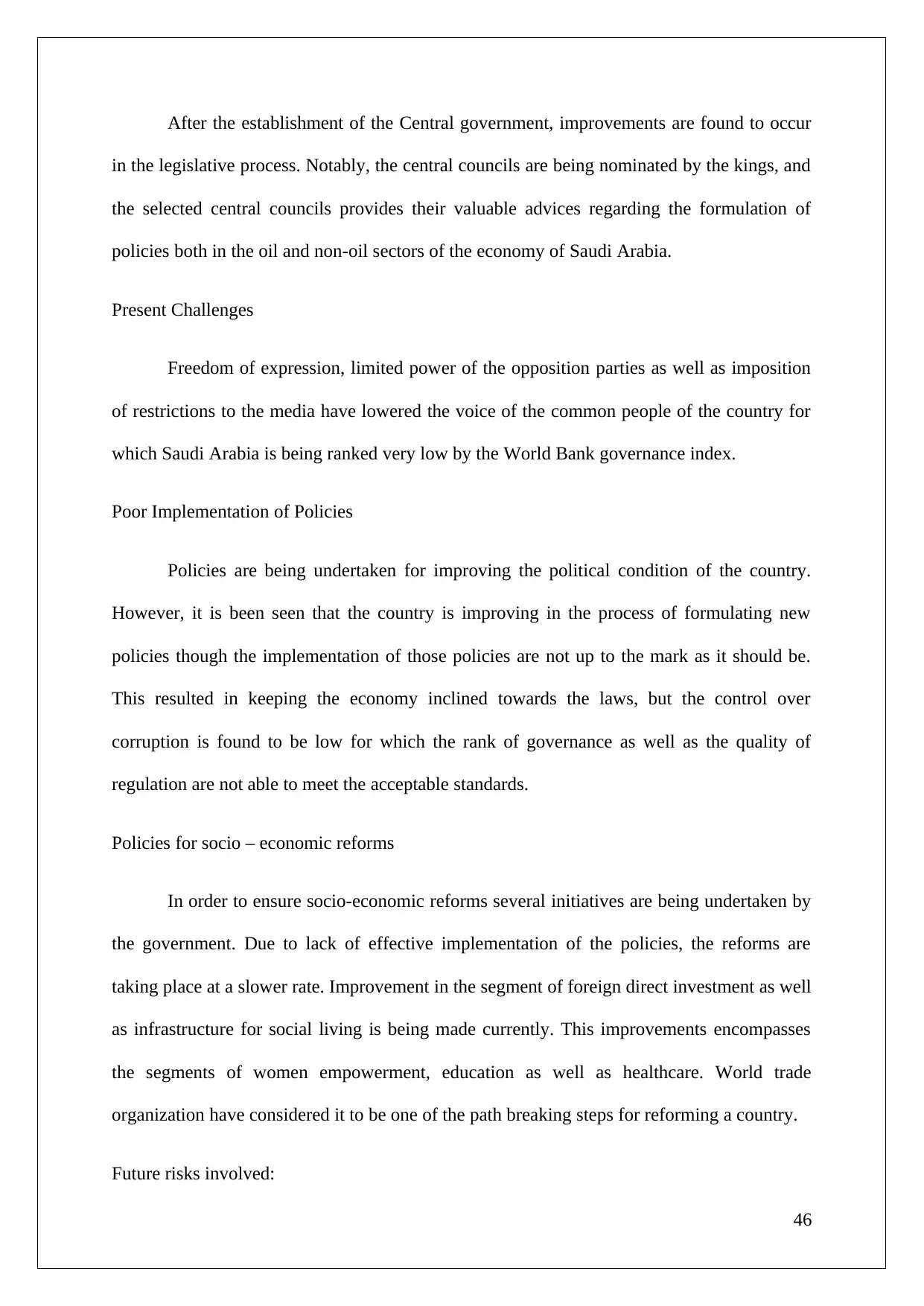
After the establishment of the Central government, improvements are found to occur
in the legislative process. Notably, the central councils are being nominated by the kings, and
the selected central councils provides their valuable advices regarding the formulation of
policies both in the oil and non-oil sectors of the economy of Saudi Arabia.
Present Challenges
Freedom of expression, limited power of the opposition parties as well as imposition
of restrictions to the media have lowered the voice of the common people of the country for
which Saudi Arabia is being ranked very low by the World Bank governance index.
Poor Implementation of Policies
Policies are being undertaken for improving the political condition of the country.
However, it is been seen that the country is improving in the process of formulating new
policies though the implementation of those policies are not up to the mark as it should be.
This resulted in keeping the economy inclined towards the laws, but the control over
corruption is found to be low for which the rank of governance as well as the quality of
regulation are not able to meet the acceptable standards.
Policies for socio – economic reforms
In order to ensure socio-economic reforms several initiatives are being undertaken by
the government. Due to lack of effective implementation of the policies, the reforms are
taking place at a slower rate. Improvement in the segment of foreign direct investment as well
as infrastructure for social living is being made currently. This improvements encompasses
the segments of women empowerment, education as well as healthcare. World trade
organization have considered it to be one of the path breaking steps for reforming a country.
Future risks involved:
46
in the legislative process. Notably, the central councils are being nominated by the kings, and
the selected central councils provides their valuable advices regarding the formulation of
policies both in the oil and non-oil sectors of the economy of Saudi Arabia.
Present Challenges
Freedom of expression, limited power of the opposition parties as well as imposition
of restrictions to the media have lowered the voice of the common people of the country for
which Saudi Arabia is being ranked very low by the World Bank governance index.
Poor Implementation of Policies
Policies are being undertaken for improving the political condition of the country.
However, it is been seen that the country is improving in the process of formulating new
policies though the implementation of those policies are not up to the mark as it should be.
This resulted in keeping the economy inclined towards the laws, but the control over
corruption is found to be low for which the rank of governance as well as the quality of
regulation are not able to meet the acceptable standards.
Policies for socio – economic reforms
In order to ensure socio-economic reforms several initiatives are being undertaken by
the government. Due to lack of effective implementation of the policies, the reforms are
taking place at a slower rate. Improvement in the segment of foreign direct investment as well
as infrastructure for social living is being made currently. This improvements encompasses
the segments of women empowerment, education as well as healthcare. World trade
organization have considered it to be one of the path breaking steps for reforming a country.
Future risks involved:
46
Secure Best Marks with AI Grader
Need help grading? Try our AI Grader for instant feedback on your assignments.

The Islamic extremists may target the country due to presence of the oil reserves as
well as its demographic condition of Saudi Arabia.
Legal – After the commitments to the world trade organization, it is been seen that the legal
and environmental framework of Saudi Arabia is evolving with liberalization and
privatization.
Current Strength:
The existing strength of the economy is its better business environment for which
Saudi Arabia is been ranked 20th by World Bank in terms of the ease f doing business within
the country. Exemption is being made in taxes and the level of minimal capital requirements
to commence any business is being lowered significantly for encouraging entrepreneurs.
Policy reforms in the legal sector through these factors enabled the opportunity to the
investors to become attracted towards Saudi Arabia as one of the best investment destination.
Current Challenges
The major challenges lies in reforming the judicial system where the traditional
capital punishment norms are followed. This may penalize for wrong business transactions,
corruption or any unethical means of doing business, however, will not be able to eradicate
the mentality within people in the wrong deeds. The king is the head in the Saudi Arabian
judicial system followed by making an extension of the political authoritarian ship without
giving rights to it as an independent entity.
Future Prospects
It is important to train the individuals that represents the judicial system of the country
as a whole. As for example facilitation of training programs for the judges, barristers, etc.
followed by maintaining two forms of courts viz. the Supreme Court and the general court
47
well as its demographic condition of Saudi Arabia.
Legal – After the commitments to the world trade organization, it is been seen that the legal
and environmental framework of Saudi Arabia is evolving with liberalization and
privatization.
Current Strength:
The existing strength of the economy is its better business environment for which
Saudi Arabia is been ranked 20th by World Bank in terms of the ease f doing business within
the country. Exemption is being made in taxes and the level of minimal capital requirements
to commence any business is being lowered significantly for encouraging entrepreneurs.
Policy reforms in the legal sector through these factors enabled the opportunity to the
investors to become attracted towards Saudi Arabia as one of the best investment destination.
Current Challenges
The major challenges lies in reforming the judicial system where the traditional
capital punishment norms are followed. This may penalize for wrong business transactions,
corruption or any unethical means of doing business, however, will not be able to eradicate
the mentality within people in the wrong deeds. The king is the head in the Saudi Arabian
judicial system followed by making an extension of the political authoritarian ship without
giving rights to it as an independent entity.
Future Prospects
It is important to train the individuals that represents the judicial system of the country
as a whole. As for example facilitation of training programs for the judges, barristers, etc.
followed by maintaining two forms of courts viz. the Supreme Court and the general court
47

among which two different segment will be there, one of which will deal with civil affairs
and the other will deal with criminal affairs. Along with that it is essential to ensure
infrastructural development and reduce the number of pending cases in corporate affairs.
Future Risks Involved
There are several risks involved in the legal system among which one of the important
aspect is that the legal system is biased towards the Saudi nationals and the investment laws
lacked in maintaining transparency. This can hamper the process of attracting foreign
investors for investment in the non-oil sector of the country. Transparency is required
significantly in the foreign arbitration laws as well as protocols regarding corporate taxes.
After the PESTLE analysis the following figure can be incorporated that summarizes the
analysis in the form of a diagram.
48
and the other will deal with criminal affairs. Along with that it is essential to ensure
infrastructural development and reduce the number of pending cases in corporate affairs.
Future Risks Involved
There are several risks involved in the legal system among which one of the important
aspect is that the legal system is biased towards the Saudi nationals and the investment laws
lacked in maintaining transparency. This can hamper the process of attracting foreign
investors for investment in the non-oil sector of the country. Transparency is required
significantly in the foreign arbitration laws as well as protocols regarding corporate taxes.
After the PESTLE analysis the following figure can be incorporated that summarizes the
analysis in the form of a diagram.
48
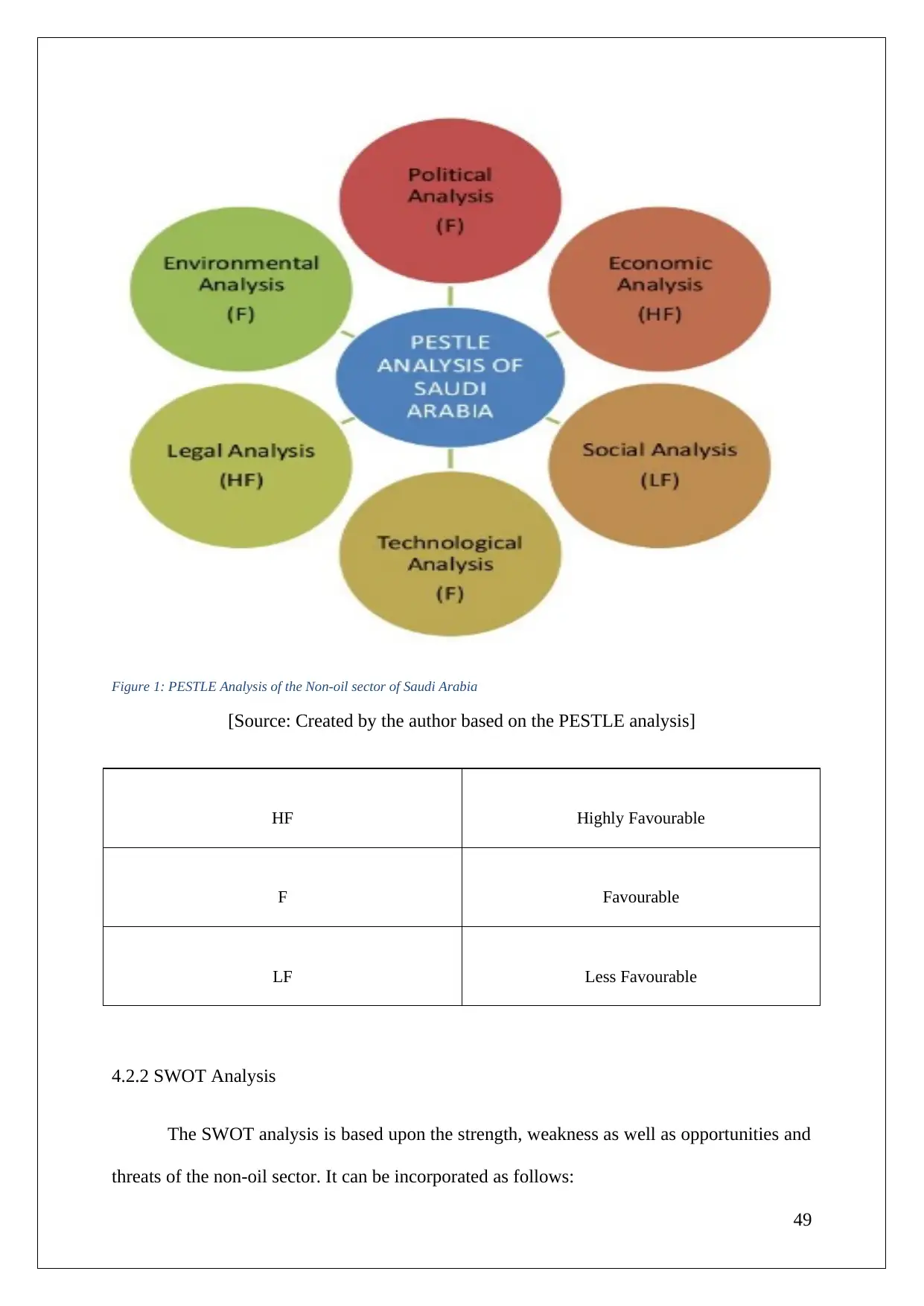
Figure 1: PESTLE Analysis of the Non-oil sector of Saudi Arabia
[Source: Created by the author based on the PESTLE analysis]
HF Highly Favourable
F Favourable
LF Less Favourable
4.2.2 SWOT Analysis
The SWOT analysis is based upon the strength, weakness as well as opportunities and
threats of the non-oil sector. It can be incorporated as follows:
49
[Source: Created by the author based on the PESTLE analysis]
HF Highly Favourable
F Favourable
LF Less Favourable
4.2.2 SWOT Analysis
The SWOT analysis is based upon the strength, weakness as well as opportunities and
threats of the non-oil sector. It can be incorporated as follows:
49
Paraphrase This Document
Need a fresh take? Get an instant paraphrase of this document with our AI Paraphraser
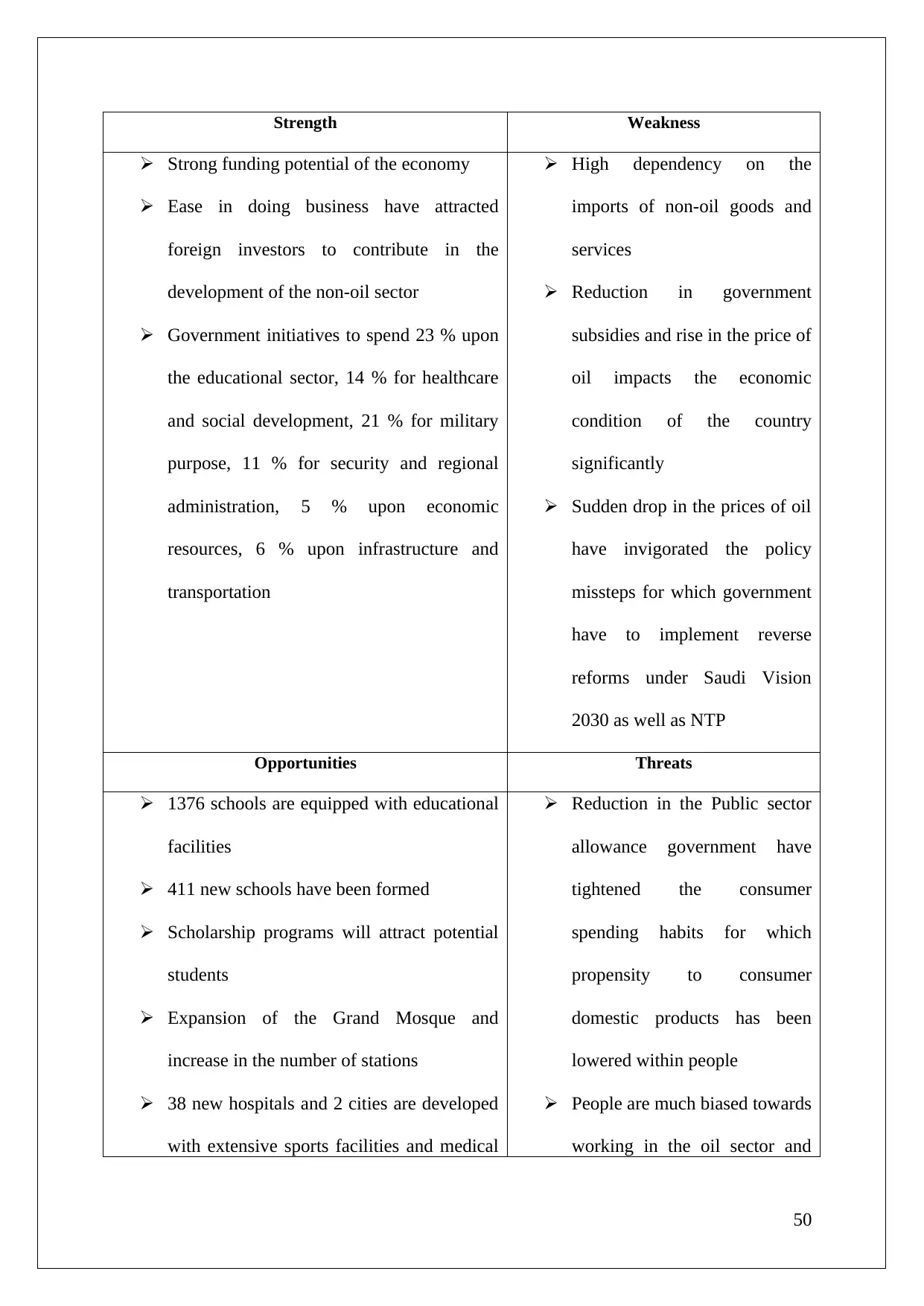
Strength Weakness
Strong funding potential of the economy
Ease in doing business have attracted
foreign investors to contribute in the
development of the non-oil sector
Government initiatives to spend 23 % upon
the educational sector, 14 % for healthcare
and social development, 21 % for military
purpose, 11 % for security and regional
administration, 5 % upon economic
resources, 6 % upon infrastructure and
transportation
High dependency on the
imports of non-oil goods and
services
Reduction in government
subsidies and rise in the price of
oil impacts the economic
condition of the country
significantly
Sudden drop in the prices of oil
have invigorated the policy
missteps for which government
have to implement reverse
reforms under Saudi Vision
2030 as well as NTP
Opportunities Threats
1376 schools are equipped with educational
facilities
411 new schools have been formed
Scholarship programs will attract potential
students
Expansion of the Grand Mosque and
increase in the number of stations
38 new hospitals and 2 cities are developed
with extensive sports facilities and medical
Reduction in the Public sector
allowance government have
tightened the consumer
spending habits for which
propensity to consumer
domestic products has been
lowered within people
People are much biased towards
working in the oil sector and
50
Strong funding potential of the economy
Ease in doing business have attracted
foreign investors to contribute in the
development of the non-oil sector
Government initiatives to spend 23 % upon
the educational sector, 14 % for healthcare
and social development, 21 % for military
purpose, 11 % for security and regional
administration, 5 % upon economic
resources, 6 % upon infrastructure and
transportation
High dependency on the
imports of non-oil goods and
services
Reduction in government
subsidies and rise in the price of
oil impacts the economic
condition of the country
significantly
Sudden drop in the prices of oil
have invigorated the policy
missteps for which government
have to implement reverse
reforms under Saudi Vision
2030 as well as NTP
Opportunities Threats
1376 schools are equipped with educational
facilities
411 new schools have been formed
Scholarship programs will attract potential
students
Expansion of the Grand Mosque and
increase in the number of stations
38 new hospitals and 2 cities are developed
with extensive sports facilities and medical
Reduction in the Public sector
allowance government have
tightened the consumer
spending habits for which
propensity to consumer
domestic products has been
lowered within people
People are much biased towards
working in the oil sector and
50
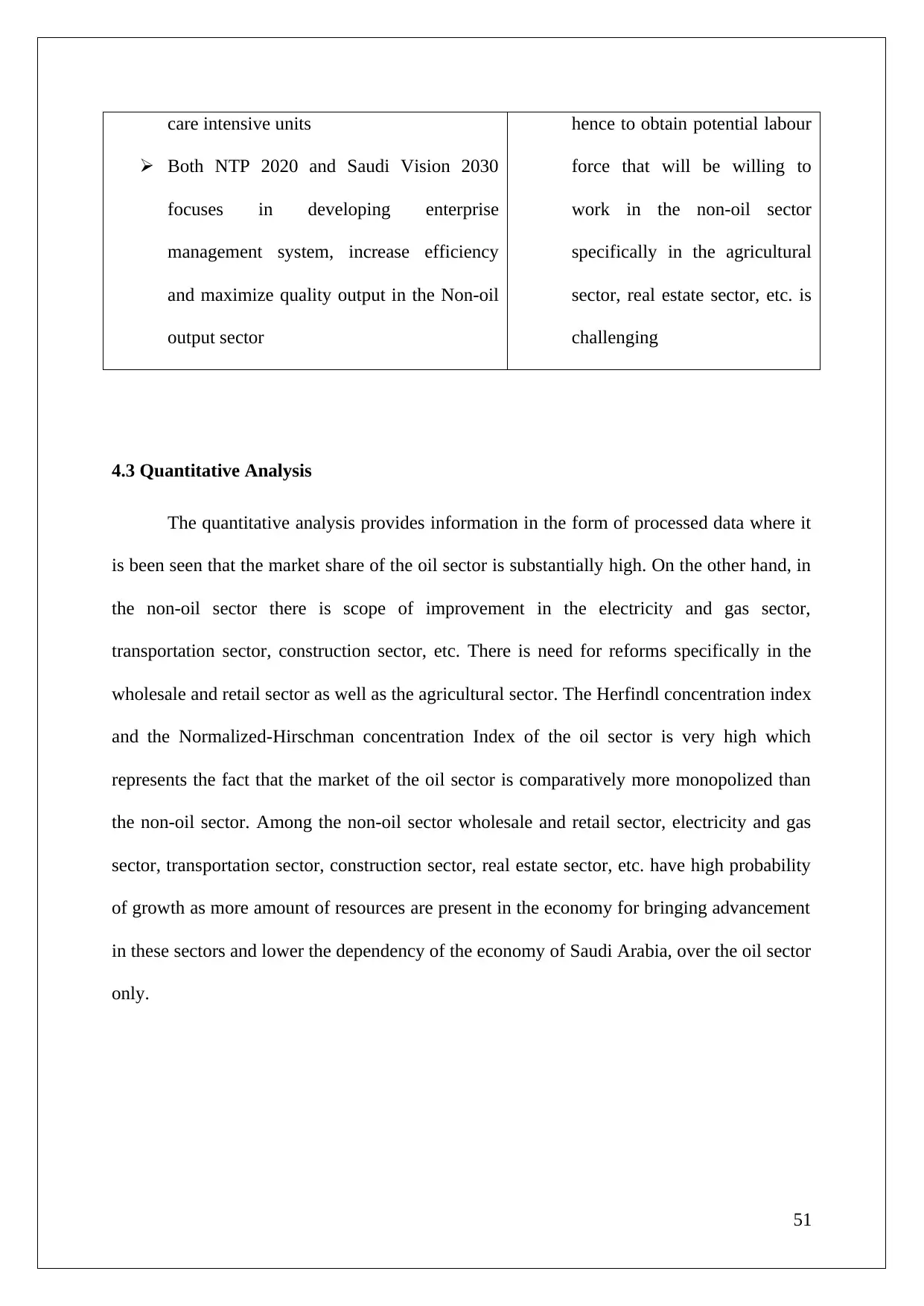
care intensive units
Both NTP 2020 and Saudi Vision 2030
focuses in developing enterprise
management system, increase efficiency
and maximize quality output in the Non-oil
output sector
hence to obtain potential labour
force that will be willing to
work in the non-oil sector
specifically in the agricultural
sector, real estate sector, etc. is
challenging
4.3 Quantitative Analysis
The quantitative analysis provides information in the form of processed data where it
is been seen that the market share of the oil sector is substantially high. On the other hand, in
the non-oil sector there is scope of improvement in the electricity and gas sector,
transportation sector, construction sector, etc. There is need for reforms specifically in the
wholesale and retail sector as well as the agricultural sector. The Herfindl concentration index
and the Normalized-Hirschman concentration Index of the oil sector is very high which
represents the fact that the market of the oil sector is comparatively more monopolized than
the non-oil sector. Among the non-oil sector wholesale and retail sector, electricity and gas
sector, transportation sector, construction sector, real estate sector, etc. have high probability
of growth as more amount of resources are present in the economy for bringing advancement
in these sectors and lower the dependency of the economy of Saudi Arabia, over the oil sector
only.
51
Both NTP 2020 and Saudi Vision 2030
focuses in developing enterprise
management system, increase efficiency
and maximize quality output in the Non-oil
output sector
hence to obtain potential labour
force that will be willing to
work in the non-oil sector
specifically in the agricultural
sector, real estate sector, etc. is
challenging
4.3 Quantitative Analysis
The quantitative analysis provides information in the form of processed data where it
is been seen that the market share of the oil sector is substantially high. On the other hand, in
the non-oil sector there is scope of improvement in the electricity and gas sector,
transportation sector, construction sector, etc. There is need for reforms specifically in the
wholesale and retail sector as well as the agricultural sector. The Herfindl concentration index
and the Normalized-Hirschman concentration Index of the oil sector is very high which
represents the fact that the market of the oil sector is comparatively more monopolized than
the non-oil sector. Among the non-oil sector wholesale and retail sector, electricity and gas
sector, transportation sector, construction sector, real estate sector, etc. have high probability
of growth as more amount of resources are present in the economy for bringing advancement
in these sectors and lower the dependency of the economy of Saudi Arabia, over the oil sector
only.
51
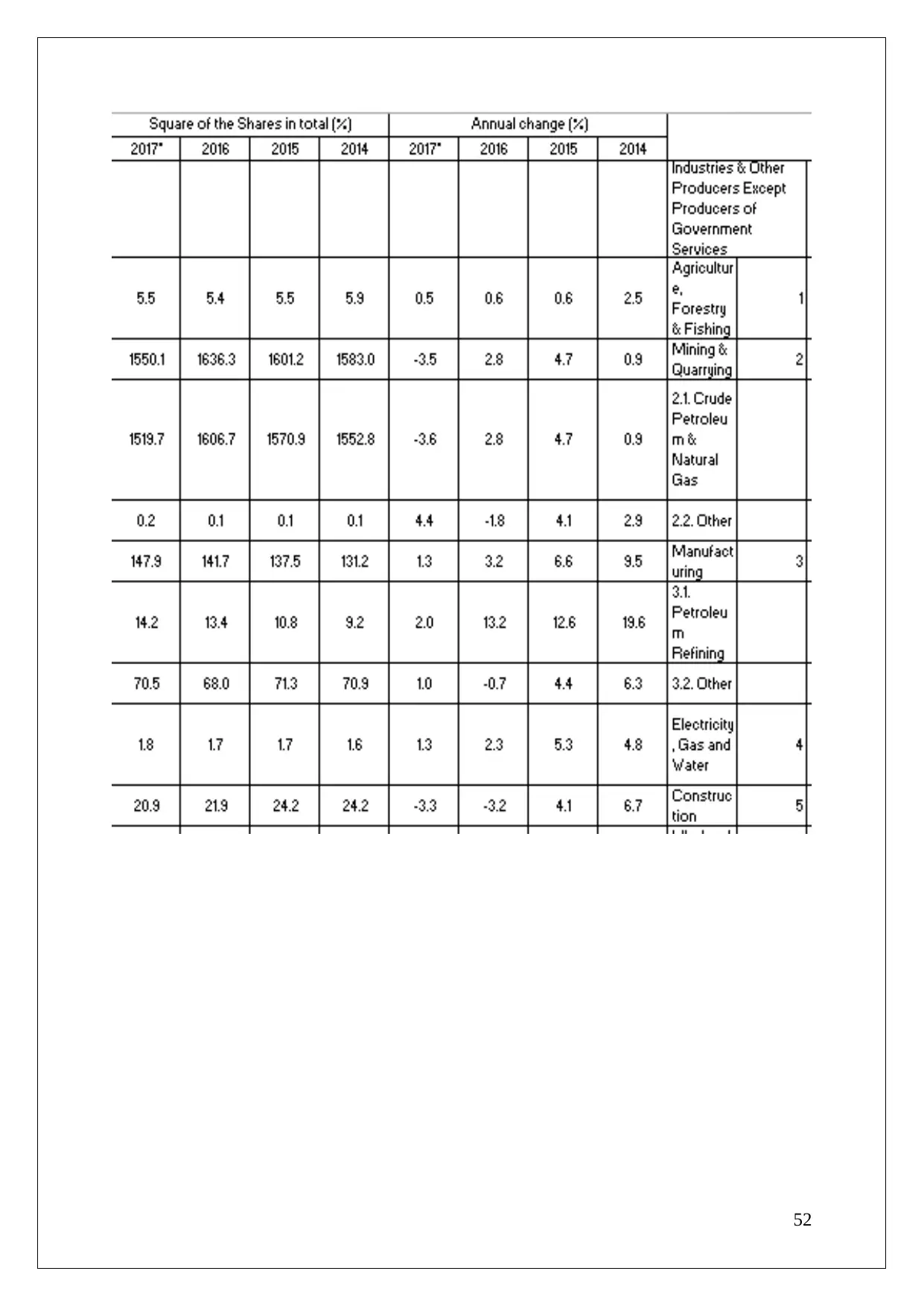
52
Secure Best Marks with AI Grader
Need help grading? Try our AI Grader for instant feedback on your assignments.
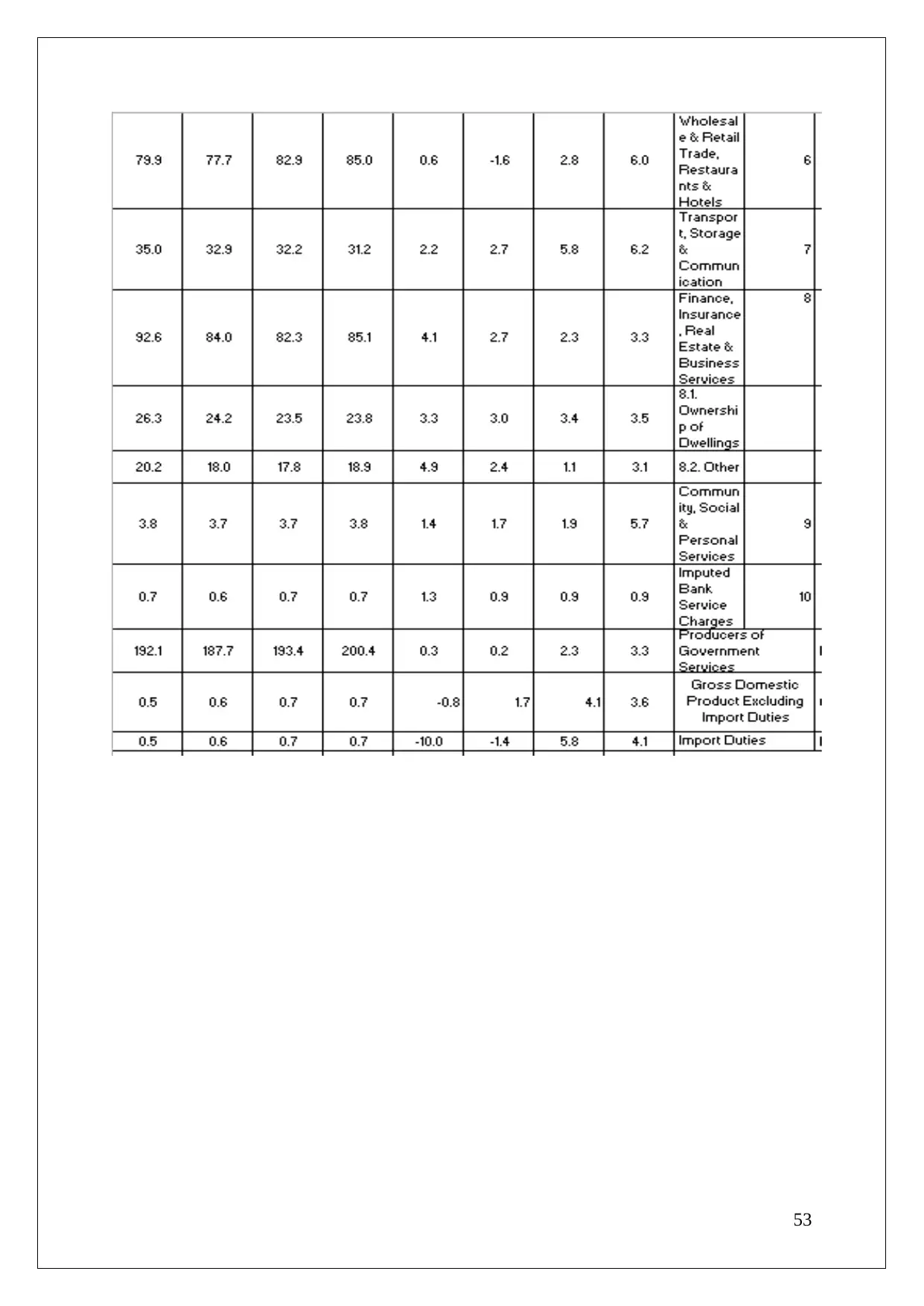
53
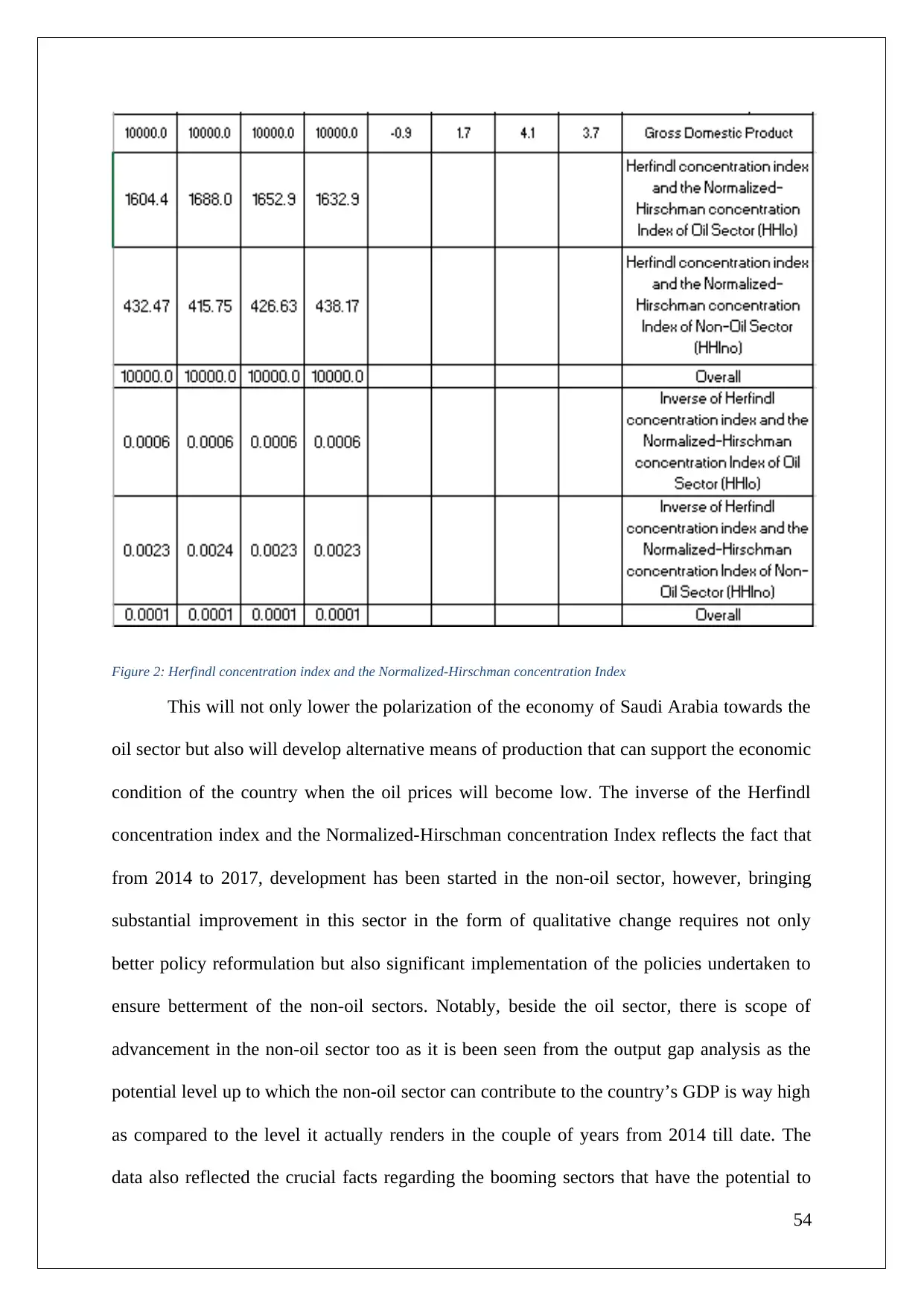
Figure 2: Herfindl concentration index and the Normalized-Hirschman concentration Index
This will not only lower the polarization of the economy of Saudi Arabia towards the
oil sector but also will develop alternative means of production that can support the economic
condition of the country when the oil prices will become low. The inverse of the Herfindl
concentration index and the Normalized-Hirschman concentration Index reflects the fact that
from 2014 to 2017, development has been started in the non-oil sector, however, bringing
substantial improvement in this sector in the form of qualitative change requires not only
better policy reformulation but also significant implementation of the policies undertaken to
ensure betterment of the non-oil sectors. Notably, beside the oil sector, there is scope of
advancement in the non-oil sector too as it is been seen from the output gap analysis as the
potential level up to which the non-oil sector can contribute to the country’s GDP is way high
as compared to the level it actually renders in the couple of years from 2014 till date. The
data also reflected the crucial facts regarding the booming sectors that have the potential to
54
This will not only lower the polarization of the economy of Saudi Arabia towards the
oil sector but also will develop alternative means of production that can support the economic
condition of the country when the oil prices will become low. The inverse of the Herfindl
concentration index and the Normalized-Hirschman concentration Index reflects the fact that
from 2014 to 2017, development has been started in the non-oil sector, however, bringing
substantial improvement in this sector in the form of qualitative change requires not only
better policy reformulation but also significant implementation of the policies undertaken to
ensure betterment of the non-oil sectors. Notably, beside the oil sector, there is scope of
advancement in the non-oil sector too as it is been seen from the output gap analysis as the
potential level up to which the non-oil sector can contribute to the country’s GDP is way high
as compared to the level it actually renders in the couple of years from 2014 till date. The
data also reflected the crucial facts regarding the booming sectors that have the potential to
54
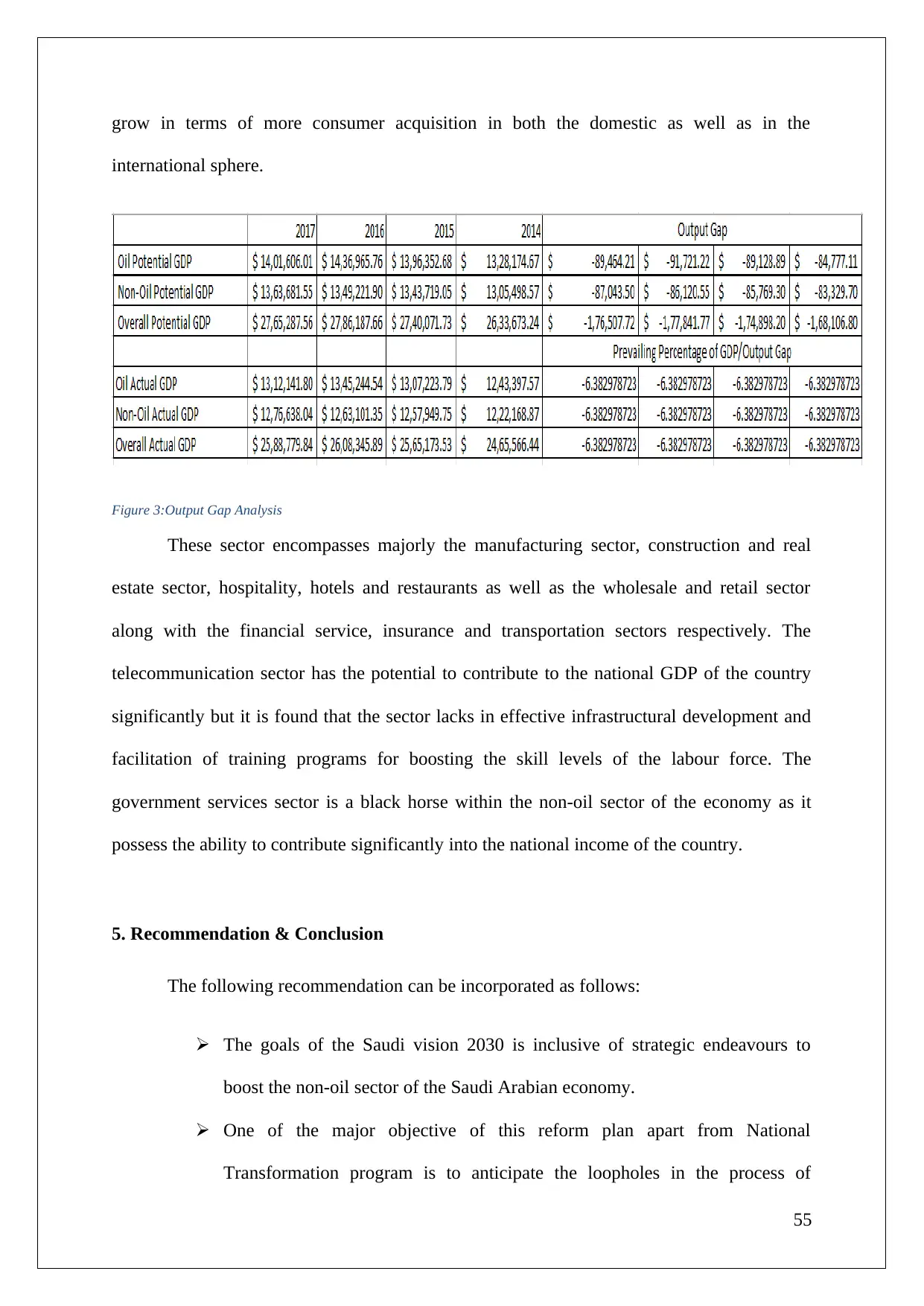
grow in terms of more consumer acquisition in both the domestic as well as in the
international sphere.
Figure 3:Output Gap Analysis
These sector encompasses majorly the manufacturing sector, construction and real
estate sector, hospitality, hotels and restaurants as well as the wholesale and retail sector
along with the financial service, insurance and transportation sectors respectively. The
telecommunication sector has the potential to contribute to the national GDP of the country
significantly but it is found that the sector lacks in effective infrastructural development and
facilitation of training programs for boosting the skill levels of the labour force. The
government services sector is a black horse within the non-oil sector of the economy as it
possess the ability to contribute significantly into the national income of the country.
5. Recommendation & Conclusion
The following recommendation can be incorporated as follows:
The goals of the Saudi vision 2030 is inclusive of strategic endeavours to
boost the non-oil sector of the Saudi Arabian economy.
One of the major objective of this reform plan apart from National
Transformation program is to anticipate the loopholes in the process of
55
international sphere.
Figure 3:Output Gap Analysis
These sector encompasses majorly the manufacturing sector, construction and real
estate sector, hospitality, hotels and restaurants as well as the wholesale and retail sector
along with the financial service, insurance and transportation sectors respectively. The
telecommunication sector has the potential to contribute to the national GDP of the country
significantly but it is found that the sector lacks in effective infrastructural development and
facilitation of training programs for boosting the skill levels of the labour force. The
government services sector is a black horse within the non-oil sector of the economy as it
possess the ability to contribute significantly into the national income of the country.
5. Recommendation & Conclusion
The following recommendation can be incorporated as follows:
The goals of the Saudi vision 2030 is inclusive of strategic endeavours to
boost the non-oil sector of the Saudi Arabian economy.
One of the major objective of this reform plan apart from National
Transformation program is to anticipate the loopholes in the process of
55
Paraphrase This Document
Need a fresh take? Get an instant paraphrase of this document with our AI Paraphraser
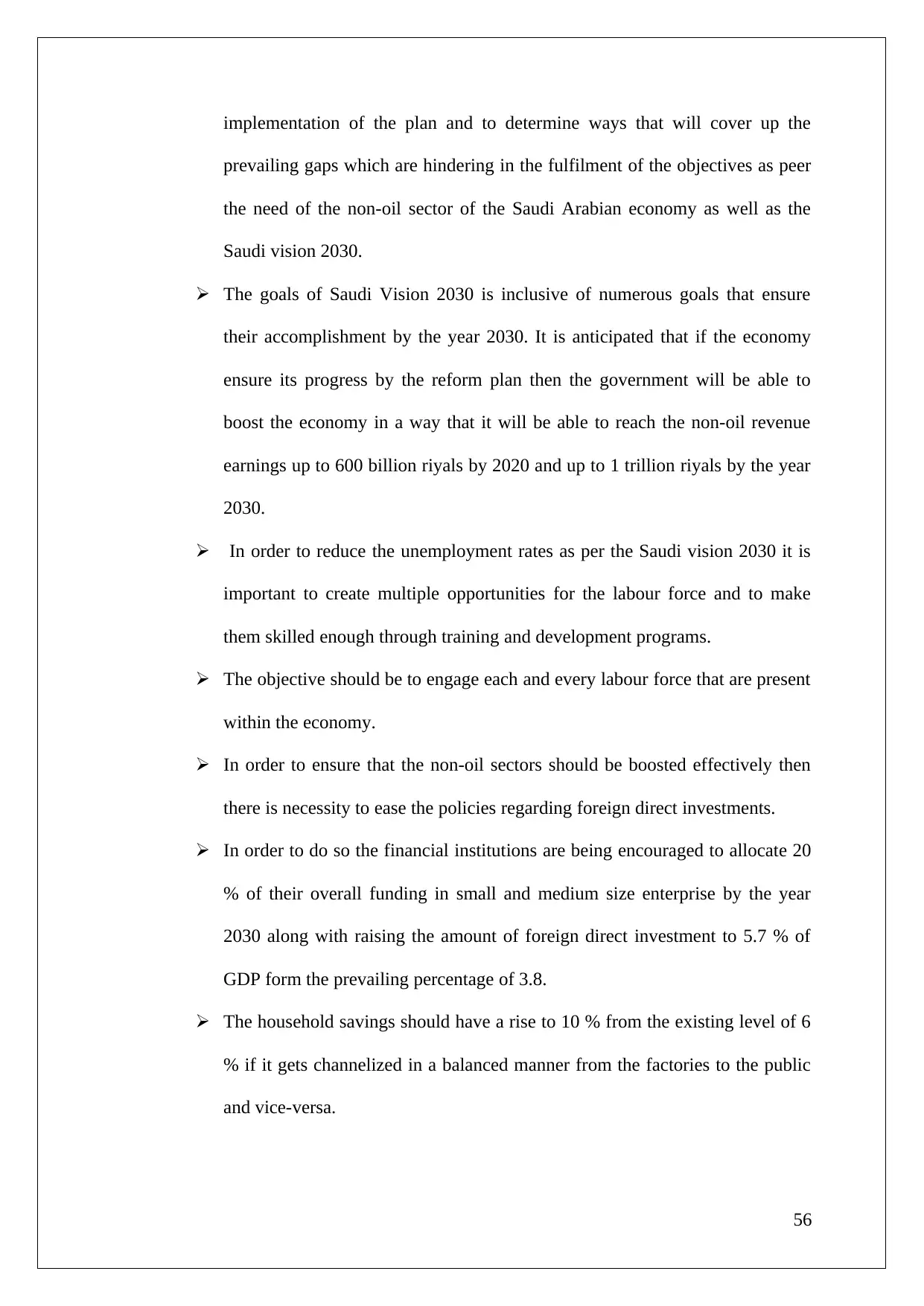
implementation of the plan and to determine ways that will cover up the
prevailing gaps which are hindering in the fulfilment of the objectives as peer
the need of the non-oil sector of the Saudi Arabian economy as well as the
Saudi vision 2030.
The goals of Saudi Vision 2030 is inclusive of numerous goals that ensure
their accomplishment by the year 2030. It is anticipated that if the economy
ensure its progress by the reform plan then the government will be able to
boost the economy in a way that it will be able to reach the non-oil revenue
earnings up to 600 billion riyals by 2020 and up to 1 trillion riyals by the year
2030.
In order to reduce the unemployment rates as per the Saudi vision 2030 it is
important to create multiple opportunities for the labour force and to make
them skilled enough through training and development programs.
The objective should be to engage each and every labour force that are present
within the economy.
In order to ensure that the non-oil sectors should be boosted effectively then
there is necessity to ease the policies regarding foreign direct investments.
In order to do so the financial institutions are being encouraged to allocate 20
% of their overall funding in small and medium size enterprise by the year
2030 along with raising the amount of foreign direct investment to 5.7 % of
GDP form the prevailing percentage of 3.8.
The household savings should have a rise to 10 % from the existing level of 6
% if it gets channelized in a balanced manner from the factories to the public
and vice-versa.
56
prevailing gaps which are hindering in the fulfilment of the objectives as peer
the need of the non-oil sector of the Saudi Arabian economy as well as the
Saudi vision 2030.
The goals of Saudi Vision 2030 is inclusive of numerous goals that ensure
their accomplishment by the year 2030. It is anticipated that if the economy
ensure its progress by the reform plan then the government will be able to
boost the economy in a way that it will be able to reach the non-oil revenue
earnings up to 600 billion riyals by 2020 and up to 1 trillion riyals by the year
2030.
In order to reduce the unemployment rates as per the Saudi vision 2030 it is
important to create multiple opportunities for the labour force and to make
them skilled enough through training and development programs.
The objective should be to engage each and every labour force that are present
within the economy.
In order to ensure that the non-oil sectors should be boosted effectively then
there is necessity to ease the policies regarding foreign direct investments.
In order to do so the financial institutions are being encouraged to allocate 20
% of their overall funding in small and medium size enterprise by the year
2030 along with raising the amount of foreign direct investment to 5.7 % of
GDP form the prevailing percentage of 3.8.
The household savings should have a rise to 10 % from the existing level of 6
% if it gets channelized in a balanced manner from the factories to the public
and vice-versa.
56
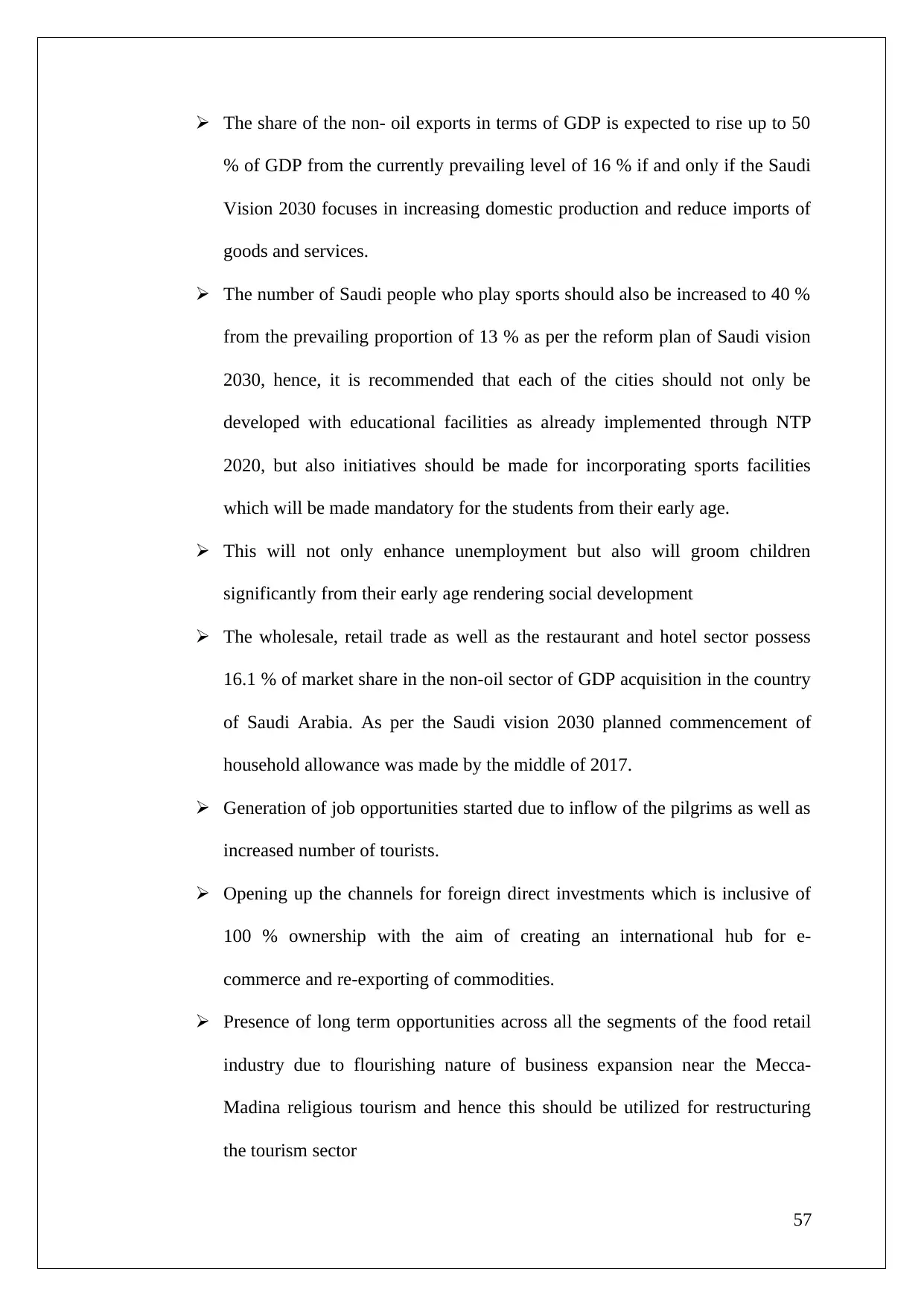
The share of the non- oil exports in terms of GDP is expected to rise up to 50
% of GDP from the currently prevailing level of 16 % if and only if the Saudi
Vision 2030 focuses in increasing domestic production and reduce imports of
goods and services.
The number of Saudi people who play sports should also be increased to 40 %
from the prevailing proportion of 13 % as per the reform plan of Saudi vision
2030, hence, it is recommended that each of the cities should not only be
developed with educational facilities as already implemented through NTP
2020, but also initiatives should be made for incorporating sports facilities
which will be made mandatory for the students from their early age.
This will not only enhance unemployment but also will groom children
significantly from their early age rendering social development
The wholesale, retail trade as well as the restaurant and hotel sector possess
16.1 % of market share in the non-oil sector of GDP acquisition in the country
of Saudi Arabia. As per the Saudi vision 2030 planned commencement of
household allowance was made by the middle of 2017.
Generation of job opportunities started due to inflow of the pilgrims as well as
increased number of tourists.
Opening up the channels for foreign direct investments which is inclusive of
100 % ownership with the aim of creating an international hub for e-
commerce and re-exporting of commodities.
Presence of long term opportunities across all the segments of the food retail
industry due to flourishing nature of business expansion near the Mecca-
Madina religious tourism and hence this should be utilized for restructuring
the tourism sector
57
% of GDP from the currently prevailing level of 16 % if and only if the Saudi
Vision 2030 focuses in increasing domestic production and reduce imports of
goods and services.
The number of Saudi people who play sports should also be increased to 40 %
from the prevailing proportion of 13 % as per the reform plan of Saudi vision
2030, hence, it is recommended that each of the cities should not only be
developed with educational facilities as already implemented through NTP
2020, but also initiatives should be made for incorporating sports facilities
which will be made mandatory for the students from their early age.
This will not only enhance unemployment but also will groom children
significantly from their early age rendering social development
The wholesale, retail trade as well as the restaurant and hotel sector possess
16.1 % of market share in the non-oil sector of GDP acquisition in the country
of Saudi Arabia. As per the Saudi vision 2030 planned commencement of
household allowance was made by the middle of 2017.
Generation of job opportunities started due to inflow of the pilgrims as well as
increased number of tourists.
Opening up the channels for foreign direct investments which is inclusive of
100 % ownership with the aim of creating an international hub for e-
commerce and re-exporting of commodities.
Presence of long term opportunities across all the segments of the food retail
industry due to flourishing nature of business expansion near the Mecca-
Madina religious tourism and hence this should be utilized for restructuring
the tourism sector
57
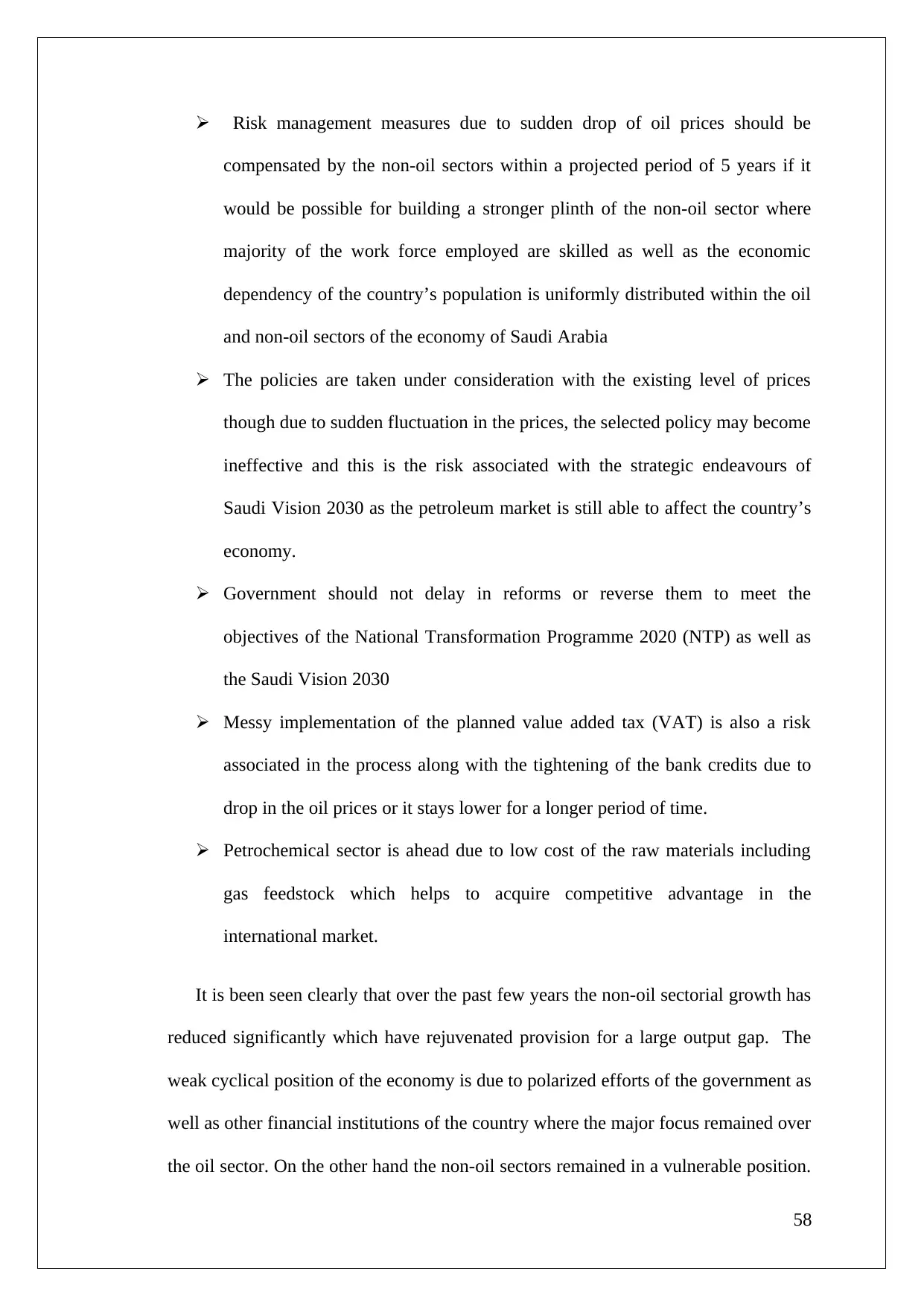
Risk management measures due to sudden drop of oil prices should be
compensated by the non-oil sectors within a projected period of 5 years if it
would be possible for building a stronger plinth of the non-oil sector where
majority of the work force employed are skilled as well as the economic
dependency of the country’s population is uniformly distributed within the oil
and non-oil sectors of the economy of Saudi Arabia
The policies are taken under consideration with the existing level of prices
though due to sudden fluctuation in the prices, the selected policy may become
ineffective and this is the risk associated with the strategic endeavours of
Saudi Vision 2030 as the petroleum market is still able to affect the country’s
economy.
Government should not delay in reforms or reverse them to meet the
objectives of the National Transformation Programme 2020 (NTP) as well as
the Saudi Vision 2030
Messy implementation of the planned value added tax (VAT) is also a risk
associated in the process along with the tightening of the bank credits due to
drop in the oil prices or it stays lower for a longer period of time.
Petrochemical sector is ahead due to low cost of the raw materials including
gas feedstock which helps to acquire competitive advantage in the
international market.
It is been seen clearly that over the past few years the non-oil sectorial growth has
reduced significantly which have rejuvenated provision for a large output gap. The
weak cyclical position of the economy is due to polarized efforts of the government as
well as other financial institutions of the country where the major focus remained over
the oil sector. On the other hand the non-oil sectors remained in a vulnerable position.
58
compensated by the non-oil sectors within a projected period of 5 years if it
would be possible for building a stronger plinth of the non-oil sector where
majority of the work force employed are skilled as well as the economic
dependency of the country’s population is uniformly distributed within the oil
and non-oil sectors of the economy of Saudi Arabia
The policies are taken under consideration with the existing level of prices
though due to sudden fluctuation in the prices, the selected policy may become
ineffective and this is the risk associated with the strategic endeavours of
Saudi Vision 2030 as the petroleum market is still able to affect the country’s
economy.
Government should not delay in reforms or reverse them to meet the
objectives of the National Transformation Programme 2020 (NTP) as well as
the Saudi Vision 2030
Messy implementation of the planned value added tax (VAT) is also a risk
associated in the process along with the tightening of the bank credits due to
drop in the oil prices or it stays lower for a longer period of time.
Petrochemical sector is ahead due to low cost of the raw materials including
gas feedstock which helps to acquire competitive advantage in the
international market.
It is been seen clearly that over the past few years the non-oil sectorial growth has
reduced significantly which have rejuvenated provision for a large output gap. The
weak cyclical position of the economy is due to polarized efforts of the government as
well as other financial institutions of the country where the major focus remained over
the oil sector. On the other hand the non-oil sectors remained in a vulnerable position.
58
Secure Best Marks with AI Grader
Need help grading? Try our AI Grader for instant feedback on your assignments.

There comes the importance of the Saudi vision 2030 which is an initiative to ensure
reform within the economy of Saudi Arabia. There are other plans like the National
Transformation programme (NTP) 2020 also which focuses upon the objective of
stabilizing the economy. However the importance of Saudi Vision 2030 lies in
reaching the grassroots levels of the economy and substantiate development from both
quantitative and qualitative perspectives. Effective fiscal adjustment are also essential
in this regard as it will limit the running out in the net assets, restrict risks associated
with the borrowing costs as well as can utilize full-fledged advantage of the existing
reform climate. All of these finding coupled with the Saudi Vision 2030, helped in
understanding the feasibility of the reform plan as well as directs towards anticipating
the extent up to which the Saudi Vision 2030 can get successfully accomplished based
upon the exiting scenario of the Saudi Arabian economy. From the findings it is been
found that among the non-oil sector of Saudi Arabia specifically the financial sector
as well as the insurance and real estate sector are booming significantly overtime
followed by ensuring that if infrastructural development is being effectively
incorporated in this sector then there is high probability that these sectors will be able
to contribute significantly to the national GDP of Saudi Arabian economy. Moreover,
the output gap analysis revealed that there is scope of advancement in the
construction, telecommunication, storage, wholesale, retail, restaurants and
hospitality, manufacturing, government services as well as transportation sectors,
however, these sectors lacks in implementation of effective planned strategies.
Moreover, another sector that needs both technological advancement and significant
support from the government is the agricultural sector of Saudi Arabia.
59
reform within the economy of Saudi Arabia. There are other plans like the National
Transformation programme (NTP) 2020 also which focuses upon the objective of
stabilizing the economy. However the importance of Saudi Vision 2030 lies in
reaching the grassroots levels of the economy and substantiate development from both
quantitative and qualitative perspectives. Effective fiscal adjustment are also essential
in this regard as it will limit the running out in the net assets, restrict risks associated
with the borrowing costs as well as can utilize full-fledged advantage of the existing
reform climate. All of these finding coupled with the Saudi Vision 2030, helped in
understanding the feasibility of the reform plan as well as directs towards anticipating
the extent up to which the Saudi Vision 2030 can get successfully accomplished based
upon the exiting scenario of the Saudi Arabian economy. From the findings it is been
found that among the non-oil sector of Saudi Arabia specifically the financial sector
as well as the insurance and real estate sector are booming significantly overtime
followed by ensuring that if infrastructural development is being effectively
incorporated in this sector then there is high probability that these sectors will be able
to contribute significantly to the national GDP of Saudi Arabian economy. Moreover,
the output gap analysis revealed that there is scope of advancement in the
construction, telecommunication, storage, wholesale, retail, restaurants and
hospitality, manufacturing, government services as well as transportation sectors,
however, these sectors lacks in implementation of effective planned strategies.
Moreover, another sector that needs both technological advancement and significant
support from the government is the agricultural sector of Saudi Arabia.
59

60
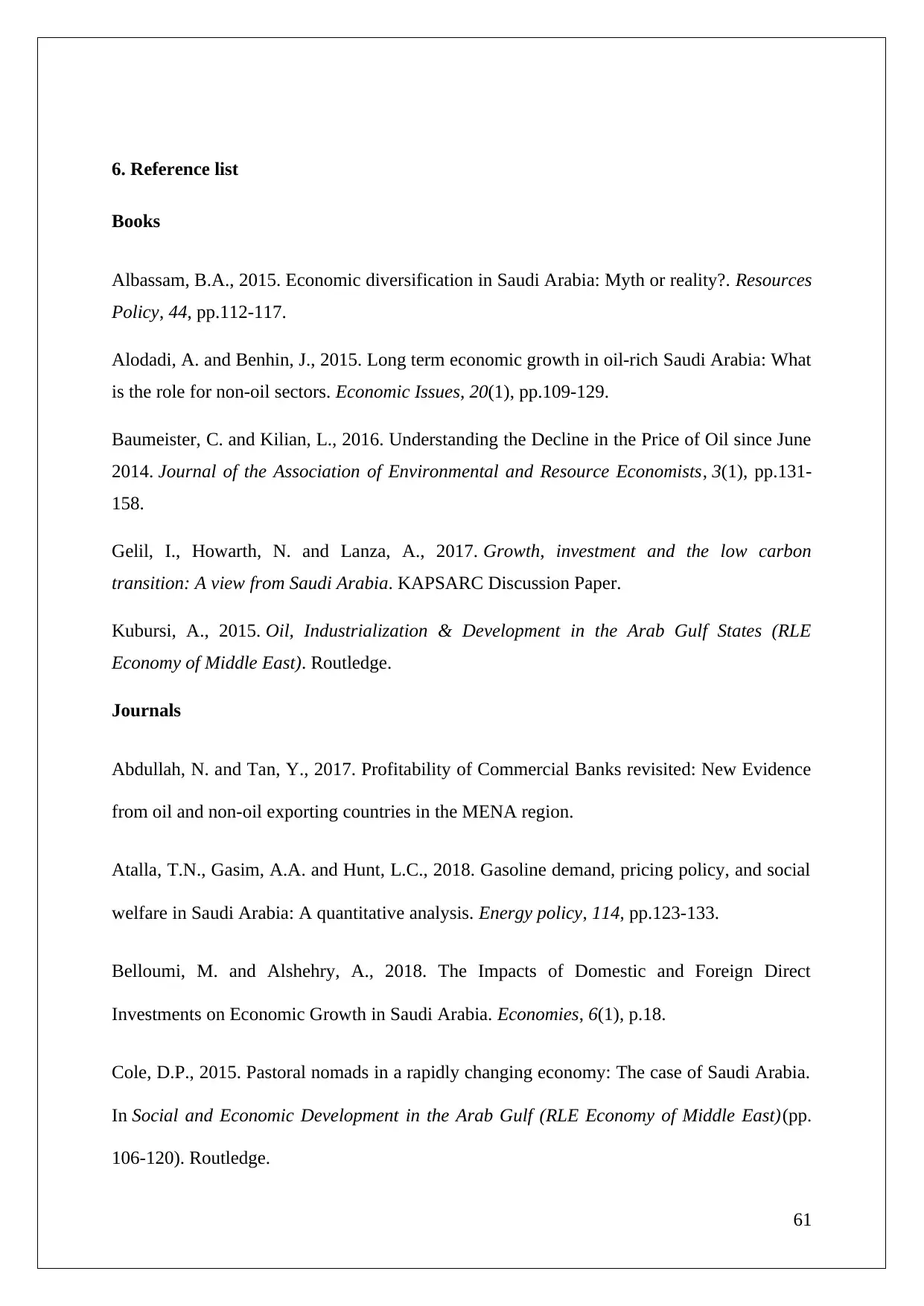
6. Reference list
Books
Albassam, B.A., 2015. Economic diversification in Saudi Arabia: Myth or reality?. Resources
Policy, 44, pp.112-117.
Alodadi, A. and Benhin, J., 2015. Long term economic growth in oil-rich Saudi Arabia: What
is the role for non-oil sectors. Economic Issues, 20(1), pp.109-129.
Baumeister, C. and Kilian, L., 2016. Understanding the Decline in the Price of Oil since June
2014. Journal of the Association of Environmental and Resource Economists, 3(1), pp.131-
158.
Gelil, I., Howarth, N. and Lanza, A., 2017. Growth, investment and the low carbon
transition: A view from Saudi Arabia. KAPSARC Discussion Paper.
Kubursi, A., 2015. Oil, Industrialization & Development in the Arab Gulf States (RLE
Economy of Middle East). Routledge.
Journals
Abdullah, N. and Tan, Y., 2017. Profitability of Commercial Banks revisited: New Evidence
from oil and non-oil exporting countries in the MENA region.
Atalla, T.N., Gasim, A.A. and Hunt, L.C., 2018. Gasoline demand, pricing policy, and social
welfare in Saudi Arabia: A quantitative analysis. Energy policy, 114, pp.123-133.
Belloumi, M. and Alshehry, A., 2018. The Impacts of Domestic and Foreign Direct
Investments on Economic Growth in Saudi Arabia. Economies, 6(1), p.18.
Cole, D.P., 2015. Pastoral nomads in a rapidly changing economy: The case of Saudi Arabia.
In Social and Economic Development in the Arab Gulf (RLE Economy of Middle East)(pp.
106-120). Routledge.
61
Books
Albassam, B.A., 2015. Economic diversification in Saudi Arabia: Myth or reality?. Resources
Policy, 44, pp.112-117.
Alodadi, A. and Benhin, J., 2015. Long term economic growth in oil-rich Saudi Arabia: What
is the role for non-oil sectors. Economic Issues, 20(1), pp.109-129.
Baumeister, C. and Kilian, L., 2016. Understanding the Decline in the Price of Oil since June
2014. Journal of the Association of Environmental and Resource Economists, 3(1), pp.131-
158.
Gelil, I., Howarth, N. and Lanza, A., 2017. Growth, investment and the low carbon
transition: A view from Saudi Arabia. KAPSARC Discussion Paper.
Kubursi, A., 2015. Oil, Industrialization & Development in the Arab Gulf States (RLE
Economy of Middle East). Routledge.
Journals
Abdullah, N. and Tan, Y., 2017. Profitability of Commercial Banks revisited: New Evidence
from oil and non-oil exporting countries in the MENA region.
Atalla, T.N., Gasim, A.A. and Hunt, L.C., 2018. Gasoline demand, pricing policy, and social
welfare in Saudi Arabia: A quantitative analysis. Energy policy, 114, pp.123-133.
Belloumi, M. and Alshehry, A., 2018. The Impacts of Domestic and Foreign Direct
Investments on Economic Growth in Saudi Arabia. Economies, 6(1), p.18.
Cole, D.P., 2015. Pastoral nomads in a rapidly changing economy: The case of Saudi Arabia.
In Social and Economic Development in the Arab Gulf (RLE Economy of Middle East)(pp.
106-120). Routledge.
61
Paraphrase This Document
Need a fresh take? Get an instant paraphrase of this document with our AI Paraphraser
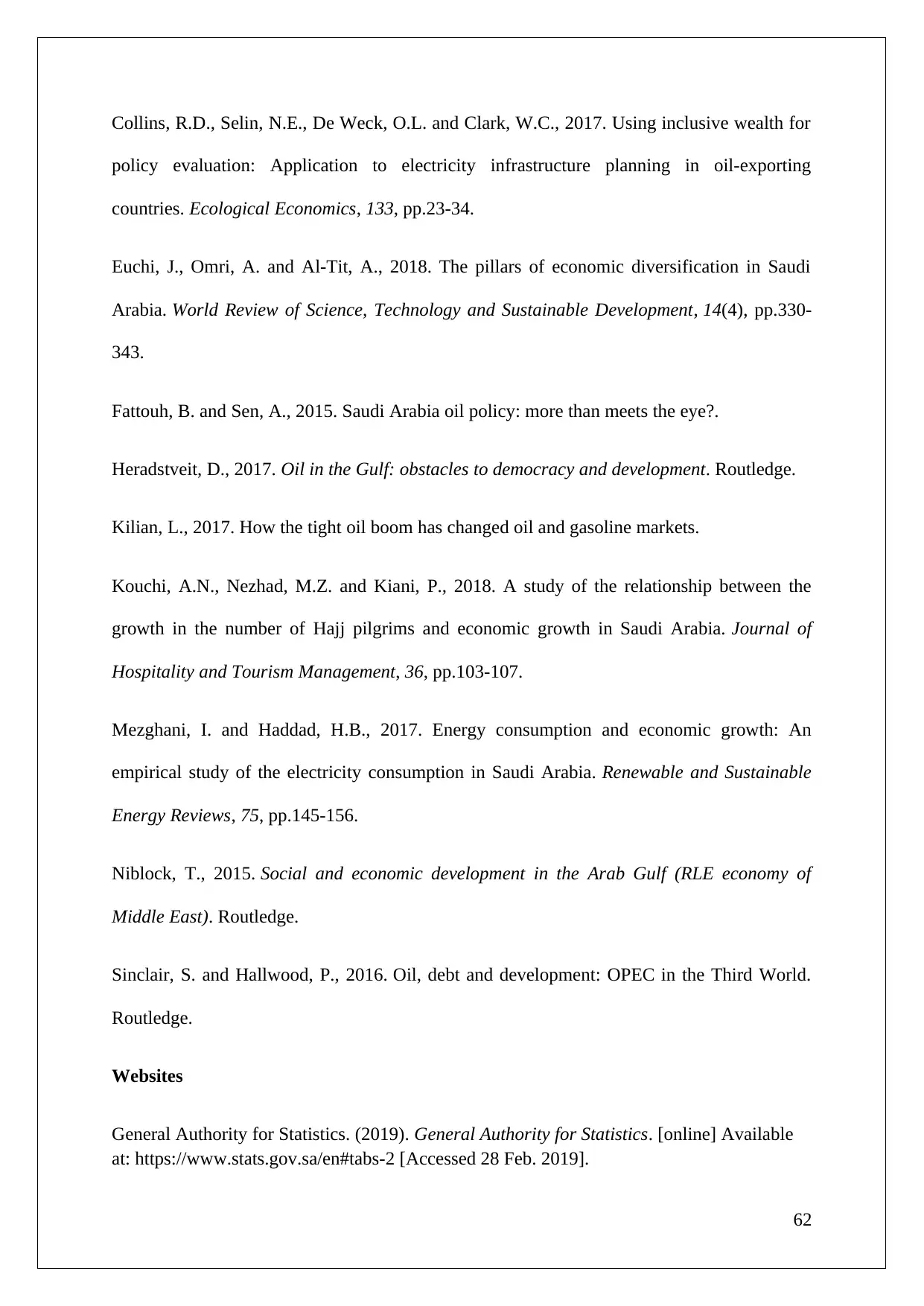
Collins, R.D., Selin, N.E., De Weck, O.L. and Clark, W.C., 2017. Using inclusive wealth for
policy evaluation: Application to electricity infrastructure planning in oil-exporting
countries. Ecological Economics, 133, pp.23-34.
Euchi, J., Omri, A. and Al-Tit, A., 2018. The pillars of economic diversification in Saudi
Arabia. World Review of Science, Technology and Sustainable Development, 14(4), pp.330-
343.
Fattouh, B. and Sen, A., 2015. Saudi Arabia oil policy: more than meets the eye?.
Heradstveit, D., 2017. Oil in the Gulf: obstacles to democracy and development. Routledge.
Kilian, L., 2017. How the tight oil boom has changed oil and gasoline markets.
Kouchi, A.N., Nezhad, M.Z. and Kiani, P., 2018. A study of the relationship between the
growth in the number of Hajj pilgrims and economic growth in Saudi Arabia. Journal of
Hospitality and Tourism Management, 36, pp.103-107.
Mezghani, I. and Haddad, H.B., 2017. Energy consumption and economic growth: An
empirical study of the electricity consumption in Saudi Arabia. Renewable and Sustainable
Energy Reviews, 75, pp.145-156.
Niblock, T., 2015. Social and economic development in the Arab Gulf (RLE economy of
Middle East). Routledge.
Sinclair, S. and Hallwood, P., 2016. Oil, debt and development: OPEC in the Third World.
Routledge.
Websites
General Authority for Statistics. (2019). General Authority for Statistics. [online] Available
at: https://www.stats.gov.sa/en#tabs-2 [Accessed 28 Feb. 2019].
62
policy evaluation: Application to electricity infrastructure planning in oil-exporting
countries. Ecological Economics, 133, pp.23-34.
Euchi, J., Omri, A. and Al-Tit, A., 2018. The pillars of economic diversification in Saudi
Arabia. World Review of Science, Technology and Sustainable Development, 14(4), pp.330-
343.
Fattouh, B. and Sen, A., 2015. Saudi Arabia oil policy: more than meets the eye?.
Heradstveit, D., 2017. Oil in the Gulf: obstacles to democracy and development. Routledge.
Kilian, L., 2017. How the tight oil boom has changed oil and gasoline markets.
Kouchi, A.N., Nezhad, M.Z. and Kiani, P., 2018. A study of the relationship between the
growth in the number of Hajj pilgrims and economic growth in Saudi Arabia. Journal of
Hospitality and Tourism Management, 36, pp.103-107.
Mezghani, I. and Haddad, H.B., 2017. Energy consumption and economic growth: An
empirical study of the electricity consumption in Saudi Arabia. Renewable and Sustainable
Energy Reviews, 75, pp.145-156.
Niblock, T., 2015. Social and economic development in the Arab Gulf (RLE economy of
Middle East). Routledge.
Sinclair, S. and Hallwood, P., 2016. Oil, debt and development: OPEC in the Third World.
Routledge.
Websites
General Authority for Statistics. (2019). General Authority for Statistics. [online] Available
at: https://www.stats.gov.sa/en#tabs-2 [Accessed 28 Feb. 2019].
62
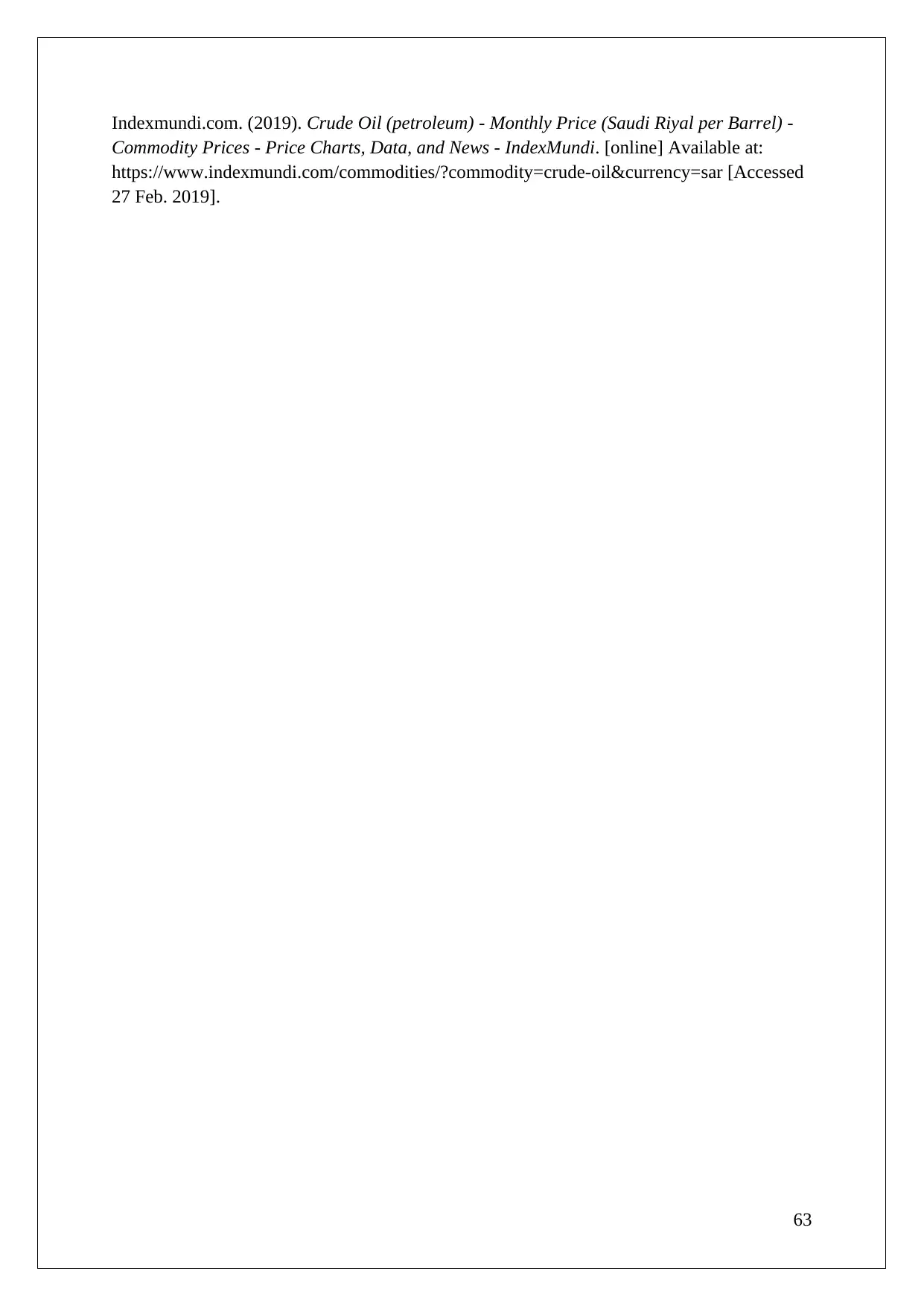
Indexmundi.com. (2019). Crude Oil (petroleum) - Monthly Price (Saudi Riyal per Barrel) -
Commodity Prices - Price Charts, Data, and News - IndexMundi. [online] Available at:
https://www.indexmundi.com/commodities/?commodity=crude-oil¤cy=sar [Accessed
27 Feb. 2019].
63
Commodity Prices - Price Charts, Data, and News - IndexMundi. [online] Available at:
https://www.indexmundi.com/commodities/?commodity=crude-oil¤cy=sar [Accessed
27 Feb. 2019].
63
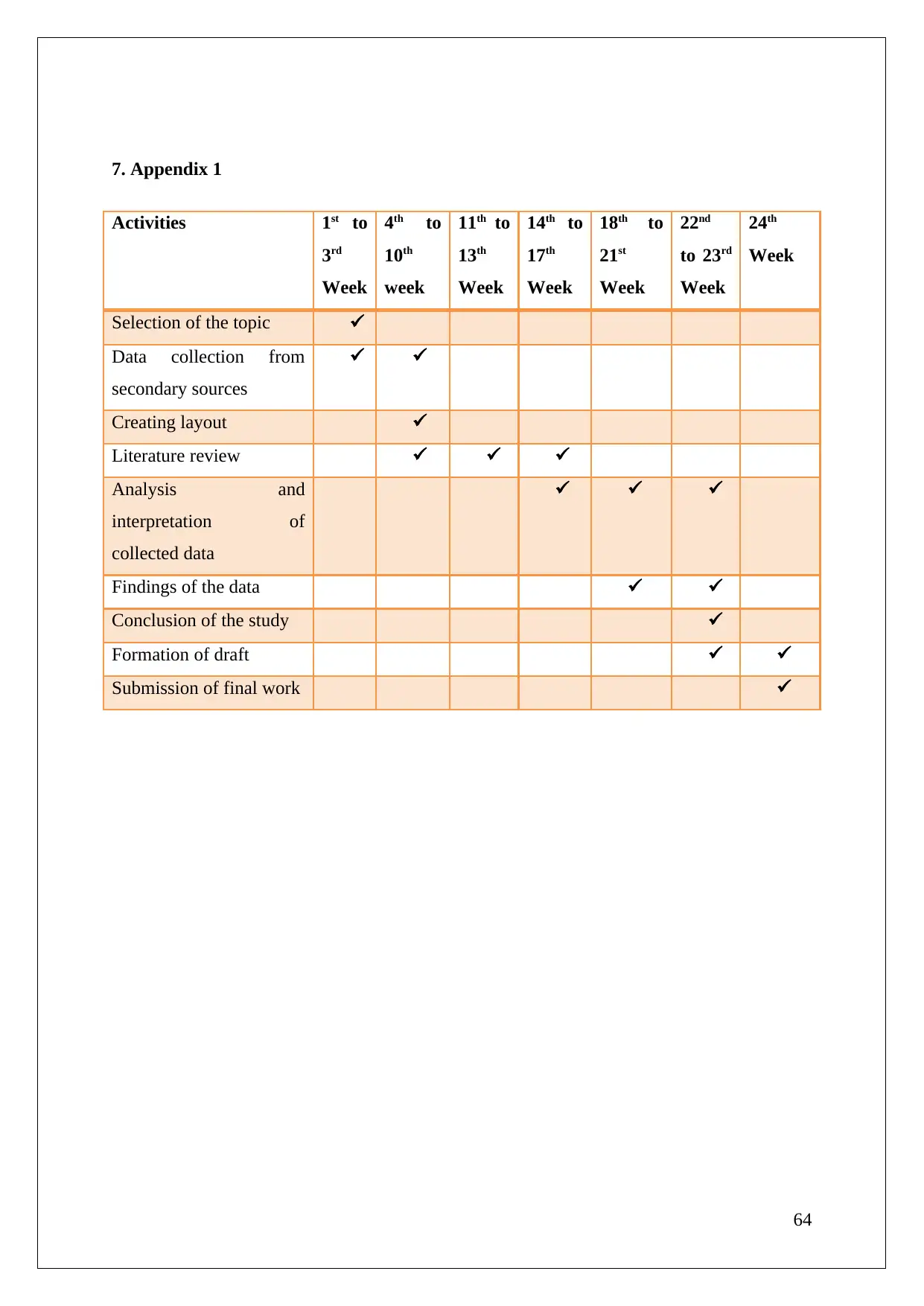
7. Appendix 1
Activities 1st to
3rd
Week
4th to
10th
week
11th to
13th
Week
14th to
17th
Week
18th to
21st
Week
22nd
to 23rd
Week
24th
Week
Selection of the topic
Data collection from
secondary sources
Creating layout
Literature review
Analysis and
interpretation of
collected data
Findings of the data
Conclusion of the study
Formation of draft
Submission of final work
64
Activities 1st to
3rd
Week
4th to
10th
week
11th to
13th
Week
14th to
17th
Week
18th to
21st
Week
22nd
to 23rd
Week
24th
Week
Selection of the topic
Data collection from
secondary sources
Creating layout
Literature review
Analysis and
interpretation of
collected data
Findings of the data
Conclusion of the study
Formation of draft
Submission of final work
64
1 out of 64
Your All-in-One AI-Powered Toolkit for Academic Success.
+13062052269
info@desklib.com
Available 24*7 on WhatsApp / Email
![[object Object]](/_next/static/media/star-bottom.7253800d.svg)
Unlock your academic potential
© 2024 | Zucol Services PVT LTD | All rights reserved.



